Encyclopedia
4th Avenue Parking Garage (OSU-Stillwater)
The 4th Avenue Parking Garage at Oklahoma State University is a designated parking facility serving students, faculty, staff and visitors. It is located at 720 W. 4th Ave. on the Stillwater campus and provides convenient access to various university buildings and events, such as The McKnight Center for the Performing Arts and the Michael and Anne Greenwood School of Music.
Built in 2016, the garage operates with a permit system, requiring specific permits for different parking zones within the facility. It also features metered parking options for short-term visitors.
Academic Classification
When referring to an undergraduate student's classification, use the terms freshman, sophomore, junior and senior.
As for the classification of a student in graduate school, refer to them as a graduate student. When referring to the classification of a student pursuing a doctoral degree, refer to them as a doctoral student or a doctoral candidate for a student who has completed all coursework and comprehensive examinations and is working on a dissertation.
The exception to the above rule for graduate students is when referring to the classification
of a student in the College of Veterinary Medicine and Center for Health Sciences.
In this instance, refer to them as first-year, second-year or third-year veterinary
or medical students. Also, the School of Architecture refers to its students as first-year
through fifth-year students.
Example: Jane Doe earned her bachelor’s degree in mechanical engineering from Oklahoma State University and is now a second-year MBA student in the Spears School of Business.
Example: John Doe transferred to Oklahoma State University as a junior and plans to graduate with a degree in agribusiness.
Example: Jane Doe is a freshman enrolled in Oklahoma State University’s Honors College and plans to double major in psychology and sociology.
Academic Degrees
For faculty, degrees are not used after a person’s name. The person’s specialty should be stated in the first or second reference. Using the last name alone is acceptable after the first reference.
Example: Jane Doe will give a presentation on the periodic table. Doe is an assistant professor in the Oklahoma State University Department of Chemistry.
Example: Jane Doe, an assistant professor in the Oklahoma State University Department of Chemistry, will give a presentation on the periodic table.
Do not use Doctor or Dr. unless the person has a doctoral degree.
As an exception to AP Style, OSU gives the title of doctor to anyone with a doctoral degree. If unsure, check the person’s academic resume to see their degrees earned.
For undergraduate or graduate students, capitalize when the full degree designation is used after a person’s name. Do not capitalize when referring to the generic degree title.
Use abbreviations only when the need to identify several individuals by degree on first reference would make the preferred form cumbersome. Use abbreviations only after a full name, never after a last name. When abbreviations are used, always include periods and offset from the name by a comma.
Example: John Doe earned his Bachelor of Arts in Chemistry on Tuesday.
Example: John Doe earned his bachelor’s degree on Tuesday.
Example: The lecture Tuesday will be conducted by John Doe, B.A.
Academic degrees include:
- AA: Associate of Arts
- AS: Associate of Science
- AAS: Associate of Applied Science
- BA: Bachelor of Arts
- BS: Bachelor of Science
- BAA: Bachelor of Applied Arts
- BAS: Bachelor of Applied Science
- B.Arch.: Bachelor of Architecture
- BBA: Bachelor of Business Administration
- BFA: Bachelor of Fine Arts
- BPS: Bachelor of Professional Studies
- BSN: Bachelor of Science in Nursing
- LL.M.: Master of Laws
- MA: Master of Arts
- MS: Master of Science
- MBA: Master of Business Administration
- M.Ed.: Master of Education
- MFA: Master of Fine Arts
- MM: Master of Music
- MPA: Master of Public Administration
- MPH: Master of Public Health
- MPP: Master of Public Policy
- MSN: Master of Science in Nursing
- MSW: Master of Social Work
- DBA: Doctor of Business Administration
- DDS: Doctor of Dental Surgery
- DNP: Doctor of Nursing Practice
- DO: Doctorate of Osteopathic Medicine
- DVM: Doctorate of Veterinary Medicine
- Ed.D.: Doctor of Education
- J.D.: Juris Doctor (law)
- MD: Doctor of Medicine
- Ph.D.: Doctor of Philosophy
- Pharm.D.: Doctor of Pharmacy
- Psy.D.: Doctor of Psychology
Adams Market (OSU-Stillwater)
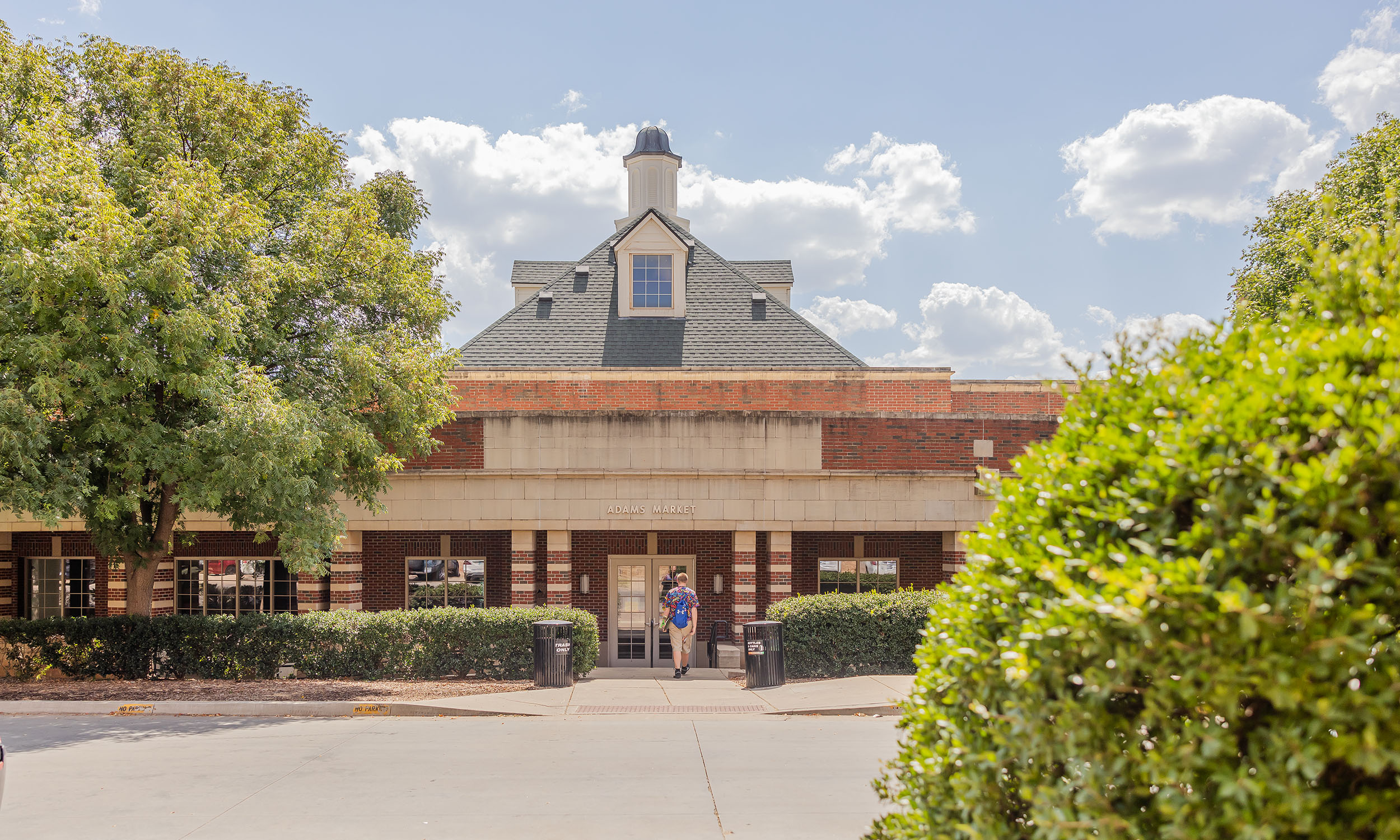
Adams Market is a popular dining location at Oklahoma State University-Stillwater, situated off Hall of Fame Avenue and Monroe Street near North Dining.
It offers a variety of grab-and-go items, snacks and campus-living necessities, making it a convenient spot for students and staff alike. Built in 2003, the market is known for its quick evening snacks and college favorites.
It is named after Arthur Wesley Adams (Aug. 4, 1872-Dec. 17, 1939) and James Homer Adams (Dec. 21, 1877-Jan. 27, 1950), brothers who were members of the first graduating class of then Oklahoma Agricultural and Mechanical College on June 10, 1896. James Adams was the first OAMC enrollee and Arthur Adams was the first graduate.
With its central location and diverse offerings, Adams Market plays a vital role in the daily lives of the OSU community, providing easy access to essential food and beverage options.
Administration Building (OSU-OKC)
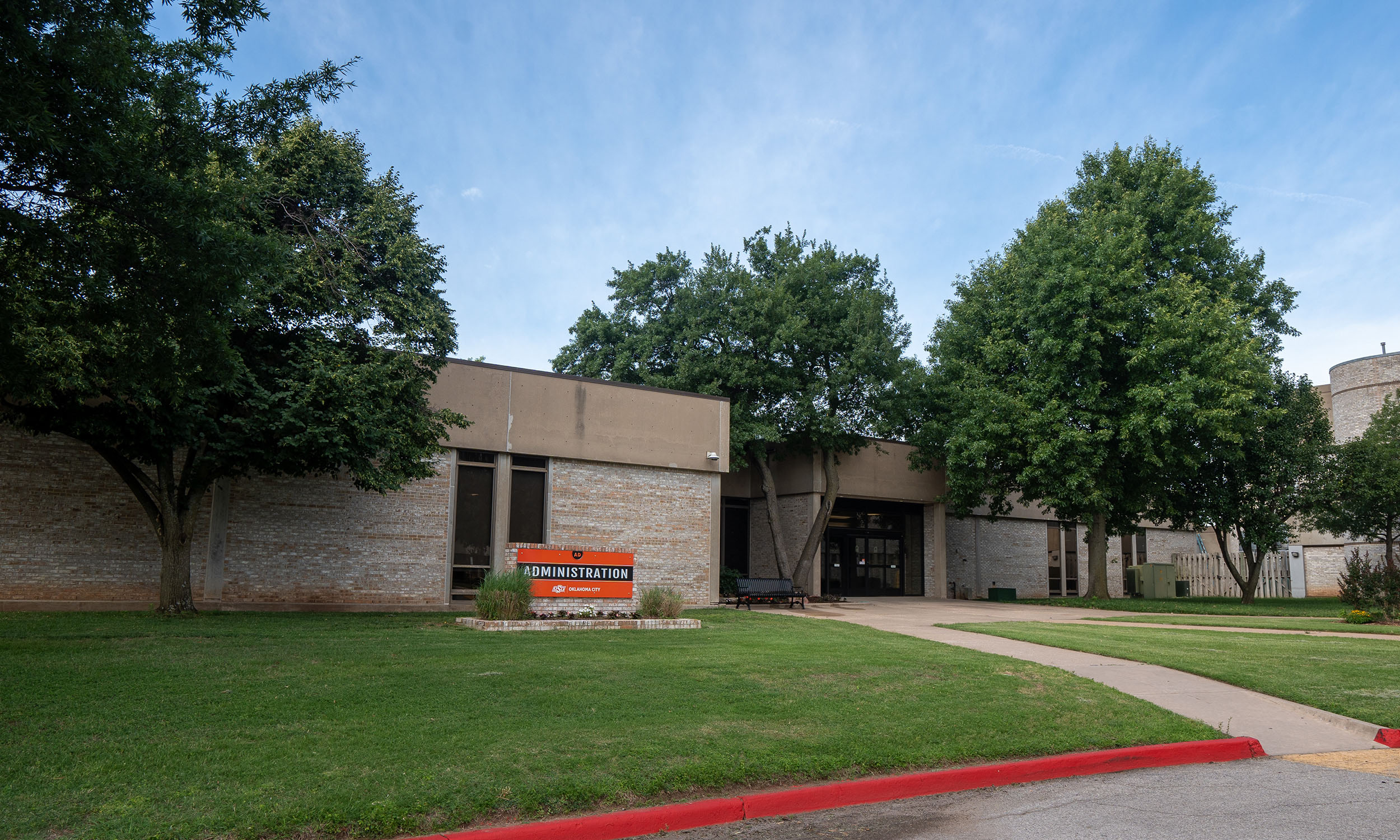
The Administration Building at Oklahoma State University-Oklahoma City is a central facility crucial to the university's operations.
It houses various administrative offices, including those of the university's leadership team. The building is strategically located at the heart of campus, making it easily accessible to students, faculty and visitors. Built in 1979, the Administration Building is also close to other important campus facilities, such as the Student Center and several classroom buildings.
This building reflects OSU-OKC's commitment to providing a supportive and efficient administrative environment to enhance the overall educational experience.
Advanced Technology Research Center (OSU-Stillwater)

The Advanced Technology Research Center at Oklahoma State University-Stillwater is a hub for cutting-edge research and innovation within the College of Engineering, Architecture and Technology.
The ATRC houses state-of-the-art facilities, including the Ultrafast THz Optoelectronic Laboratory, which occupies approximately 3,000 square feet and features a class 1000 cleanroom, teaching studio and various specialized labs.
Completed in 1997, the ATRC supports various research activities, from advanced manufacturing and robotics to drone technology and data analytics, providing graduate and undergraduate students with hands-on learning experiences.
Located adjacent to Engineering North and Engineering South, the ATRC fosters collaboration between faculty, students and industry partners, driving technological advancements and contributing to Oklahoma's economic development.
FIRST REFERENCE: Use the full name "Advanced Technology Research Center."
SECOND REFERENCE: For all subsequent references, it is acceptable to use the term "ATRC."
Aerospace Systems Discovery Laboratory (OSU-Stillwater)
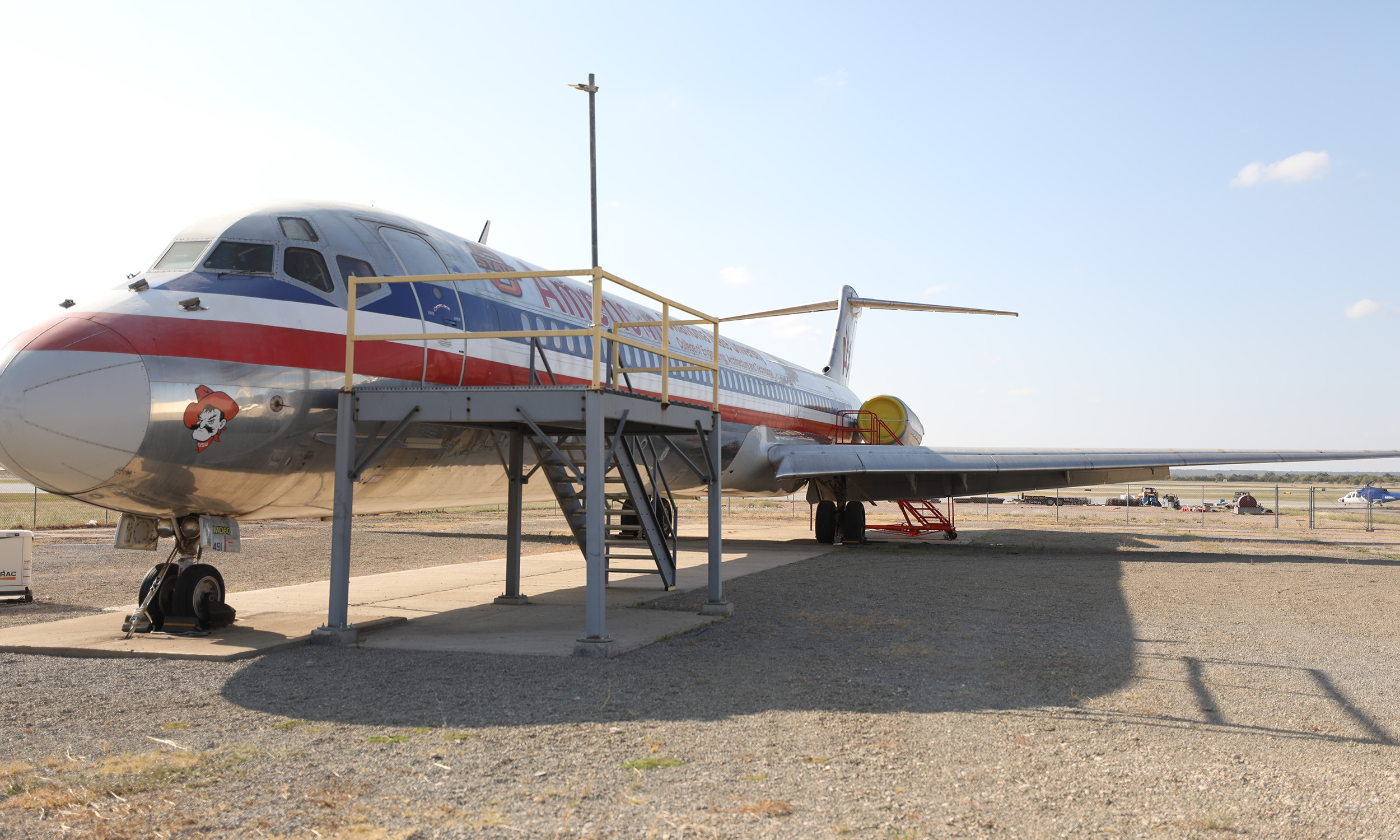
The Aerospace Systems Discovery Lab at Oklahoma State University is a School of Mechanical and Aerospace Engineering project.
Established in 2019, the lab partners with various university departments, schools, industry and other organizations to develop and share learning opportunities for students of all ages. Located at Stillwater Regional Airport, the ASDL focuses on inspiring future leaders through hands-on learning with real-world systems, providing a platform for students to engage in science, technology, engineering and math learning.
The lab's mission includes arranging lab visits, participating in learning events and supporting lab development, making it a vital resource for aerospace education and research at OSU.
FIRST REFERENCE: Use full name "Aerospace Systems Discovery Laboratory."
SECOND REFERENCE: For all subsequent references, it is acceptable to use the term "ASDL."
Agricultural Hall (OSU-Stillwater)
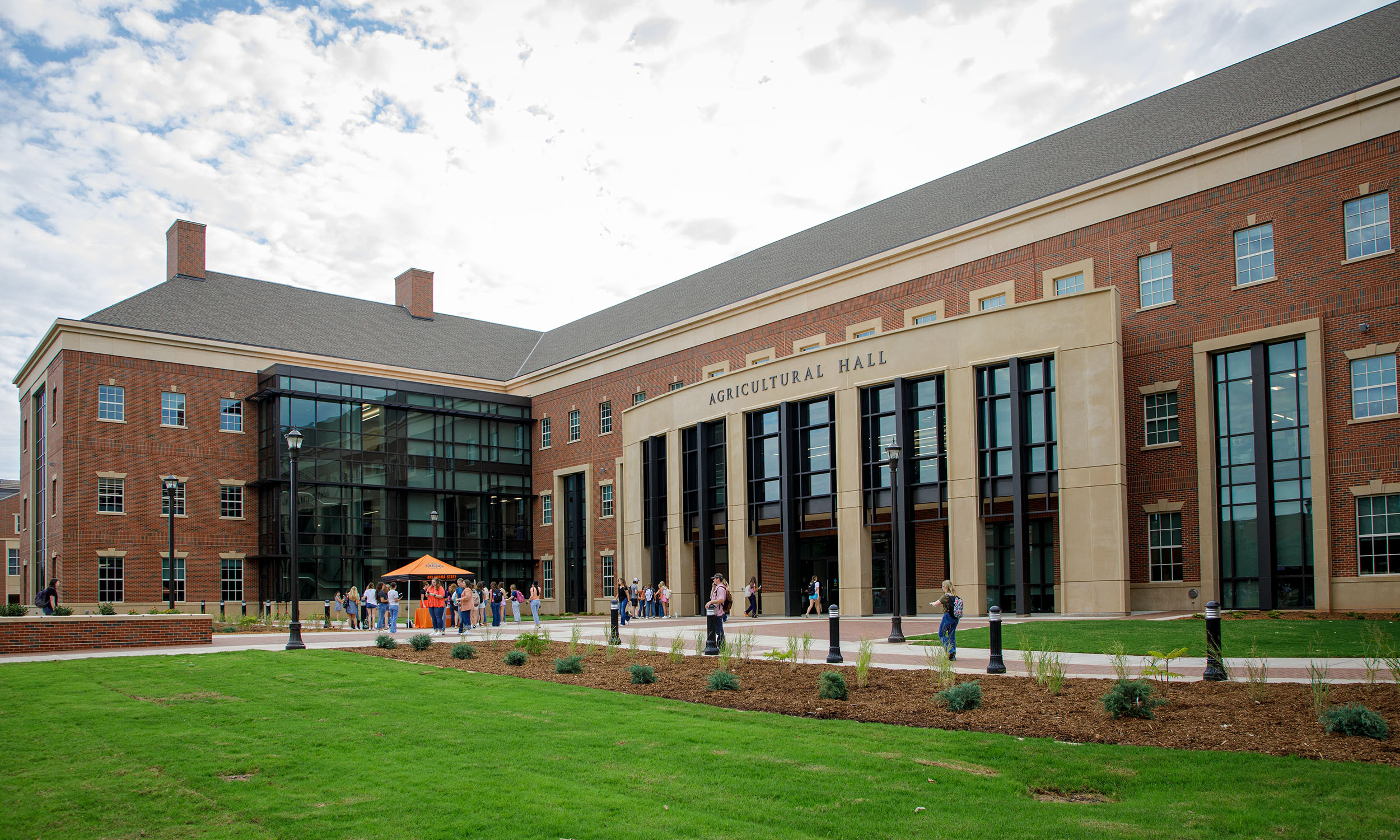
Agricultural Hall at Oklahoma State University is a state-of-the-art facility that is home to the Ferguson College of Agriculture, OSU Ag Research and OSU Extension.
Completed in July 2024 after a three-year construction process, the building embodies the university's land-grant mission of teaching, research and extension. It is located at the northeastern corner of Farm Road and Monroe Street in Stillwater. The New Frontiers campaign, launched in January 2020, was crucial in funding and building this modern facility.
The hall features cutting-edge research laboratories, advanced teaching classrooms and collaborative spaces, fostering an enhanced sense of community and providing numerous opportunities for students, faculty and staff. The dedication ceremony on Oct. 5, 2024, marked the completion of this significant project, celebrating the advancements in agricultural education and research at OSU.
Agronomy Farm (OSU-Stillwater)
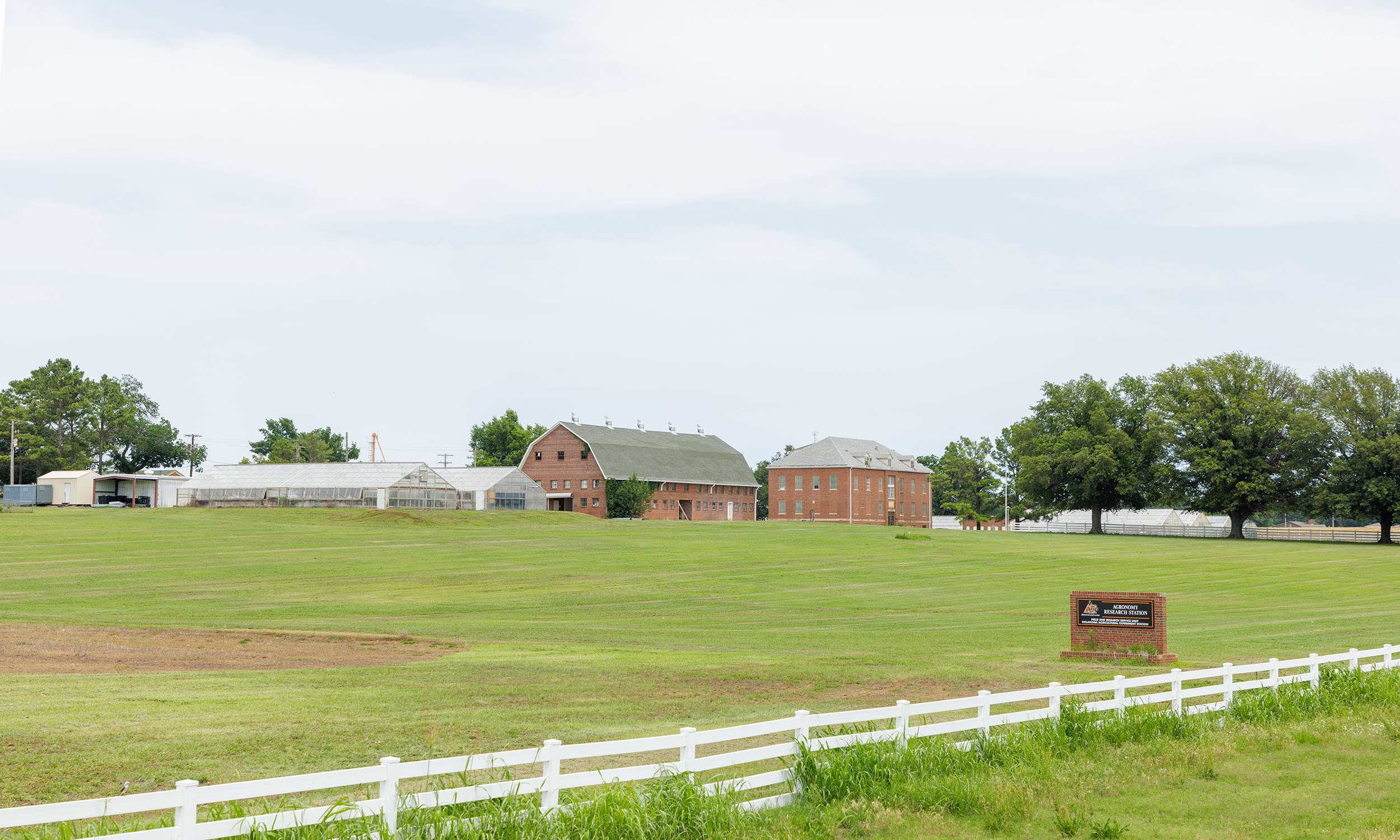
The Agronomy Farm at Oklahoma State University, also known as the Agronomy Research Station, is a vital hub for multidisciplinary and multi-departmental agricultural research.
Located in Stillwater, the farm spans over 900 acres across three separate locations, including the primary station at the corner of 6th Avenue and Western Road, the Entomological Livestock Research Facility site and the Lake Carl Blackwell location. Built in 1975, the farm is renowned for its significant contributions to wheat breeding, grass breeding, soil fertility, weed science and forage research. It also houses the historic Magruder Plots, listed in the Federal Register of Historic Places.
The Agronomy Farm supports OSU's mission to advance agricultural knowledge and practices through state-of-the-art research and community outreach.
Air Conditioning and Refrigeration Technology Building (OSUIT)
The Air Conditioning and Refrigeration Technology Building at Oklahoma State University Institute of Technology is a state-of-the-art facility that provides hands-on, industry-standard training in heating, ventilation, air conditioning and refrigeration systems.
Built in 1947, it houses advanced laboratory environments where students gain practical experience with the latest technology and equipment used in the HVACR industry. Located at the corner of Covelle Drive and 2nd Street, OSUIT's Air Conditioning and Refrigeration Technology program is designed to prepare students for various career paths, including HVAC technician, refrigeration technician and systems engineer, by combining theoretical instruction with practical applications and internship opportunities.
The program's strong industry connections and experienced faculty ensure that graduates are well-equipped to meet the demands of the modern workforce.
Alexander Hall (OSUIT)
Alexander Hall at Oklahoma State University Institute of Technology is a residential facility that provides student housing.
Located off of Willham Drive, the hall is divided into two sections, Alexander Hall North and Alexander Hall South, each offering 48 beds. The housing options include two-room suite-style apartments designed to accommodate both family and non-traditional students. Built in 2001, Alexander Hall is part of OSUIT's commitment to creating a supportive and convenient living environment for its students, ensuring they have access to the resources and amenities needed for academic success.
Alexander Hall is named in honor of Dr. Robert Lin Alexander Sr. (Sept. 14, 1910-May 23, 1972). This recognition cites his service as the founding chief physician from 1947-72. Alexander Sr. was known for his dedication to patient care and commitment to the OSUIT community.
The Alexander family has a long history at OSUIT; Dr. Lin Alexander (March 23, 1874-Nov. 12, 1963) began his service in 1903, with his son, Robert Alexander Sr., taking the helm. His grandchildren, Drs. Tom Alexander and Robert Alexander Jr. (July 8, 1936-Jan. 20, 2023) also went into medicine. Tom worked on the OSUIT campus for 40 years.
Allergen Extraction Research and Shelter (OSU-Stillwater)
The Allergen Extraction Research and Shelter at Oklahoma State University is a specialized facility dedicated to studying and extracting allergens.
Built in 2016, this facility supports research to understand allergens and develop methods to mitigate their impact on health. Located west of Stillwater on Range Road, it is part of the university's commitment to advancing scientific knowledge and improving public health through innovative research and practical applications.
Allie P. Reynolds Stadium (OSU-Stillwater)
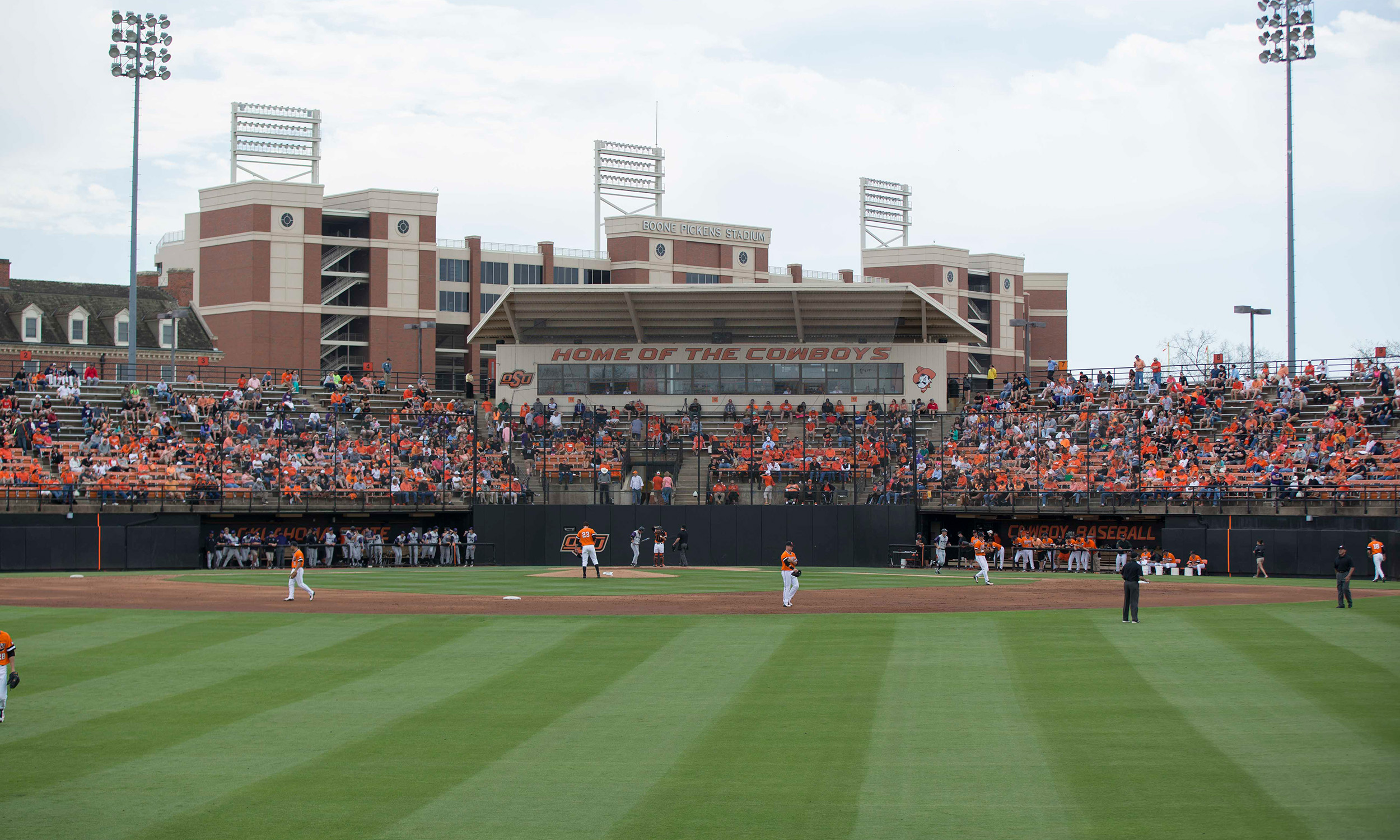
Allie P. Reynolds Stadium is a former baseball park located on the campus of Oklahoma State University in Stillwater.
Named after the former OSU and New York Yankees baseball great Allie Pierce Reynolds (Feb. 10, 1917-Dec. 26, 1994), the stadium served as the home field for the Cowboy baseball team from its opening on April 4, 1981, until its closure in March 2020. The stadium had a seating capacity of 3,821 and featured a grass playing surface. Over the years, it underwent several renovations, including expanded seating, new perimeter fences and modernized facilities.
The stadium hosted nine NCAA Regional tournaments and was known for its vibrant atmosphere and rich history in college baseball.
Allied Health Building (OSU-OKC)
The Allied Health Building at Oklahoma State University-Oklahoma City is a key facility that houses the School of Health Sciences, which offers programs in Nurse Science, Health Care Management, Diagnostic Cardiovascular Sonography, Radiologic Technology, Paramedicine and Veterinary Technology.
Located at the corner of N. Portland Avenue and Black Gold Drive, the Allied Health Building has modern classrooms, labs and simulation areas, ensuring students have hands-on learning experiences. Built in 2016, this facility reflects OSU-OKC's commitment to workforce development and serving the health care needs of Oklahoma and beyond.
Allied Health Sciences Center (OSUIT)
The Allied Health Sciences Center at Oklahoma State University Institute of Technology is a premier facility that provides comprehensive education and training in various health science disciplines.
Built in 2009, the center offers an Associate in Science in Allied Health Sciences program, which prepares students for careers in physical therapy, occupational therapy, nursing and more. The program combines rigorous coursework with practical learning opportunities, ensuring students are well-equipped to meet the demands of real-world health care environments. OSUIT's commitment to excellence in health sciences education is reflected in its state-of-the-art facilities and strong industry partnerships.
Alma Mater
The Oklahoma State University alma mater, penned by Robert Leroy McCulloh (Nov. 21, 1924-Oct. 29, 2008), has been a cherished tradition at OSU for over 50 years.
McCulloh, who graduated from Oklahoma A&M College in 1949 with a degree in journalism and a minor in music, composed the alma mater when the school changed its name to Oklahoma State University. His piece was selected by a committee of alumni, faculty and students from a contest on campus.
The lyrics are:
"Proud and immortal, bright shines your name;
Oklahoma State, we herald your fame!
Ever you’ll find us, loyal and true;
To our Alma Mater, O-S-U!"
Alvord, Henry Elijah
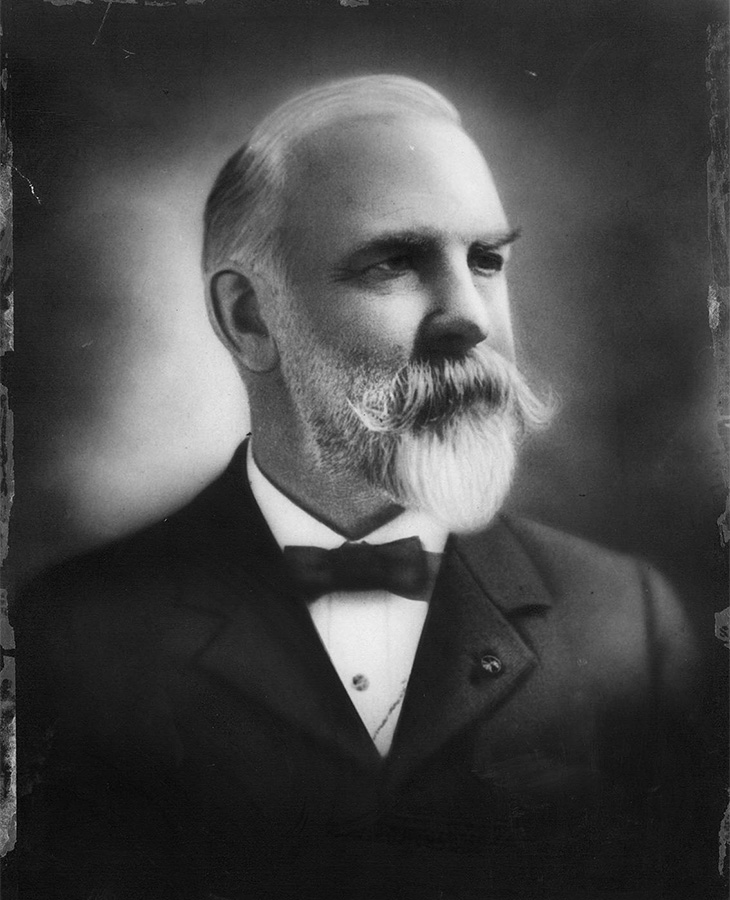 Henry Elijah Alvord (March 11, 1844-Oct. 1, 1904) served as the second president of
Oklahoma Agricultural and Mechanical College (now Oklahoma State University) from
1894-95.
Henry Elijah Alvord (March 11, 1844-Oct. 1, 1904) served as the second president of
Oklahoma Agricultural and Mechanical College (now Oklahoma State University) from
1894-95.
He attended Norwich University in Vermont before enlisting in the Union Army in the Civil War, where he eventually attained the rank of major. Alvord was also the director of the Agricultural Experiment Station during his tenure at OAMC. Alvord is credited with conducting a thorough analysis, reorganization and reform of the college, which laid the groundwork for its future development.
After his presidency, he left to lead the dairy division in the U.S. Department of Agriculture. He lectured and published extensively before dying while preparing an exhibit at the World’s Fair in St. Louis. He was 60.
Anaplasmosis Building (OSU-Stillwater)
The Anaplasmosis Building at Oklahoma State University is a specialized facility dedicated to researching and studying anaplasmosis, a common disease in cattle with worldwide distribution.
Built in 1938, it is part of the university's commitment to advancing veterinary medicine and agricultural sciences. The research conducted there has led to significant breakthroughs, including developing the first successful vaccine against anaplasmosis in cattle in 1965.
Located at the corner of Marvista Street and Virginia Avenue in Stillwater, the Anaplasmosis Building supports the university's mission to improve animal health and agricultural productivity through innovative research and practical applications.
Animal Science Building (OSU-Stillwater)

The Animal Science Building at Oklahoma State University is the central hub for the Department of Animal and Food Sciences.
Located at the corner of Hall of Fame Avenue and Monroe Street on the Stillwater campus, it houses faculty offices, 14 research laboratories, computer labs and classrooms with seating capacities of 220, 108 and 40 students. The research labs cover various fields, including physiology, food science, genetics, dairy microbiology, meat science, non-ruminant nutrition, ruminant nutrition and general nutrition.
Completed in 1982, the facility supports the academic and research activities of the animal and food science programs, fostering an environment of innovation and learning for students and faculty alike.
Arts and Sciences (College of)
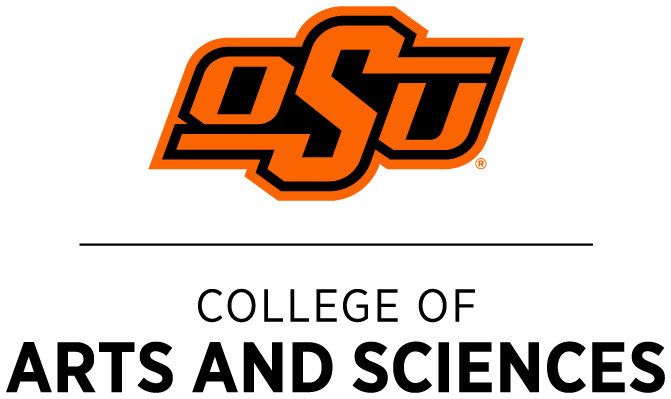
The College of Arts and Sciences is Oklahoma State University's largest and most academically diverse college.
Home to 24 departments, CAS offers more than 150 undergraduate and graduate degree options in the arts, humanities, social sciences, mathematics and natural sciences. The college provides general education courses to nearly every OSU student, as well as resources such as the Mathematics Learning Success Center and the OSU Writing Center. Dean Melinda Cro, the college’s first female dean, came to OSU in 2024.
The official magazine of CAS is CONNECT.
The CAS Dean’s Office is at 201 Life Sciences East.
The college houses the following departments, schools and units:
- Department of Aerospace Studies (including Air Force ROTC)
- Department of Art, Graphic Design and Art History
- Boone Pickens School of Geology (BPSoG)
- Department of Chemistry
- Department of Communication Sciences and Disorders (CDIS)
- Department of Computer Science
- Department of English
- Department of Geography
- Greenwood School of Music (GSM)
- Department of History
- Department of Integrative Biology
- Department of Languages and Literatures
- Department of Mathematics
- Department of Microbiology and Molecular Genetics
- Department of Military Science (including Army ROTC)
- Department of Philosophy
- Department of Physics
- Department of Plant Biology, Ecology and Evolution
- Department of Political Science
- Department of Psychology
- School of Media and Strategic Communications (SMSC)
- Department of Sociology
- Department of Statistics
- Department of Theatre
- Center for Africana Studies
- Center for the Humanities
Note: Always use the full name of the college and each subsequent department on first reference. When writing the college’s name or department's name, spell out “and.” Do not use an ampersand (&) unless it is part of the official name of an institution. When referencing a department for the first time, always use ‘Department of’ prior to the department.
FIRST REFERENCE: Use full name "College of Arts and Sciences."
SECOND REFERENCE: For all subsequent references, it is acceptable to use the term "CAS."
A.R. and Marylouise Tandy Medical Academic Building (OSU-CHS)
The A.R. and Marylouise Tandy Medical Academic Building at Oklahoma State University Center for Health Sciences is a state-of-the-art facility that opened in 2017.
This building features active learning classrooms, spacious lecture halls, and the state's largest and most technologically advanced hospital simulation center. It also includes student support areas, a conference center and various specialized suites such as the Melton Family Surgical Suite and the Osteopathic Founders Foundation ICU Suite.
It is named after Alfred Randolph "Bill" (Aug. 19, 1921-Feb. 15, 1971) and Marylouise Tandy (Dec. 3, 1921-March 28, 2009). Bill Tandy was a director of Tandy Corp., a company known for its diversified retail holdings, including the RadioShack chain of electronics stores. Marylouise Tandy was an artist and philanthropist who, along with Bill, made significant contributions to various educational and community initiatives.
The Tandy Foundation donated $8 million to support the construction of the building, marking the largest private gift ever received by OSU-CHS. It is located along Southwest Boulevard on the OSU-CHS campus in Tulsa.
The Tandy Medical Academic Building reflects OSU-CHS' commitment to providing cutting-edge medical education and training, supporting the development of future health care professionals.
Atherton Hotel (OSU-Stillwater)
The Atherton Hotel at Oklahoma State University is a historic Georgian boutique hotel.
Initially opened in 1950 as the Union Club, the Atherton Hotel is conveniently located in the heart of the Stillwater campus. It is named after William S. Atherton, an OSU graduate who led the $6 million restoration effort in the early 2000s.
Known for its stately tradition and modern elegance, the Atherton Hotel offers luxurious rooms overlooking the university’s Formal Gardens and Theta Pond. This full-service hotel has been freshly renovated to blend rich tradition with contemporary amenities, making it a premier hospitality hub for the university.
The Atherton Hotel is also recognized as a Historic Hotels of America property, providing guests with a unique and memorable stay.
Atherton Family Arena (OSU-Stillwater)
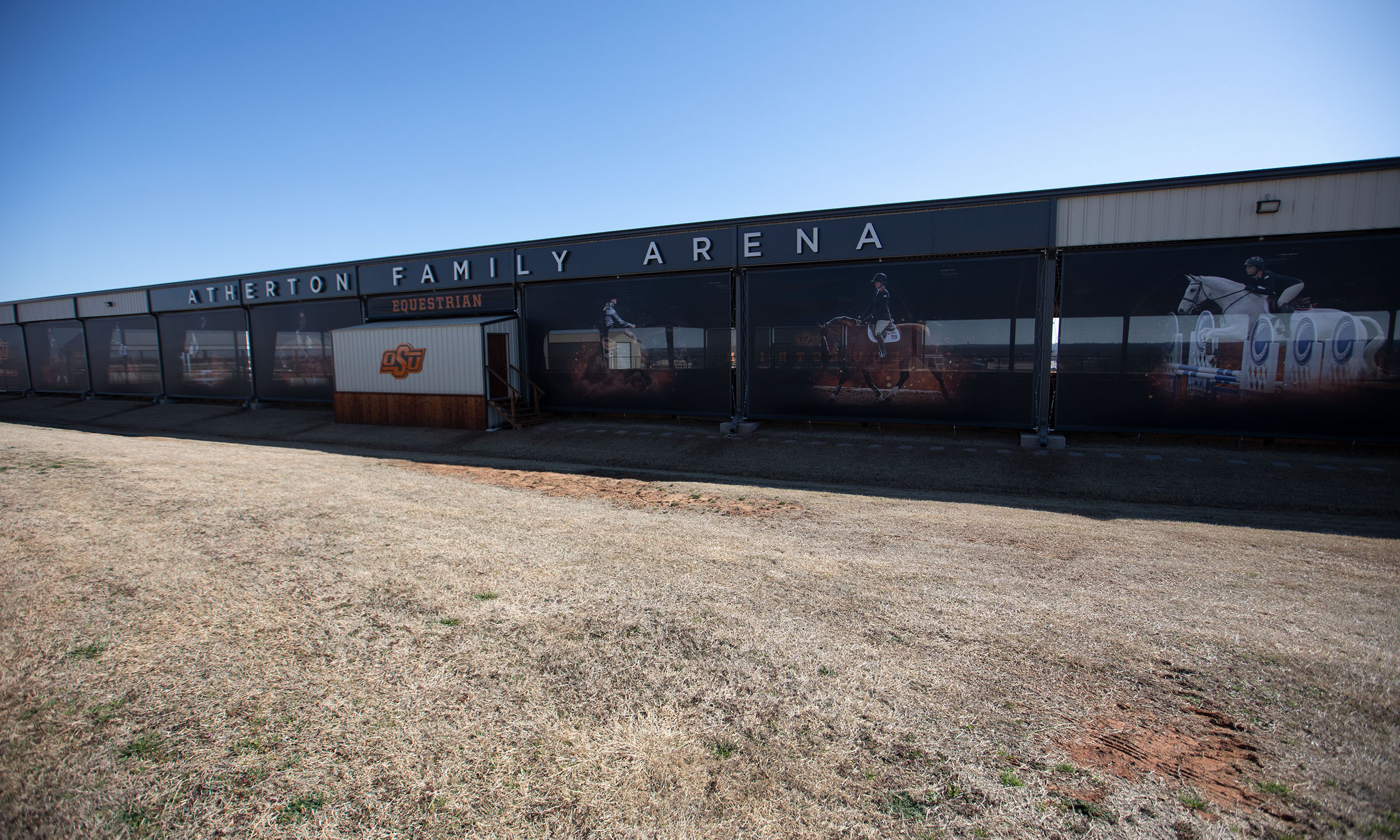
The Atherton Family Arena is a primary practice facility for the Oklahoma State University equestrian team.
Located within the Pedigo-Hull Equestrian Center, this covered arena measures 135-by-270 square feet and features windscreens on the north and west sides. Built in 2019, the arena provides a versatile and weather-protected space for the team to train and prepare for competitions.
In addition to the Atherton Family Arena, the team also utilizes the Totusek Indoor Arena, a 100-by-200-foot climate-controlled facility, and an outdoor arena measuring 140-by-75 square feet.
Athletic Ticket Office Call Center (OSU-Stillwater)
The Athletic Ticket Office Call Center at Oklahoma State University serves OSU athletics fans and supporters.
Located at 398 W Hall of Fame Ave. in Stillwater, the call center operates Monday through Friday from 8:30 a.m. to 5:30 p.m., with walk-in hours from 10 a.m. to 2 p.m. Built in 1947, the call center assists with ticket purchases, event information and customer inquiries, ensuring a seamless experience for all attendees.
On game days, the ticket office opens at each venue when gates or doors open. For assistance, fans can call or text the ticket office at 877-255-4678 or email tickets@okstate.edu.
Auditorium (OSU-Tulsa)
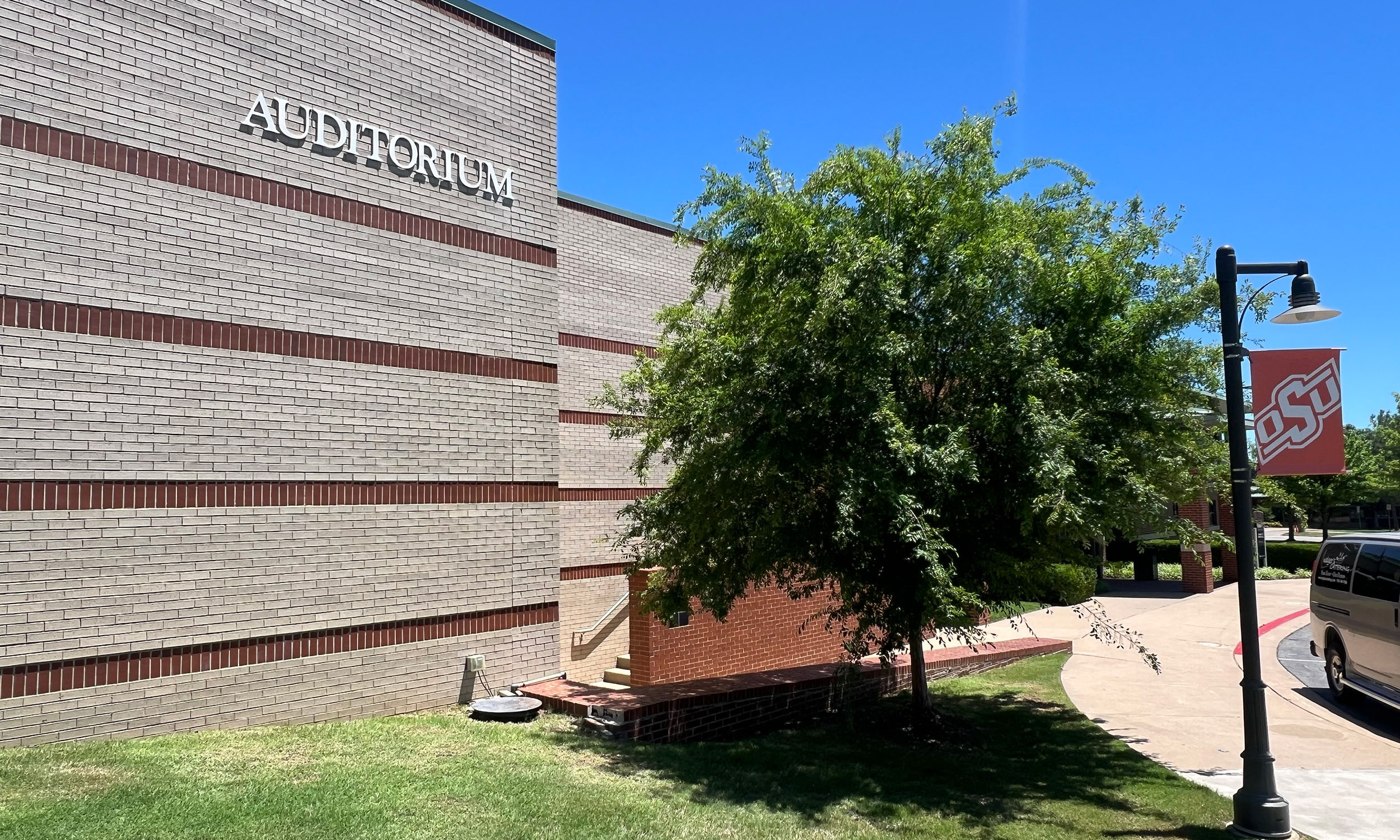
The Auditorium at Oklahoma State University-Tulsa is a versatile facility within the OSU-Tulsa Conference Center.
It has a maximum seating capacity of 376 people and both ground and balcony sections. Built in the mid-1990s, the auditorium is designed to accommodate a variety of events, including lectures, presentations and performances. It features a pre-function lobby space with a built-in registration area and a public bathroom.
The facility is equipped with modern technology to support the needs of different events and provides a comfortable and professional environment for attendees.
Barker, Robert Jefferson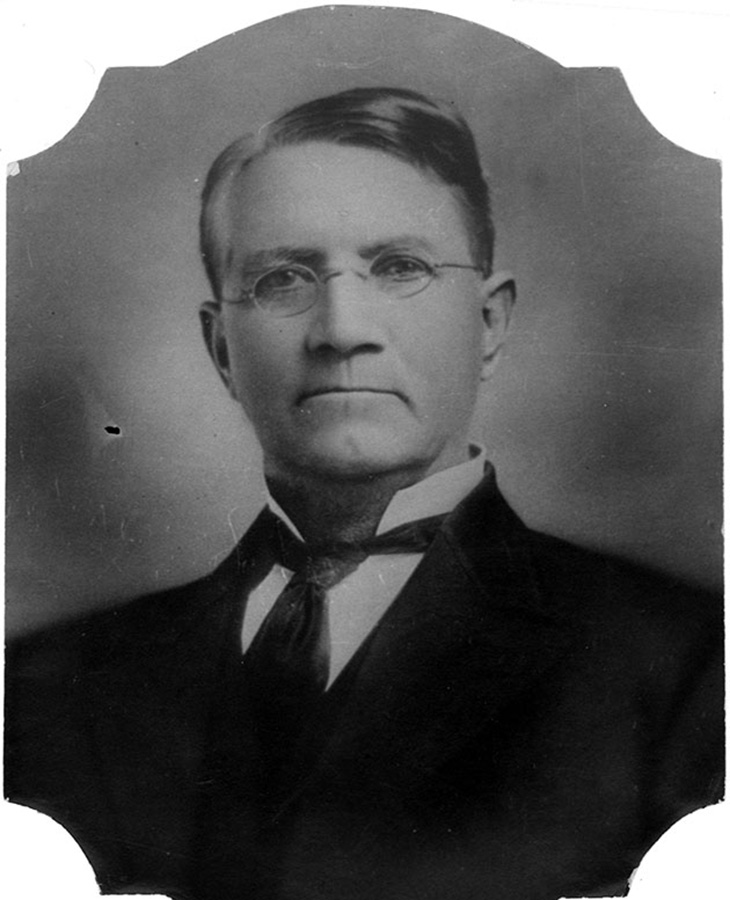
Robert Jefferson Barker (April 28, 1847-Feb. 24, 1940) served as the first president of Oklahoma State University, then known as Oklahoma A&M College, from 1891-94.
He graduated from Hale Normal College in 1869 with a degree in civil engineering. During his tenure, he established the first academic departments, including agriculture and the agricultural experiment station. Barker also participated in the 1889 Land Run and oversaw the dedication of Old Central, the university's first building. Despite his contributions, he was dismissed due to his Republican leanings in a predominantly Democratic Oklahoma.
He later moved to Crescent, Oklahoma, and then Kansas City, Missouri, where Barker entered the real estate business. He died at 92.
Barson Building (OSU-CHS)
The Barson Building at Oklahoma State University Center for Health Sciences was built in 1977.
Named after Dr. John W. Barson, the founding president of the then-Oklahoma College of Osteopathic Medicine and Surgery, the building has a rich history tied to the university's commitment to medical education. Barson, who previously served at Michigan State University, played a pivotal role in establishing the medical school in Tulsa, which welcomed its first class in 1974.
The Barson Building remains a vital part of the OSU campus, reflecting the university's dedication to advancing health care education and research.
Bartlett Center for the Visual Arts (OSU-Stillwater)
The Bartlett Center for the Visual Arts is a prominent facility on Oklahoma State University's Stillwater campus.
It houses the Gardiner Gallery of Art, which hosts various student, professional and traveling exhibitions. Built in 1910, the center serves as a hub for the Department of Art, Graphic Design and Art History, providing students and faculty with state-of-the-art resources and spaces for creative exploration and academic pursuits.
Located at the corner of Morrill Avenue and Knoblock Street, the Bartlett Center is integral to the university's commitment to fostering a vibrant arts community and enriching the cultural landscape of the campus. Originally, the building was the first women’s dorm on campus.
Later named for Mary Maud Gardiner Obrecht (1871-1942) — a pioneer in home economics — it was used for many different purposes until a gift in 1984 from 1943 OSU graduate in mechanical engineering Floyd Milford “Pete” (Sept. 2, 1919-April 9, 1986) and Helen L. “Pat” Bartlett (Aug. 31, 1922-June 19, 2015) made it possible to renovate it for the Department of Art. The Gardiner Art Gallery remains as a tribute to Professor Gardiner.
FIRST REFERENCE: Use full name "Bartlett Center for the Visual Arts."
SECOND REFERENCE: For all subsequent references, it is acceptable to use the term "Bartlett Center."
Bartlett Independent Living Laboratory (OSU-Stillwater)
The Bartlett Independent Living Laboratory in Stillwater is a unique facility at Oklahoma State University designed to showcase and test innovations for barrier-free living.
Built in 1949, it serves as a decorator show house and a technological hub for people with disabilities, featuring adjustable workspaces, motorized windows, skid-resistant floors and various other adaptations to make life easier for individuals with disabilities. It is located off Monroe Street between Bost Hall and Northern Oklahoma College-Stillwater.
The lab is a "living" laboratory where disabled students can temporarily evaluate new additions and provide feedback. The project was supported by a $100,000 donation from the Floyd Milford “Pete” (Sept. 2, 1919-April 9, 1986) and Helen L. “Pat” Bartlett (Aug. 31, 1922-June 19, 2015) family and is owned by the OSU College of Education and Human Sciences and the OSU Foundation.
Bedlam Series
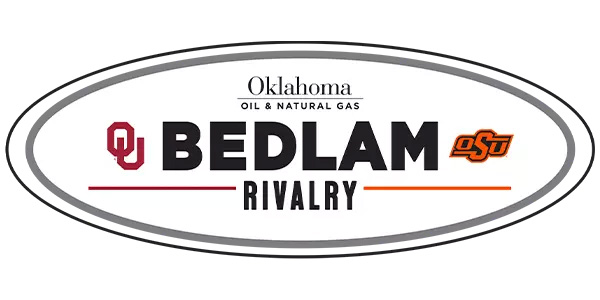
The Bedlam Series is a storied rivalry between Oklahoma State University and the University of Oklahoma, encompassing various sports.
This intense competition dates back to 1904 and has become a significant part of the athletic culture at both universities. The rivalry is marked by passionate fan engagement, thrilling games and memorable moments defining Oklahoma's sports history.
The Bedlam Series not only highlights athletic prowess but also fosters a sense of community and school spirit among students, alumni and supporters of both institutions.
Bell Tower (OSUIT)
The Bell Tower at the Oklahoma State University Institute of Technology is a central landmark on the campus, known for playing music every hour.
This iconic structure not only enhances the aesthetic appeal of the campus but also serves as a symbol of technological excellence and innovation.
Located at the heart of the campus, the Bell Tower is a popular gathering spot for students, faculty and visitors, contributing to the vibrant campus atmosphere.
Bennett, Henry Garland
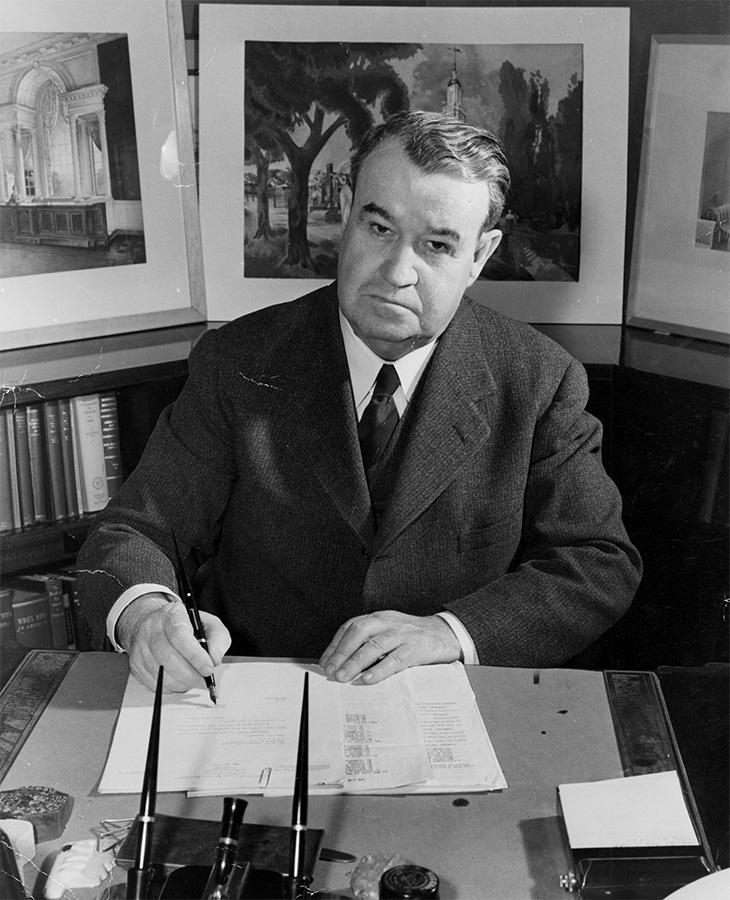 Dr. Henry Garland Bennett (Dec. 14, 1886-Dec. 21, 1951) was a transformative figure
in Oklahoma's educational landscape, serving as the 11th president of Oklahoma State
University (then Oklahoma A&M College) from 1928 until he died in 1951.
Dr. Henry Garland Bennett (Dec. 14, 1886-Dec. 21, 1951) was a transformative figure
in Oklahoma's educational landscape, serving as the 11th president of Oklahoma State
University (then Oklahoma A&M College) from 1928 until he died in 1951.
Bennett received his Bachelor of Arts degree from Ouachita Baptist College in 1907, his Master of Arts degree from the University of Oklahoma in 1924 and his Ph.D. from Columbia University in 1926. Before moving to Stillwater, Bennett was president of Southeastern Oklahoma State University in Durant, where he transformed the campus.
Under his leadership, OAMC saw significant growth, including implementing a "Twenty-five Year Plan" that expanded the campus and increased enrollment from under 4,000 to over 12,000 students. Bennett also played a key role in establishing OSU's technical branch in Okmulgee and enhancing its academic programs to include doctoral degrees.
President Harry S. Truman appointed him the first director of the Point Four Program to provide technical assistance to developing nations. Bennett and his wife, Vera (Sept. 26, 1889-Dec. 22, 1951), died along with 19 others on a Point Four mission in a plane crash near Tehran, Iran, in a blinding snowstorm. He was 65. His legacy is marked by his dedication to education and community development.
Bennett Hall (OSU-Stillwater)
Bennett Hall at Oklahoma State University, named after former OSU President Henry Garland Bennett (Dec. 14, 1886-Dec. 21, 1951), is a historic and popular residence hall near Gallagher-Iba Arena and Boone Pickens Stadium.
Opened in 1950 and renovated multiple times, it offers a variety of suite-style living arrangements for students of all classifications and majors.
The hall features unique floor plans, a cozy basement area known as The Pit, and amenities such as an electric fireplace and a piano. Bennett Hall provides a vibrant living environment, fostering a strong sense of community among its residents.
Bennett Memorial Chapel (OSU-Stillwater)
The Bennett Memorial Chapel is a historic and significant landmark on the campus of Oklahoma State University in Stillwater.
Built in 1958 as a memorial to honor students from Oklahoma Agricultural and Mechanical College who were killed during World War I and World War II, the chapel also commemorates OAMC President Henry Garland Bennett (Dec. 14, 1886-Dec. 21, 1951) and his wife, Vera (Sept. 26, 1889-Dec. 22, 1951), who tragically died in a plane crash in Iran in 1951.
The chapel has been a cherished venue for weddings, memorial services and other significant events, reflecting its deep connection to the university community.
Bert Cooper Engineering Laboratory (OSU-Stillwater)
The Bert Cooper Engineering Laboratory at Oklahoma State University is a state-of-the-art facility that opened in 2015.
Spanning 33,000 square feet, it is one of the region's most advanced structures and materials testing laboratories. The lab houses high-performance equipment for multi-scale research activities, including durability and mechanical micro-characterization, full-scale serviceability and integrity testing. It features a fully equipped fabrication shop, concrete mixing and curing rooms, a concrete pump truck and a 20-ton overhead crane.
It is named after William Bert Cooper (Feb. 26, 1930-Feb. 28, 2012), a former W&W Steel chairman in Oklahoma City and OSU donor.
The BCEL also provides extensive laboratory and field non-destructive testing equipment, environmental chambers and a strong floor for structural testing. Located near the intersection of Ridge Drive and Willis Street, this facility supports academic research and practical applications, making it a vital resource for the College of Engineering, Architecture and Technology.
FIRST REFERENCE: Use full name "Bert Cooper Engineering Laboratory."
SECOND REFERENCE: For all subsequent references, it is acceptable to use the term "BCEL."
Big 12 Conference

The Big 12 Conference is a collegiate athletic conference in the United States consisting of 16 full-member universities, including Oklahoma State University.
Established in 1994, the conference is known for its competitive sports programs and has a significant geographical footprint from Utah to Florida. The Big 12 offers a platform for student-athletes to compete at the highest level in various sports. The conference is committed to academic excellence, sportsmanship and the overall development of its student-athletes.
The current members, as of 2025, are:
- University of Arizona
- Arizona State University
- Baylor University
- Brigham Young University
- University of Central Florida
- University of Cincinnati
- University of Colorado
- University of Houston
- Iowa State University
- University of Kansas
- Kansas State University
- Oklahoma State University
- Texas Christian University
- Texas Tech University
- University of Utah
- West Virginia University
FIRST REFERENCE: Use full name "Big 12 Conference."
SECOND REFERENCE: For all subsequent references, it is acceptable to use the term "Big 12."
Big Orange Bus
The Big Orange Bus is a shuttle service operated by Oklahoma State University, providing convenient transportation between the Stillwater and Tulsa campuses.
The shuttle makes nine trips daily from each campus Monday through Thursday and seven trips on Friday, offering comfortable reclining seats and on-board Wi-Fi for a pleasant commuting experience.
The BOB departs and arrives at the Multimodal Transportation Terminal in Stillwater and Parking Lot A across from Main Hall in Tulsa. This service is available to OSU students, faculty, staff and the general public, enhancing connectivity and accessibility between the two campuses.
FIRST REFERENCE: Use full name "Big Orange Bus."
SECOND REFERENCE: For all subsequent references, it is acceptable to use the term "BOB."
Bioenergy Laboratory (OSU-Stillwater)
The Bioenergy Laboratory at Oklahoma State University is a cutting-edge facility dedicated to advancing research and education in bioenergy.
Built in 2008, the lab supports many projects focused on developing and producing sustainable biofuels and biobased products. It is equipped with state-of-the-art technology and provides students and faculty with the resources to conduct innovative research in biomass conversion, feedstock development and bioenergy systems.
The lab's strategic location off of Marvista Street on the Stillwater campus facilitates collaboration with various departments and industry partners, contributing to the growth of the bioeconomy and sustainability efforts.
Biosystems and Agricultural Engineering Lab (OSU-Stillwater)
The Biosystems and Agricultural Engineering Lab at Oklahoma State University is a unique facility that bridges the Ferguson College of Agriculture and the College of Engineering, Architecture and Technology.
Located at the corner of Hall of Fame Avenue and Cleveland Street in Stillwater, this lab integrates life and agricultural sciences with engineering principles to address critical issues related to sustainable food supply, natural resources, energy and health. Completed in 1966, the lab supports various research activities, including developing innovative solutions for complex, real-world problems and provides students with hands-on learning experiences.
It is a vital resource for advancing agricultural and biological products, as well as the conservation and management of natural resources.
Boger, Lawrence L.
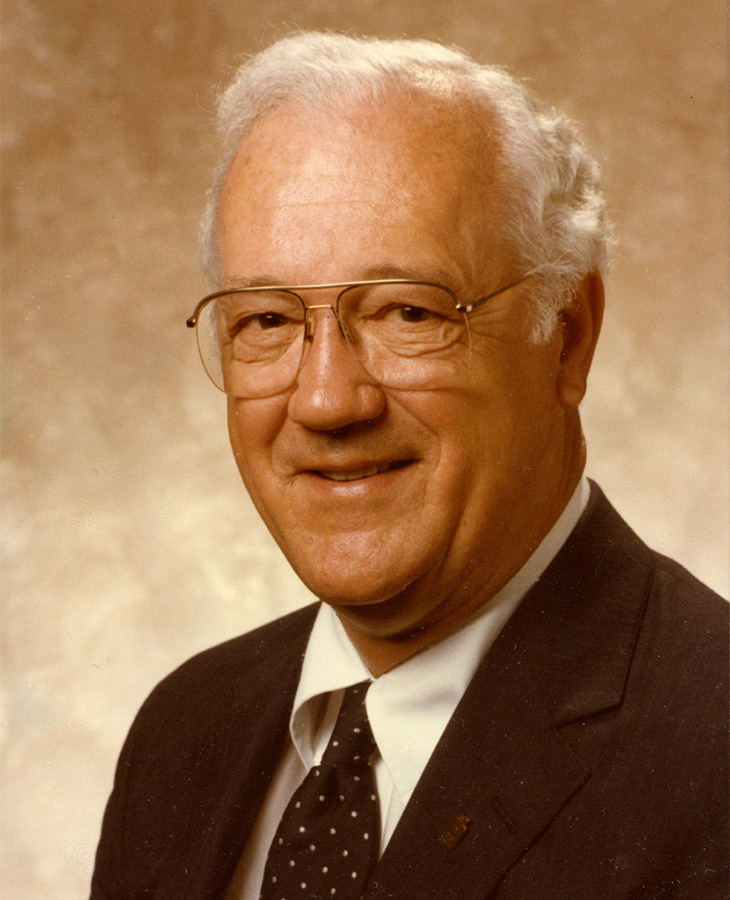 Lawrence L. Boger (Sept. 26, 1923-May 19, 2001) served as the 14th president of Oklahoma
State University from 1977-88.
Lawrence L. Boger (Sept. 26, 1923-May 19, 2001) served as the 14th president of Oklahoma
State University from 1977-88.
Boger earned his bachelor’s degree in agricultural economics from Purdue University in 1947 after serving in the infantry in World War II, where he earned a Purple Heart in the European Theater. He earned his master’s degree from Michigan State University in 1948 and his Ph.D. in agricultural education from MSU in 1950. Boger also attended classes at Harvard University and the University of Chicago.
While at OSU, he was instrumental in developing the campus's integrated communications system. He was key in bringing the Oklahoma College of Osteopathic Medicine and Surgery into the OSU fold. Boger's administration oversaw significant growth and development at the university, including completing or initiating $145 million in construction projects. He was known for his dedication to improving the university's infrastructure and enhancing its academic programs, leaving a lasting impact on the OSU community.
After retirement, Boger was president emeritus at OSU until his death from leukemia in 2001. He was 77.
Booker-Stinchcomb Hall (OSU-Stillwater)
Booker-Stinchcomb Hall is a deluxe-suite style residence hall at Oklahoma State University, located in the North Monroe Neighborhood between the University Commons Complex and Neal Patterson Stadium.
Built in 2003, it accommodates 335 residents and offers a variety of amenities, including community laundry facilities, kitchens, study and recreational spaces, and ADA rooms. Each unit features a living room, kitchenette, bathroom and two private bedrooms. The hall is coed, with individual units being same-gender, and provides a convenient living option close to dining and academic buildings. Booker-Stinchcomb Hall is known for its modern facilities and central location, making it a popular choice among students.
Booker Hall was named after Tulsa-born Oklahoma A&M College graduate and founder of Aeromet, Dr. Doyle Ray Booker (Nov. 26, 1934-Aug. 5, 2019), who received a bachelor's degree in mechanical engineering in 1957. Stinchomb Hall was named after OSU alumnus Glenn McFee Stinchcomb (May 14, 1927-June 9, 2022), who graduated with a bachelor's degree in management and later obtained a master's degree in accounting.
Boone Pickens Stadium (OSU-Stillwater)
Boone Pickens Stadium, located on the campus of Oklahoma State University in Stillwater, is the home of the Cowboy football team.
Dr. Lowery Layman Lewis (Sept. 3, 1869-Sept. 26, 1922) arrived in Stillwater in 1896 as a professor of veterinary medicine and later became dean of veterinary medicine and the School of Science and Literature. Known affectionately as "Old Doc Lew," he organized early track and football teams at Oklahoma A&M, earning recognition as "the most beloved figure" among territorial scholastic students. In 1910, the Athletic Association named the athletic grounds Lewis Field in his honor, a name made official during the 1913-14 academic year. In 1919, the field was moved to its permanent site on the northeast edge of the campus and repositioned to avoid prevailing winds.
It was renamed in honor of Thomas Boone Pickens (May 22, 1928-Sept. 11, 2019), a prominent OSU alumnus and philanthropist, following his transformative $165 million donation in 2006. The stadium has undergone significant renovations, including a state-of-the-art football operations center, new seating and modern facilities, making it one of the premier venues in college football.
With a seating capacity of over 52,000, Boone Pickens Stadium provides a unique game-day environment and a roaring home-field advantage for the Cowboys.
FIRST REFERENCE: Use full name "Boone Pickens Stadium."
SECOND REFERENCE: For all subsequent references, it is acceptable to use the term "BPS."
Bost Hall (OSU-Stillwater)
Bost Hall is a residential building at Oklahoma State University in the North Monroe Neighborhood next to the Griffith Community Center.
Constructed in 2001, it offers apartment-style living with four private bedrooms, a living room, a kitchen, and an in-unit washer and dryer. The hall accommodates approximately 96 residents and provides various amenities, including a balcony or patio, central heating and air conditioning, and access to the Griffith Community Center's recreational facilities.
Bost Hall is named after Armon Henry Bost (May 18, 1909-March 5, 2004), an Oklahoma A&M College graduate who established the Midwestern Engine and Equipment Company in Tulsa. His mother, Jessie Olive Thatcher Bost (Dec. 16, 1875-Feb. 14, 1963), was the first woman to graduate from OAMC.
This hall is popular for students seeking a comfortable and convenient living environment close to campus facilities.
Botanic Garden at Oklahoma State University, The (OSU-Stillwater)
The Botanic Garden at Oklahoma State University is a vibrant, multidisciplinary laboratory located just west of the Stillwater campus alongside 6th Avenue.
Spanning 100 acres, it features walking trails, native plants and beautiful display gardens that serve as a living classroom for research, discovery and inspiration. The garden is home to the long-running television show "Oklahoma Gardening" and hosts various events, including open houses and the annual GardenFest.
It also supports educational programs and community outreach, contributing to the university's mission of promoting sustainability and environmental stewardship.
FIRST REFERENCE: Use full name "The Botanic Garden at Oklahoma State University."
SECOND REFERENCE: For all subsequent references, it is acceptable to use the term "The Botanic Garden", the “The” is capitalized.
Branding Success
The Branding Success campaign at Oklahoma State University was a historic fundraising initiative that aimed to elevate the university's impact and reach.
Launched in 2007 under the leadership of then-President Burns Hargis and the OSU Foundation, the campaign set an ambitious goal of raising $1 billion. It concluded in December 2014, surpassing its target by raising over $1.2 billion from more than 104,000 donors, including 45,000 first-time donors.
The funds raised through the campaign were directed toward student scholarships, faculty endowments and vital infrastructure projects, significantly enhancing the educational opportunities and resources available at OSU.
The success of this campaign marked a transformative period for the university, solidifying its position as a leading land-grant institution.
Bringing Dreams to Life
The Bringing Dreams to Life campaign at Oklahoma State University was the first comprehensive fundraising initiative launched in June 1994 by the OSU Foundation.
The campaign aimed to unite donor passions with university priorities to elevate OSU’s impact. It concluded in June 2000, surpassing its initial goal of $125 million by raising over $260 million.
This campaign was crucial in supporting various university programs, scholarships and infrastructure projects, significantly enhancing the educational opportunities and resources available to students, faculty and staff.
Brumley Apartments (OSU-Stillwater)
Brumley Apartments is a residential complex at Oklahoma State University at the intersection of Farm Road and Walnut Street.
The apartments offer convenient living options for students, featuring amenities such as in-unit laundry, kitchens and private bedrooms. The complex is close to various campus facilities, including the Seretean Wellness Center and the Colvin Recreation Center, providing easy access to recreational and academic resources. Brumley Apartments is a popular choice for students seeking a comfortable and well-equipped living environment on campus.
Built in 1961, the college named the cluster of new campus apartments after Ben Allen Brumley Jr. (1921-July 11, 1946), recognizing his legacy as the first World War II veteran to die while attending the college. He died of pneumonia. He also served as the first public safety commissioner, known for his efforts to enforce speed limits and ensure dogs were vaccinated in the Veteran’s Village.
Business Building (OSU-Stillwater)
The Business Building at Oklahoma State University, home to the Spears School of Business, is a modern facility supporting business students' academic and professional development.
Opened in 2018, the building features state-of-the-art classrooms, collaborative spaces and advanced technology to enhance learning and research. Located at the corner of Athletic Avenue and Hester Street, it houses various centers and institutes that engage students in impactful research and community engagement initiatives, providing opportunities for hands-on experience and close collaboration with faculty.
The Spears School of Business is dedicated to preparing students for successful careers in the business world, fostering innovation and promoting ethical leadership.
Note: The Spears School of Business is housed in the Business Building, so please do not use the college's name in reference to the building itself.
Business Technologies Building (OSU-OKC)
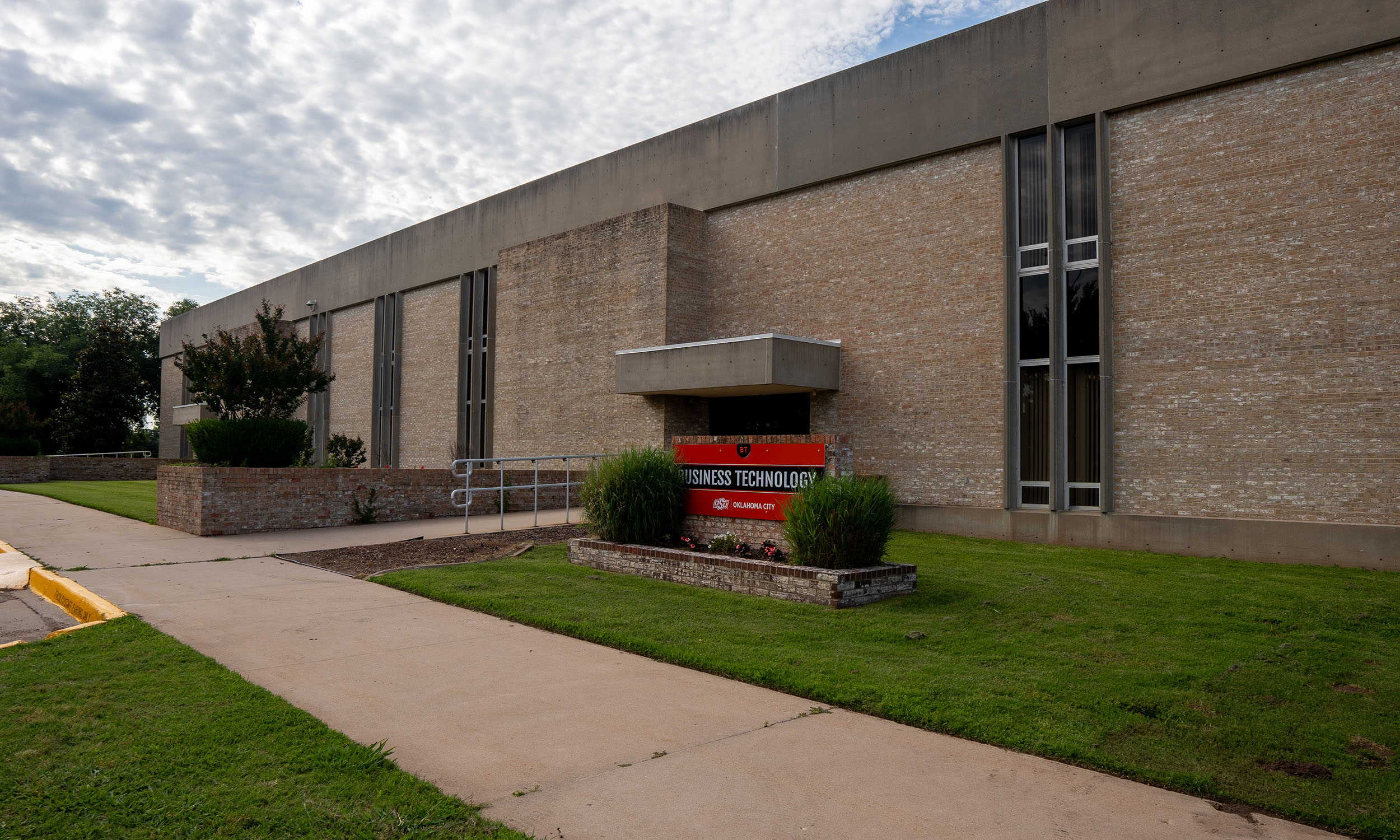
The Business Technologies Building at Oklahoma State University-Oklahoma City is a central hub for students pursuing careers in information technology and business-related fields.
This facility houses the School of Human Services and the Information Systems and Technologies Department, which offers programs in network management, cybersecurity and software development. Located north of the Learning Resource Center, the building is equipped with modern classrooms and labs designed to provide hands-on learning experiences, ensuring that students are well-prepared for the demands of the workforce.
Built in 1970, the Business Technologies Building also serves as a resource for campus security and other administrative functions, reflecting OSU-OKC's commitment to providing a comprehensive educational environment.
Cal and Marilyn Vogt Pond (OSU-CHS)
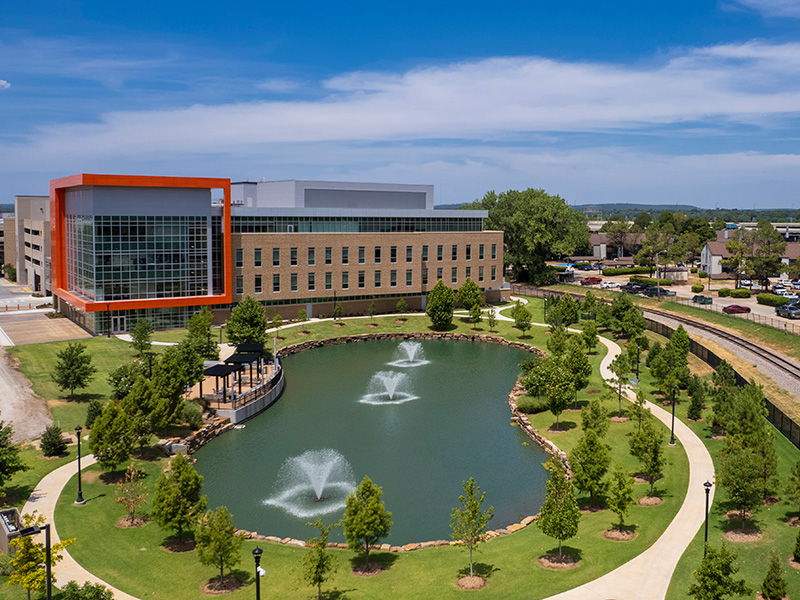
The Cal and Marilyn Vogt Pond at Oklahoma State University Center for Health Sciences in Tulsa is a serene and picturesque spot on campus, named in honor of Calvin "Cal" Vogt and his wife, Marilyn.
Cal Vogt, an OSU alumnus, graduated with bachelor's and master's degrees in electrical and computer engineering. He made significant contributions to Tulsa, particularly in the field of electronics. After completing his service in 1956, he moved his family to Tulsa and began working for Century Electronics. Over the next 13 years, he developed several electronic innovations that had a lasting impact on the industry. His impressive career as the owner of multiple companies and his creation of several patents further solidified his influence in the field.
The pond serves as a tranquil retreat for students, faculty and visitors, providing a peaceful environment for relaxation and reflection. It is also a popular location for campus events and activities, contributing to the vibrant community life at OSU-CHS.
Camp Redlands (OSU-Stillwater)
Camp Redlands, owned and operated by Oklahoma State University, is a historic retreat facility on Lake Carl Blackwell's north shore.
It was established during the Oklahoma Land Run in 1889 and later housed workers and their families who were helping build the lake. In the 1950s, the state gave Camp Redlands to then Oklahoma Agriculture and Mechanical College.
The buildings were constructed in the 1930s as part of a WPA project. The camp initially consisted of 12 frame cabins, a lodge, a wellhouse and a cook's cabin, many of which still stand today.
Campbell, John Roy
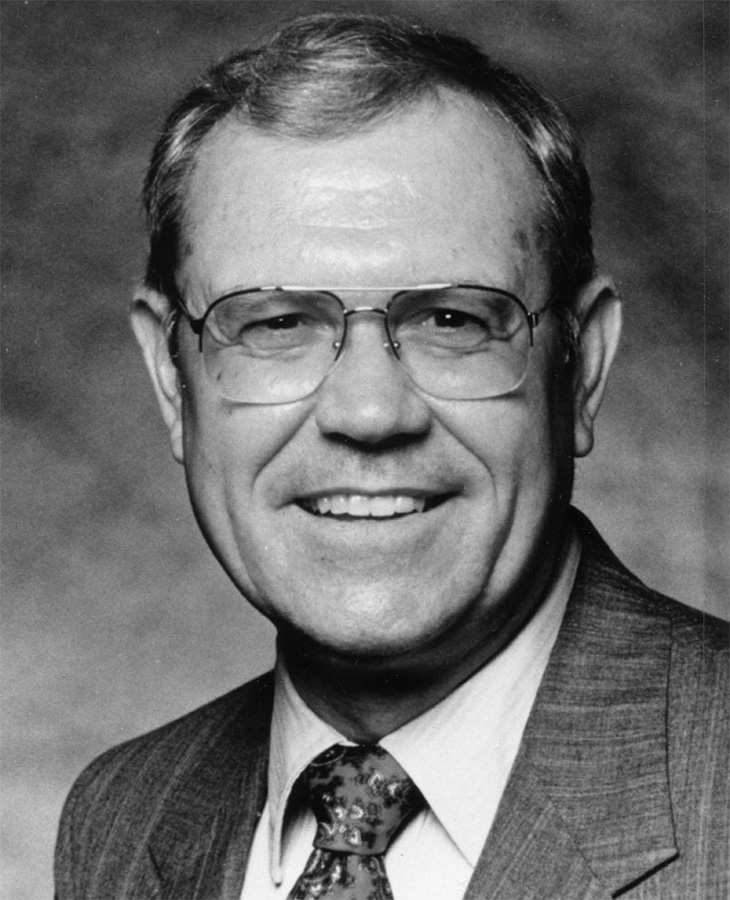 Dr. John Roy Campbell (June 14, 1933-Nov. 17, 2018) served as the 15th president of
Oklahoma State University from 1988-93.
Dr. John Roy Campbell (June 14, 1933-Nov. 17, 2018) served as the 15th president of
Oklahoma State University from 1988-93.
He received his bachelor’s degree in agriculture in 1955, his master’s degree in dairy manufacturing in 1956, and his Ph.D. in dairy cattle nutrition in 1960, all from the University of Missouri. He also served in the army for two years in active duty and over 20 in the reserves. As OSU president, he emphasized the university's land-grant heritage and its legacy of international outreach. Campbell was instrumental in developing the university's honors program, increasing scholarships, and expanding distance learning and inter-university partnerships.
After resigning from the presidency, he continued to teach in OSU's College of Agriculture and remained an influential figure in education until his retirement in 1999. Campbell's contributions to higher education were widely recognized, and he authored several books on education and his teaching philosophy. He died in 2018 at 85.
Campus Fire Station (OSU-Stillwater)
The Campus Fire Station, aka Stillwater Fire Station No. 2, is located at 600 W. University Ave. on the Oklahoma State University campus.
It is a historic and functional facility serving the university and the city. Built in 1938 as a joint project between the university, the city and the federal Public Works Administration, the station was designed by OAMC architect Philip A. Wilbur in the Colonial Revival style. It features a core brick rectangular building with two wings and a five-story drill tower.
The Campus Fire Station is notable for housing the first academic degree program for firefighters in the United States, established by the Department of Firemanship Training at Oklahoma Agricultural and Mechanical College (now OSU). The building retains much of its historic character while accommodating modern technologies and training requirements.
Cantwell, James William
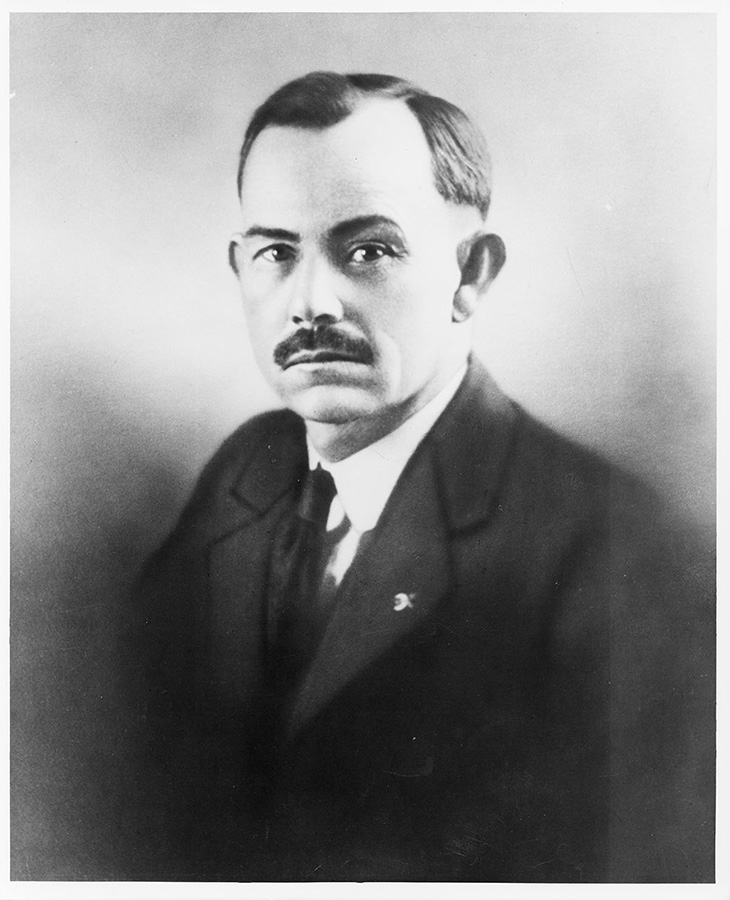 James William Cantwell (March 6, 1868-April 2, 1931) served as the seventh president
of Oklahoma Agricultural and Mechanical College (now Oklahoma State University) from
1915-21.
James William Cantwell (March 6, 1868-April 2, 1931) served as the seventh president
of Oklahoma Agricultural and Mechanical College (now Oklahoma State University) from
1915-21.
He earned a bachelor’s degree from Baylor University and another bachelor’s degree from Yale University in 1893 and 1894, respectively. Cantwell received his master’s degree from Baylor in 1903. He later received an honorary doctorate from Baylor in 1917. During his tenure as OAMC president, Cantwell prioritized student welfare, supporting the formation of new student organizations and expanding the music department. He was known for recruiting faculty from major institutions and envisioned a multipurpose university.
Cantwell also initiated officer training programs as World War I escalated, introducing vocational retraining for veterans. His leadership helped shape the university's development during a critical period. He later became president of Midwestern State University in Wichita Falls, Texas, a position he held until he died in 1931. He was 63.
Carreker Halls (OSU-Stillwater)
Carreker East and Carreker West Halls are three-story residential buildings at Oklahoma State University-Stillwater, located in the Morrison Neighborhood on the north side of McElroy Road.
Each hall accommodates 72 undergraduates of all classifications and majors, offering apartment-style living with two private or shared bedrooms, a living room, a full-size kitchen, and an in-unit washer and dryer. The halls are coed, with individual units being same-gender, and leases are for the nine-month academic year. Carreker Halls are named after James Don "Jim" Carreker, a distinguished business leader and OSU alumnus who earned his bachelor’s degree in 1970 and MBA in 1972.
Built in 2001, the halls are conveniently located within walking distance of several dining options and the Griffith Community Center, making them popular for students seeking a comfortable and well-equipped living environment.
Center for Advanced Medical Education Building (OSU-CHS)
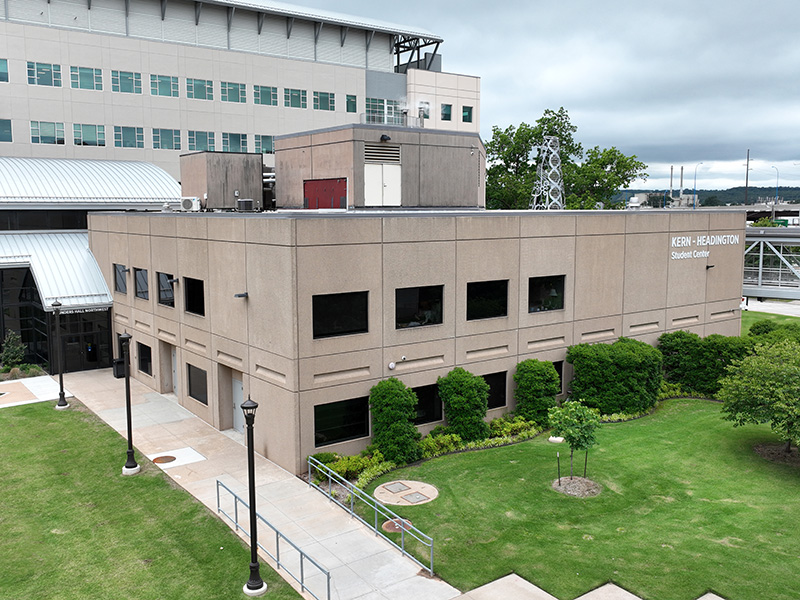
The Center for Advanced Medical Education Building at Oklahoma State University is a state-of-the-art facility on the OSU Center for Health Sciences campus in Tulsa.
This building, constructed in 1998, features Oklahoma's largest hospital simulation center, which includes high-functioning simulation manikins that mimic real-life medical emergencies. The building also houses active learning classrooms, spacious lecture halls and a patient-centered clinical skills laboratory, providing medical students with hands-on experience in a controlled environment.
The facility's advanced technology and comprehensive resources are designed to enhance medical education and prepare students for real-world medical scenarios.
FIRST REFERENCE: Use full name "Center for Advanced Medical Education Building."
SECOND REFERENCE: For all subsequent references, it is acceptable to use the term "C.A.M.E. Building."
Central Market Place (OSU-Stillwater)
Central Market Place is a dining facility at Oklahoma State University-Stillwater, located south of the Villages on Cleveland Street.
Opened in 2024, it features a modern, open seating atmosphere with a covered patio area offering views of campus activities. The facility houses four dining options: Caribou Coffee, 405 Deli, BYTE and 1890 Market. Caribou Coffee serves traditional and specialty drinks along with bakery items, while 405 Deli offers gourmet sandwiches and salads named after Stillwater roads and locations. BYTE is a unique ghost kitchen concept with a rotating menu that provides fresh and diverse food options. The 1890 Market is the largest on-campus convenience store, offering grab-and-go items, groceries and select Cowboy Meats products.
Central Market Place is a popular spot for students to gather, dine and enjoy a variety of food options in a dynamic and welcoming environment.
Central Plant (OSU-Stillwater)
The Central Plant at Oklahoma State University is a state-of-the-art facility designed to improve efficiency and reduce the university's environmental footprint.
Located along Washington Street, the 73,000-square-foot facility was completed in April 2018 to replace the defunct Power Plant, which was built in 1948 and demolished in 2025. It serves 10 million square feet across the OSU-Stillwater campus, providing steam for heating and chilled water for cooling. The Central Plant features advanced efficiency equipment, which is estimated to save more than $400,000 annually in energy costs.
Additionally, the facility includes an 80-person classroom for interdisciplinary teaching and an observation deck for students and visitors to view the boiler and chiller floors.
Charles and Linda Cline Equine Teaching Center (OSU-Stillwater)
The Charles and Linda Cline Equine Teaching Center is a state-of-the-art equine teaching facility on approximately 60 acres at Oklahoma State University-Stillwater.
Located at the corner of McElroy Road and Marvista Street, the center includes six native and Bermuda grass pastures, a teaching barn, a small indoor arena, outdoor arenas, classrooms, feed and tack rooms, a wash rack and a treatment area. Additionally, there is a building dedicated to the breeding program. The facility provides students with hands-on training in equine breeding, foaling, marketing and sales preparation, and hosts extension equine events.
John Charles (Jan. 9, 1936-June 13, 2012) and Linda Cline met on a blind date in 1954 and married three years later, remaining together until Charles passed away in 2012. They raised two children and co-founded Cherokee Lines trucking company, which they ran from 1963 to 1990. In 1985, they established Char-Lin Ranch, renowned for its registered quarter horses and Angus cattle.
Despite not attending OSU, they credited much of their success to the university's faculty and generously supported its equine program. They supported various charitable causes, including the Special Olympics. The center is integral to the university's commitment to providing comprehensive equine education and training.
Chesapeake Energy Natural Gas Compression Training Center (OSUIT)
The Chesapeake Energy Natural Gas Compression Training Center, located on the Oklahoma State University Institute of Technology campus in Okmulgee, is a state-of-the-art facility that trains students in the technical skills necessary to maintain and operate natural gas engines and gas compressor units.
Opened in September 2013, the 23,920-square-foot center is the first of its kind in the energy industry, providing hands-on learning experiences in an industry-quality laboratory. The center was made possible through a leadership donation by Chesapeake Energy Corporation, along with contributions from Devon Energy, ONEOK and Energy Transfer.
The facility supports OSUIT's Natural Gas Compression program, which has been offered since 1974 and aims to meet the growing demand for trained technicians in the energy sector.
Chi O'Clock (OSU-Stillwater)
The Chi O'Clock is a prominent landmark on the Oklahoma State University-Stillwater campus between Edmon Low Library and the Student Union. This free-standing clock commemorates the 50th anniversary of the Tau Beta chapter of the Chi Omega sorority.
Standing about 25 feet tall, with approximately 22 feet of brick tower and a 3-foot clock face, the Chi O'Clock is a popular spot for students and visitors alike. The area around the clock is a convenient and picturesque meeting point on campus.
The Chi O'Clock is also a designated tabling area for various campus events and activities.
Child Care Center (OSUIT)
The Child Care Center at OSU Institute of Technology is a 5-star rated facility that provides high-quality child care services to the OSUIT campus and the Okmulgee community.
Built in 1970, the center emphasizes children's development and learning, ensuring a safe and nurturing environment for young children. The center's top-tier rating from the Oklahoma Department of Human Services reflects its commitment to exceptional care and educational standards.
Located at 1801 East 4th St. in Okmulgee, the Child Care Center supports OSUIT students, faculty and staff by offering reliable child care services.
Classroom Building (OSU-Stillwater)
The Classroom Building at Oklahoma State University is a central facility designed to support the academic needs of students across various disciplines.
It was completed and opened for classes in 1952. Built at an estimated cost of $850,000, the building included a basement and four stories and was designed to duplicate its companion to the north, the Engineering Building (now Engineering South). The Classroom Building houses multiple classrooms, computer labs and walk-up support services, including ID services. It is also home to the LASSO Tutoring Center, which offers free one-on-one tutoring, academic success coaching and supplemental instruction to help students excel in their courses.
The Classroom Building is an essential resource for fostering student success and providing a conducive learning environment on the OSU campus.
Cohn Family Small Animal Shelter (OSU-Stillwater)
The Cohn Family Small Animal Shelter, also known as the Cohn Pet Care Facility, is a dedicated space at Oklahoma State University designed to provide long-term care for pets whose owners can no longer care for them.
Established in 1998 with a generous donation from the estate of Leah Cohn Arendt (Jan. 6, 1893-Oct. 20, 1990) and matching funds from the university, the facility is located on eight acres north of the OSU Veterinary Medical Hospital. The 6,600-square-foot building includes special features such as an indoor cat room, areas for veterinary examinations, treatment and grooming, outdoor runs, separate dog kennels and a comfortable visiting area.
The facility ensures that pets receive excellent care and companionship, providing peace of mind to pet owners.
Colvin Center Annex (OSU-Stillwater)
The Colvin Center Annex at Oklahoma State University is a premier facility with four basketball courts with a synthetic playing surface.
It can seamlessly convert into volleyball courts, making it a favorite spot for intramural sports. The annex recently underwent a $5 million renovation, enhancing its amenities with natural light and air conditioning, making it an ideal location for small conferences and workshops.
Located at 101 Colvin Center, the Colvin Center Annex is part of the Department of Wellness and is a versatile space for various recreational activities.
Colvin Recreation Center (OSU-Stillwater)
The Colvin Recreation Center at Oklahoma State University is a state-of-the-art facility offering 240,000 square feet of recreational space.
It serves an average of 4,000 students daily. It provides many amenities, including an indoor track, cardio and cycle studios, a 25-foot rock climbing wall, and multiple courts for basketball, volleyball, pickleball and badminton. The center also features an outdoor leisure pool, racquetball courts, dance studios, and extensive weight and fitness equipment.
Named after Valerie Colvin (Jan. 14, 1904-July 2, 1988), a longtime OSU faculty member and pioneer in physical education, the Colvin Recreation Center opened in 1969. It has been recognized as an Outstanding Sports Facility by the National Intramural and Recreation Sports Association and continues to be a hub for student wellness and recreation.
Community Impact Center (OSU-OKC)
The Community Impact Center at Oklahoma State University-Oklahoma City is a vital facility dedicated to fostering community engagement and providing essential services to the local population.
This center hosts a variety of programs and events aimed at improving the quality of life for residents, including educational workshops, health and wellness initiatives, and community outreach activities. Located south of the Engineering Technology Center, the center also serves as a venue for public meetings and forums, such as the Regional Transportation Authority's open house events, which gather community input on future transit options.
The Community Impact Center reflects OSU-OKC's commitment to serving the community's needs and promoting positive social impact.
Compressed Natural Gas Fueling Facility (OSU-Stillwater)

The Compressed Natural Gas Fueling Facility at Oklahoma State University is a significant part of the university's commitment to clean energy and sustainability.
Dedicated on April 21, 2011, the facility serves as a fueling and housing station for OSU transit buses, which have been converted to run on compressed natural gas. Located north of the Stillwater campus at the corner of Western and Lakeview roads, it is also a 24/7 public fueling station, providing an environmentally friendly alternative to traditional fossil fuels.
Notable figures, including Oklahoma Gov. Mary Fallin, OSU benefactor T. Boone Pickens and OSU President Burns Hargis, attended the dedication ceremony. This facility underscores OSU's efforts to reduce its carbon footprint and promote sustainable transportation options.
Connell, John Henry
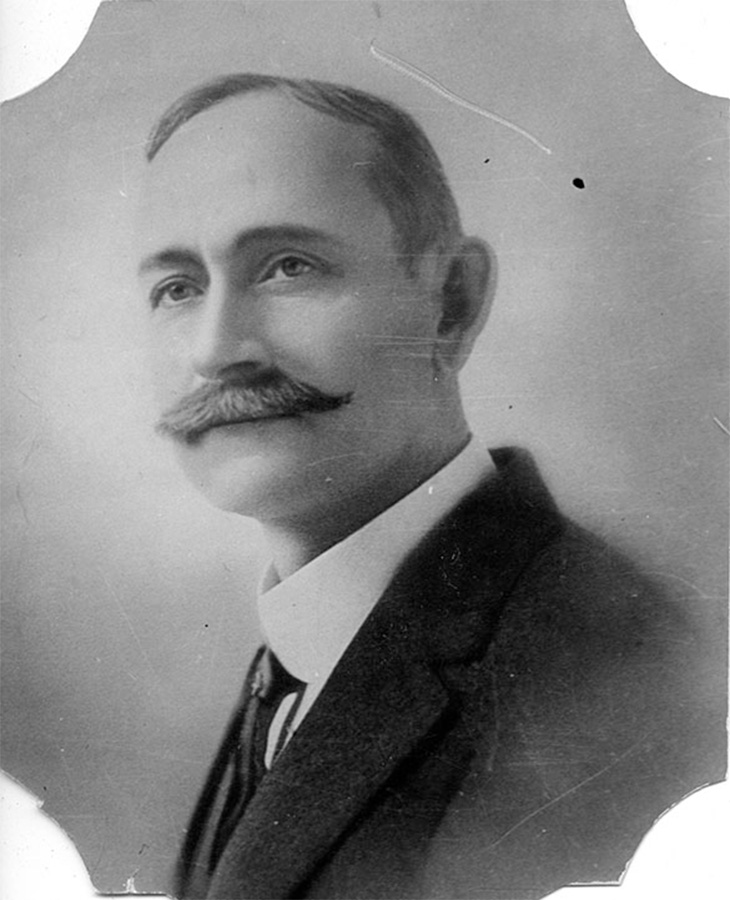 John Henry Connell (July 9, 1867-May 26, 1943) served as the sixth president of Oklahoma
Agricultural and Mechanical College (now Oklahoma State University) from 1908-14.
John Henry Connell (July 9, 1867-May 26, 1943) served as the sixth president of Oklahoma
Agricultural and Mechanical College (now Oklahoma State University) from 1908-14.
He earned his bachelor’s degree from Mississippi State University in 1888. He formally launched the Agricultural Extension Service and extension programs during his tenure, significantly increased enrollment, and expanded the range of degrees offered. Connell also guided a building boom on campus and published two newspapers to promote the college. His leadership and vision played a crucial role in the early development and growth of the institution.
He later moved to Dallas, first as president of the Texas Cotton Growers Association and then entering the automobile industry until he died in 1943. He was 75.
Connors State College
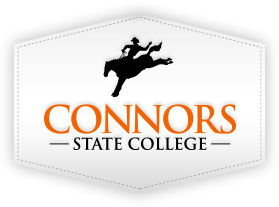 Connors State College is a public community college located in Warner, Oklahoma.
Connors State College is a public community college located in Warner, Oklahoma.
As part of the OSU/A&M System, CSC offers a variety of associate degree programs and certificates in fields such as agriculture, business, health sciences and liberal arts. CSC was named in honor of John P. Connors (Jan. 25, 1857-Dec. 7, 1942), who was the first president of the Oklahoma Board of Agriculture. It was founded in 1908 as an agricultural high school and quickly converted to a school of agriculture.
The college is known for its strong emphasis on student success, providing a supportive learning environment with small class sizes and personalized attention. CSC also boasts a vibrant campus life with numerous student organizations, athletic programs and community engagement opportunities. The university mascot is the Cowboys.
Warner is a town located in Muskogee County. It is situated approximately 20 miles south of Muskogee. The city was formed from two communities, Bennett and Hereford, and was named after William Warner, a prominent figure in the area in the early 1900s.
FIRST REFERENCE: Use full name "Connors State College."
SECOND REFERENCE: For all subsequent references, it is acceptable to use the term "CSC."
ConocoPhillips OSU Alumni Center (OSU-Stillwater)
The ConocoPhillips OSU Alumni Center is the on-campus home for Oklahoma State University's 270,000 living alumni.
This premier, award-winning facility is strategically located in the heart of Oklahoma, equidistant from the state's two largest metropolitan areas of Oklahoma City and Tulsa. Located off of Hester Street across from the Student Union, the center offers a variety of spaces for events, including an elegant 5,700-square-foot banquet hall, intimate dining facilities, breakout spaces, an executive conference room and a 120-seat multimedia seminar room.
Opened in 2005, the center recently underwent its most extensive refresh to date in 2024, focusing on creating a more welcoming and modern environment for members of the Cowboy family.
More than 75,000 people visit the Alumni Center annually, making it a hub for alumni engagement and events.
FIRST REFERENCE: Use full name "ConocoPhillips OSU Alumni Center."
SECOND REFERENCE: For all subsequent references, it is acceptable to use the term "Alumni Center."
Construction Technology Laboratory (OSU-Stillwater)
The Construction Technology Laboratory at Oklahoma State University-Stillwater is a 5,926-square-foot facility with a concrete room, soils room and a moderate-sized classroom for lectures.
Built in 1968, this laboratory is part of the Construction Engineering Technology program within the College of Engineering, Architecture and Technology. It provides students with hands-on experience and practical applications in various construction phases, including managing the construction process, executing designs, estimating, scheduling and coordinating projects.
Located near the intersection of McElroy Road and Willis Street, the lab was constructed by students and faculty through generous donations from alumni, reflecting the strong community support and commitment to advancing construction education at OSU.
Controlled Environment Research Laboratory (OSU-Stillwater)
The Controlled Environment Research Lab at Oklahoma State University is responsible for managing growth chamber labs, greenhouses and research facilities owned by the Division of Agricultural Sciences and Natural Resources and the Oklahoma Agricultural Experiment Station.
As the mechanical maintenance arm of the Field and Research Unit, CERL ensures a safe, comfortable and clean environment for research activities. The lab's employees are licensed for HVAC equipment and oversee new construction related to mechanical systems, advising researchers on equipment purchases concerning building heat loads, refrigerants, electrical and plumbing requirements.
CERL Central, built in 1964, features state-of-the-art growth chambers with programmable lighting and temperature controls, supporting a wide range of research needs.
FIRST REFERENCE: Use full name "Controlled Environment Research Laboratory."
SECOND REFERENCE: For all subsequent references, it is acceptable to use the term "CERL."
Covelle Hall (OSUIT)
Covelle Hall at OSU Institute of Technology is a prominent facility on the Okmulgee campus.
Located at the corner of Bennett and Willham drives, it serves as a venue for various events, including commencement ceremonies, student activities, and fitness and recreation programs.
Built in 1961, the hall has modern amenities to support a wide range of functions, making it a central hub for campus life. Covelle Hall's versatile space and state-of-the-art facilities contribute to its role as a key location for academic and extracurricular activities at OSUIT.
Cowboy Code
The Cowboy Code at Oklahoma State University is a set of guiding principles that unite the Cowboy family, emphasizing values such as integrity, perseverance and community. Inspired by the book, "Cowboy Ethics: What Wall Street Can Learn from The Code of the West" by James P. Owen, the Cowboy Code encourages students, faculty and staff to live by seven core principles:
- We end the day knowing we gave it everything we had.
- We dream as big as the sky.
- We know challenges come with pain, but pain will not win.
- We have a passion to do what's right, even when it's hard.
- We stand for what matters, even if we stand alone.
- We finish what we start.
- Being a Cowboy isn't in our clothes, it's in our character.
Cowgirl Stadium (OSU-Stillwater)
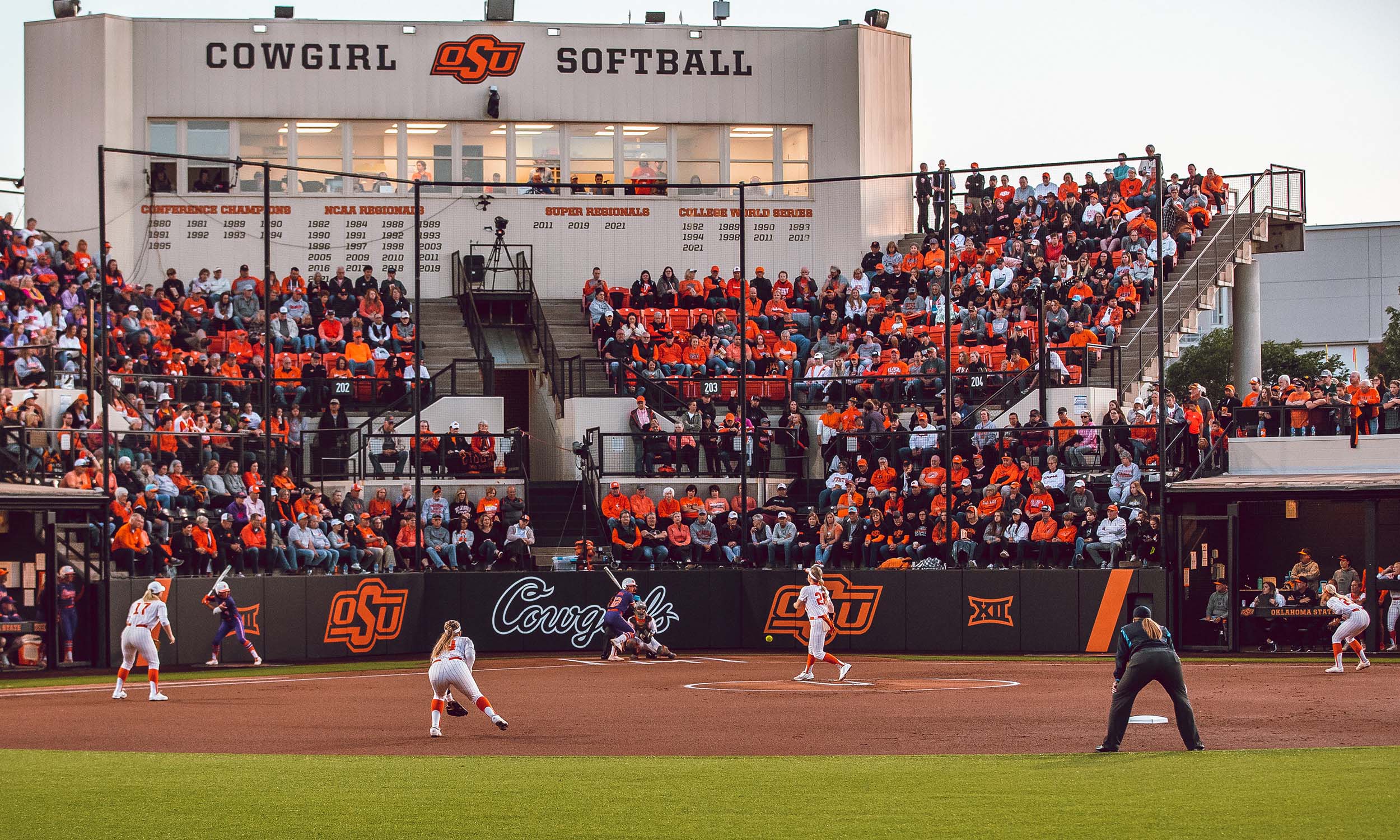
Cowgirl Stadium is a softball facility at Oklahoma State University, serving as the home field for the OSU softball team.
Opened on April 5, 2000, with funds from the OSU-Nebraska football game at Kansas City's Arrowhead Stadium on Oct. 3, 1998. The game's sponsor, Western Star, provided the necessary financing for the stadium, which is located on the northeast corner of the OSU campus, near Duck Street and McElroy Road. Built for approximately $2 million on the same site as the former Cowgirl Field, the stadium features 452 chairback seats in orange, bleacher seating for 300, and a patio over the home-team dugout for fans to watch the game.
The stadium's construction began on June 14, 1999, and included new dugouts, a permanent concession stand and bathroom facilities. Further additions were completed in 2002, including coaches' offices, a locker room, a players' lounge and a training room.
Culinary Arts Building (OSUIT)
The Culinary Arts Building at Oklahoma State University Institute of Technology is a state-of-the-art facility designed to provide students with hands-on experience in culinary arts.
Opened in 1944, the building houses advanced kitchen labs and public dining spaces where students can practice and refine their skills under the guidance of experienced executive chefs. The Culinary Arts program at OSUIT offers exceptional dining experiences through services like The Tech Room and Ghost Kitchen. It allows students to showcase their culinary talents in fine dining and convenient to-go meal settings.
This facility is crucial in preparing students for successful careers in various food service environments, including resorts, restaurants and bakeries.
CVM Academic Center (OSU-Stillwater)
The CVM Academic Center at Oklahoma State University is a key facility within the College of Veterinary Medicine, providing essential resources for veterinary education and research.
Built in 2015, the center houses faculty offices, classrooms and laboratories, supporting various academic and clinical activities. Located at the corner of Hall of Fame Avenue and Farm Road, the center plays a crucial role in the college's mission to educate and train skilled veterinarians, focusing on addressing the health needs of animals and humans through the One Health initiative.
The CVM Academic Center is dedicated to fostering innovation, collaboration and excellence in veterinary medicine.
Davis Hall (OSU-Stillwater)
Davis Hall at Oklahoma State University is a residential facility in the North Monroe Neighborhood, next to the Griffith Community Center.
Named after OSU's first Black student, Nancy Randolph Davis (April 14, 1926-March 23, 2015), in 2001, the hall offers apartment-style living with private bedrooms, a living room, a full-size kitchen, and an in-unit washer and dryer. It houses approximately 120 residents and provides a comfortable and convenient living environment for first-year students.
Located near Adams Market and North Dining, these halls provide easy access to campus landmarks.
Davis, Nancy Randolph
Nancy Randolph Davis (April 14, 1926-March 23, 2015) was a pioneering figure in Oklahoma higher education and the civil rights movement.
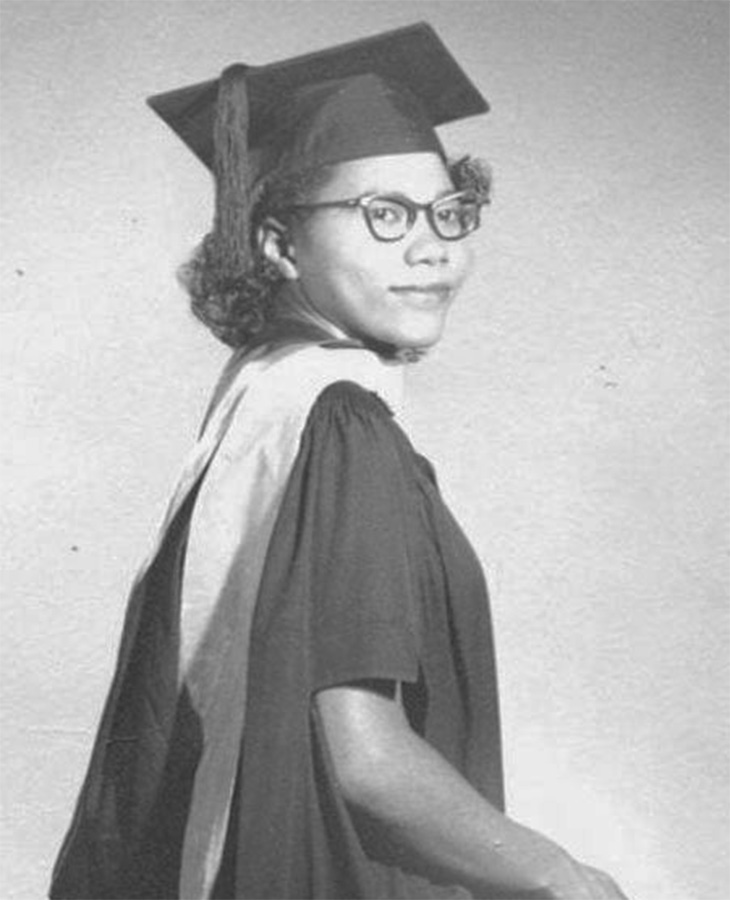 In 1949, she became the first Black student to enroll at what was then Oklahoma A&M
College, now Oklahoma State University. Despite facing segregation and initially being
required to sit outside the classroom, her determination and academic excellence led
to her being allowed to join her classmates. Davis earned her master's degree in home
economics from OSU in 1952 and went on to have a distinguished 43-year career in public
education. She was actively involved in various organizations, including the Oklahoma
City N.A.A.C.P. Youth Council and the Oklahoma Retired Teachers Association.
In 1949, she became the first Black student to enroll at what was then Oklahoma A&M
College, now Oklahoma State University. Despite facing segregation and initially being
required to sit outside the classroom, her determination and academic excellence led
to her being allowed to join her classmates. Davis earned her master's degree in home
economics from OSU in 1952 and went on to have a distinguished 43-year career in public
education. She was actively involved in various organizations, including the Oklahoma
City N.A.A.C.P. Youth Council and the Oklahoma Retired Teachers Association.
Davis received numerous honors, including the OSU Distinguished Alumni Award and the Oklahoma Human Rights Commission's Lifetime Achievement Award. She died on March 23, 2015, at the age of 88.
Deans
A dean is the person in charge of an individual college or school.
The following people serve as deans at Oklahoma State University:
- College of Arts and Sciences: Dr. Melinda Cro
- College of Education and Human Sciences: Dr. Jon E. Pedersen
- College of Engineering, Architecture and Technology: Dr. Hanchen Huang
- Ferguson College of Agriculture: Dr. Jayson Lusk
- OSU Global: Dr. Randy Kluver
- Graduate College: Dr. Melanie Morgan
- Honors College: Dr. Keith Garbutt
- Libraries: Sheila Grant Johnson
- College of Professional Studies: Dr. Craig Freeman
- Spears School of Business: Dr. James Payne
- College of Veterinary Medicine: Dr. Jerry Ritchey
Note: Dean is a different title than Dr. and supersedes Dr.
FIRST REFERENCE: Use Dean
SECOND REFERENCE: Use Dr. (or second-highest title if dean doesn't have doctorate, i.e., military rank, etc.)
Example: Dean John Doe kicked off the ribbon-cutting with a speech. Dr. Doe spoke about the new building's potential.
Demaree Apartments (OSU-Stillwater)
The Demaree Apartments at Oklahoma State University, located in the Demaree Neighborhood, offer unfurnished, two-bedroom/one-bathroom units for students who qualify for year-round housing registration, including families and graduate students.
Built in 1962, these two-story buildings provide ample parking and open green spaces, and are conveniently situated near the University Laundry and the Family Resource Center. The complex is named after James Rex Demaree (Oct. 6, 1923-Sept. 17, 2012), a former assistant director of Residential Life and Stillwater native who was instrumental in constructing and renovating student housing.
The Demaree Apartments are designed to provide a comfortable and convenient living environment for students, with easy access to key campus locations and amenities.
Diesel and Heavy Equipment Lab (OSUIT)
The Diesel and Heavy Equipment Lab at OSU Institute of Technology is a cutting-edge facility that provides students with specialized knowledge and mechanical skills necessary to troubleshoot, maintain and repair modern diesel engines and heavy equipment.
Built in 1956, the lab is part of OSUIT's School of Transportation and Heavy Equipment, which offers an industry-endorsed curriculum and hands-on training with the latest technology and tools.
Through partnerships with major industry players like Caterpillar, Ford, General Motors, Komatsu, MOPAR, Toyota and NAEDA, students gain real-world experience and are well-prepared for high-demand careers in the transportation and heavy equipment industries.
Donald W. Reynolds School of Architecture (OSU-Stillwater)
The Donald W. Reynolds School of Architecture at Oklahoma State University is a state-of-the-art facility that serves as the hub for the university's architecture programs.
Opened in 2009, the building features spacious, naturally lit design studios, an expanded architectural library, and specialized labs for daylighting, digital fabrication and construction. The school offers accredited architecture and architectural engineering degrees, providing students with a comprehensive education combining theoretical knowledge and practical experience.
The facility blends historic and modern architecture, incorporating the renovated 1918 campus Gymnasium and Armory with new wings double the original structure's size. Located at the southwest corner of University Avenue and Hester Street, the Donald W. Reynolds School of Architecture is a cornerstone of the College of Engineering, Architecture and Technology’s commitment to excellence in architectural education.
It is named after businessman and media mogul Donald Worthington Reynolds (Sept. 23, 1906-April 2, 1993), whose foundation provided the building’s primary funding.
Drummond Hall (OSU-Stillwater)
Drummond Hall was a residential building at Oklahoma State University, built in 1966 and named after Frederick Gentner “Gent” Drummond (Jan. 3, 1895-Dec. 4, 1958).
Drummond was a distinguished graduate of OSU who became a leading businessman and rancher in Osage County. Throughout his life, he served as president of OSU’s Alumni Association and was a charter member of the Board of Regents.
Drummond Hall was known for its significant contributions to student housing until its closure. The hall's legacy remains remembered as part of OSU's rich history.
Edmon Low Library (OSU-Stillwater)
Completed in 1953, it is a focal point of campus pride and architectural beauty. The library offers extensive collections, information and technology resources, and six floors are designated for students to work and study. Four are designated for group study noise levels; one is whisper-level noise and one is silent. It houses various specialized collections, including government publications and historical manuscripts. The library also provides numerous services, such as research assistance, study rooms and orientation programs for new students. Located at the heart of the Stillwater campus, the Edmon Low Library supports the academic success of OSU students and faculty.
It is named after Edmon Low (Jan. 4, 1902-Dec. 2, 1983), the head librarian of the OSU Library from 1940-67, the longest tenure in the university’s history.
Note: The Edmon Low Library is the physical location of the main collection. When referring to the location of an event or the building itself, “Edmon Low Library” is appropriate.
Education and Human Sciences (College of)

The College of Education and Human Sciences at Oklahoma State University is dedicated to empowering lifelong learners and bold leaders.
Home to seven departments, the college offers various undergraduate and graduate degree options in fields such as education, health, human development, aviation, design and more.
The official magazine of CEHS is ASPIRE.
The CEHS Dean’s Office is at 106 Nancy Randolph Davis.
The college houses the following departments:
- Department of Community Health Sciences, Counseling and Counseling Psychology
- Department of Design and Merchandising
- School of Educational Foundations, Leadership and Aviation
- Department of Human Development and Family Science
- School of Kinesiology, Applied Health and Recreation
- Department of Nutritional Sciences
- School of Teaching, Learning and Educational Sciences
To view a complete list of majors and minors in the college, visit their website.
FIRST REFERENCE: Always use the full name of the college and each subsequent department on first reference. When writing the college’s name or department's name, spell out and. Do not use an ampersand (&) unless it is part of the official name of an institution, i.e., National Center for Wellness & Recovery. When referencing a department for the first time, always use "Department of" prior to the department.
SECOND REFERENCE: It is acceptable to use "CEHS" on all second references.
Electronics Laboratory (OSU-Stillwater)
The Electronics Laboratory at Oklahoma State University is a cutting-edge facility dedicated to advancing research and education in electronics.
Built in 1978, the lab supports various projects, including analog/mixed-signal design, RF/microwave circuits and systems, terahertz sensing/communication and extreme-environment electronics. Located at the corner of Tyler Avenue and Willis Street, it is equipped with state-of-the-art technology. It provides students and faculty with the resources to conduct innovative research and develop new electronic systems and devices.
FIRST REFERENCE: Use full name "Electronics Laboratory."
SECOND REFERENCE: For all subsequent references, it is acceptable to use the term "ERDL."
Ellis Walker Woods Memorial (OSU-Tulsa)
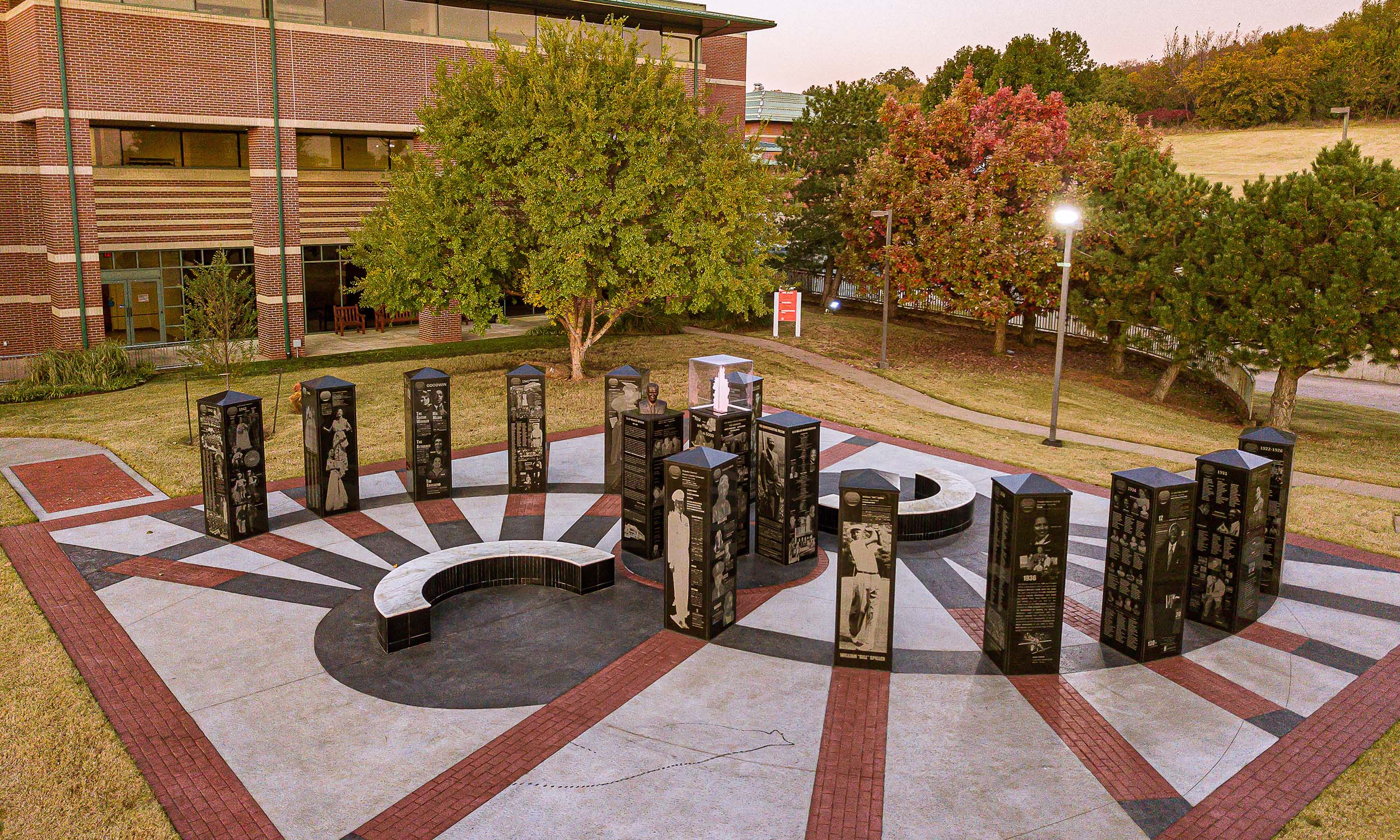
The Ellis Walker Woods Memorial, located at the intersection of Greenwood Avenue and John Hope Franklin Boulevard on the Oklahoma State University-Tulsa campus, honors Ellis Walker Woods Sr. (June 29, 1885-1948), the first principal of Tulsa's Booker T. Washington High School.
This memorial was a labor of love for more than 30 years, guided by a dedicated committee of Booker T. Washington alumni and supporters. It was dedicated on Aug. 16, 2019, and entrusted to OSU-Tulsa for care and maintenance.
The memorial serves as a lasting testament to Ellis Walker Woods' contributions to education and the community, and it is open to the public with free parking available for visitors.
ENDEAVOR Lab (OSU-Stillwater)
The ENDEAVOR Lab at Oklahoma State University is a cutting-edge facility that enhances undergraduate education through hands-on, interdisciplinary learning.
Spanning 72,000 square feet, this state-of-the-art building features advanced technology and equipment worth over $5 million, accessible to students from all OSU colleges. Built in 2018, the lab's open and flexible environment fosters collaboration and innovation, providing spaces for 3D printing, drone testing and advanced measurement techniques.
ENDEAVOR is a key component of OSU's College of Engineering, Architecture and Technology, supporting a paradigm shift toward industry-aligned learning and preparing students for real-world challenges. The ENDEAVOR Lab is between the Advanced Technology Resource Center and the Donald W. Reynolds School of Architecture. The facility's construction cost $35 million, with half of the funding provided by generous donors.
Note: The name of the lab is stylized in all caps.
Energy Conservation Demonstration Unit (OSU-Stillwater)
The Energy Conservation Demonstration Unit at Oklahoma State University is a facility dedicated to promoting energy efficiency and sustainability.
Built in 1980, it is within the College of Engineering, Architecture and Technology. The unit focuses on demonstrating and researching energy conservation techniques and technologies, providing valuable insights and practical solutions for reducing energy consumption. It is located near the corner of McElroy Road and McDonald Street.
It plays a crucial role in educating students and the community about the importance of energy conservation and the benefits of adopting sustainable practices.
FIRST REFERENCE: Use full name "Energy Conservation Demonstration Unit."
SECOND REFERENCE: For all subsequent references, it is acceptable to use the term "ECDU."
England Residence Hall (OSUIT)
England Residence Hall at Oklahoma State University Institute of Technology is one of the on-campus housing options available to students.
Built in 1980, it provides a comfortable and convenient living environment, fostering a sense of community among residents. The hall is equipped with modern amenities and is designed to support the academic and social needs of students. It is named after Paul T. England (Sept. 6, 1913-Aug. 23, 1990), a recruiter and counselor for OSUIT for four decades. England was a Perkins native and the first to receive a master’s degree in recreation from OSU.
Living in England Residence Hall allows students to be close to their classes, campus resources and extracurricular activities, enhancing their overall college experience.
Engineering, Architecture and Technology (College of)

The College of Engineering, Architecture and Technology at Oklahoma State University is committed to fostering innovation and excellence. Home to several departments, the college offers various undergraduate and graduate degree programs in engineering, architecture, technology and more.
The college is dedicated to preparing students to become leaders and innovators in their respective fields, providing them with the skills and knowledge needed to tackle the challenges of tomorrow.
The official magazine of CEAT is IMPACT.
The CEAT Dean’s Office is at 201 Advanced Technology Research Center.
The college houses the following units:
- School of Architecture
- School of Biosystems and Agricultural Engineering (partnership with Ferguson College of Agriculture)
- School of Chemical Engineering
- School of Civil and Environmental Engineering
- School of Electrical and Computer Engineering
- School of Fire, Construction and Emergency Management
- School of Industrial Engineering and Management
- School of Materials, Mechatronics and Manufacturing Engineering (based at OSU-Tulsa)
- School of Mechanical and Aerospace Engineering
To view a complete list of majors and minors in the college, visit their website.
FIRST REFERENCE: Always use the full name of the college and each subsequent department on first reference. When writing the college’s name or department's name, spell out and. Do not use an ampersand (&) unless it is part of the official name of an institution, i.e., National Center for Wellness & Recovery. When referencing a department for the first time, always use "Department of" prior to the department.
SECOND REFERENCE: It is acceptable to use "CEAT" on all second references.
Engineering North (OSU-Stillwater)
Engineering North is a prominent building at Oklahoma State University, housing several key departments within the College of Engineering, Architecture and Technology.
Located by Edmon Low Library on the Stillwater campus, it serves as a hub for engineering education and research, providing state-of-the-art facilities and resources for students and faculty. Initially built in 1964, the building includes classrooms, laboratories and offices for various engineering disciplines, including chemical engineering.
Engineering North has undergone significant renovations, the most recent in the 2010s, to enhance its infrastructure and support the evolving needs of the engineering community. It is crucial in fostering innovation and collaboration among students and faculty, contributing to the university's mission of advancing knowledge and technology.
Engineering South (OSU-Stillwater)
Engineering South is a historic building at Oklahoma State University, initially opened in 1939.
It underwent a multi-million dollar renovation in the early 2020s, transforming its interior while maintaining its original facade. Located by the Edmon Low Library in Stillwater, the revamped building features modern utilities, new classroom spaces and advanced technology. It houses the Zink Center for Competitive Innovation, which supports student teams and fosters collaboration between the College of Engineering, Architecture and Technology and the Spears School of Business.
The renovation includes new restrooms, a state-of-the-art HVAC system and larger elevators. The building houses the Schools of Electrical and Computer Engineering, Civil and Environmental Engineering, and Mechanical and Aerospace Engineering.
Engineering Technology Center (OSU-OKC)
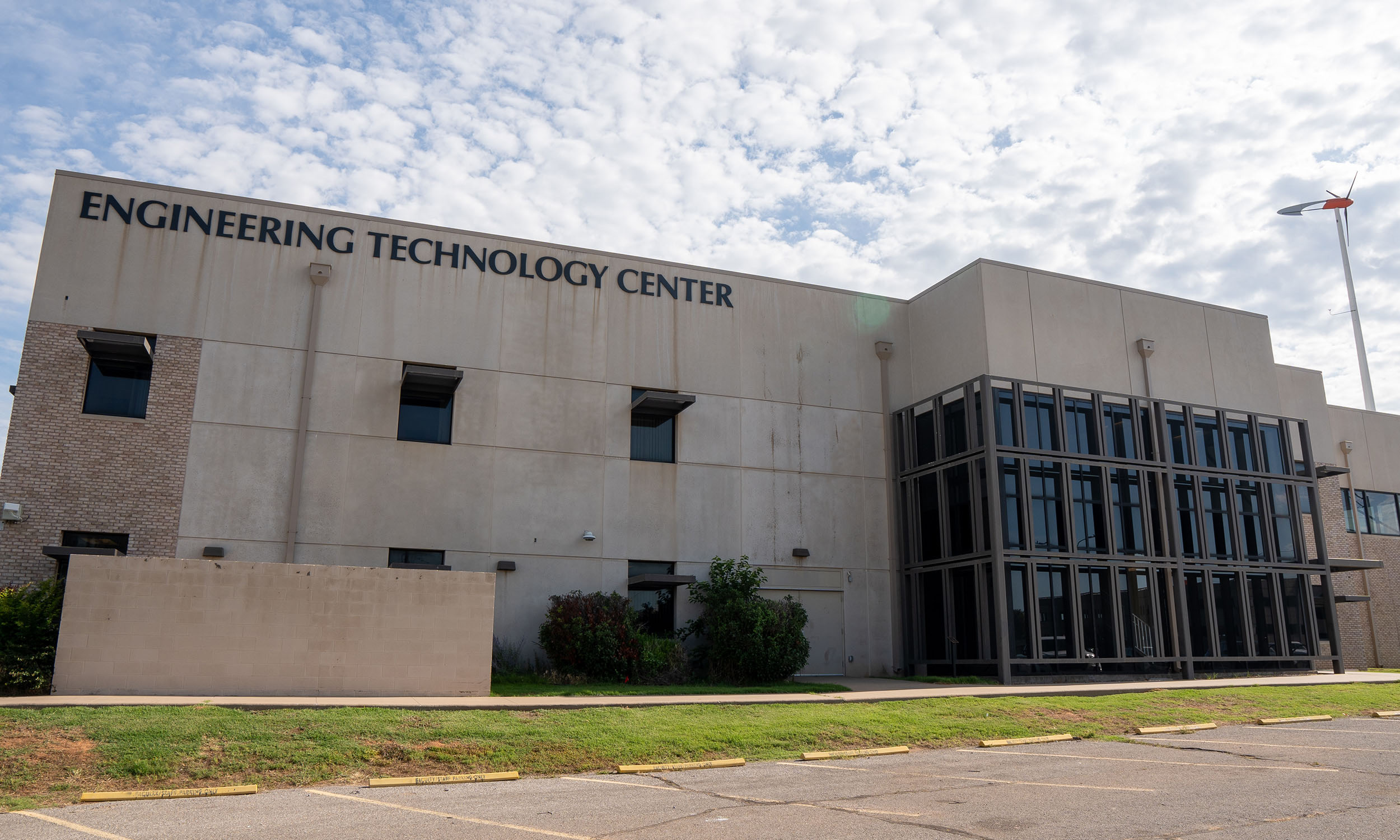
The Engineering Technology Center at Oklahoma State University-Oklahoma City is a central facility dedicated to educating and training students in various engineering disciplines.
This building houses the Engineering Technologies program, which offers courses in electrical, mechanical and civil engineering technology. It is also home to the School of Science, Technology, Engineering and Mathematics. Located at the northern edge of campus, it has state-of-the-art labs and classrooms. The facility provides students with hands-on learning experiences that prepare them for the demands of the modern workforce.
Built in 2011, the Engineering Technology Building reflects OSU-OKC's commitment to providing high-quality technical education and supporting the development of skilled professionals in the engineering field.
FIRST REFERENCE: Use full name "Engineering Technology Center."
SECOND REFERENCE: For all subsequent references, it is acceptable to use the term "ETC."
Enterprise Information Technology
Oklahoma State University's Enterprise Information Technology supports and develops digital technology solutions that help advance the entire OSU/A&M system in education, research and extension.
The department manages enterprise-level technology services for faculty, staff and students, including essential resources like Wi-Fi, O-Key, email and more.
Enterprise Information Technology's primary location is the Information Technology Building, built in 2014, at 414 N McDonald St. Additionally, the department staffs an office in the Classroom Building, the Data Center in the Math Sciences building on the Stillwater campus, and an office in 2314 Main Hall on the OSU-Tulsa campus.
FIRST REFERENCE: Use the full name, "Enterprise Information Technology."
SECOND REFERENCE: For all subsequent references, it is acceptable to use the term "EIT."
Entomological Livestock Research Facility (OSU-Stillwater)
The Entomological Livestock Research Facility at Oklahoma State University-Stillwater is dedicated to advancing research and education in managing livestock pests.
Built in 1994, the facility supports various projects to inform livestock producers about best practices for managing common pests such as ticks, flies, lice and other parasites. The research conducted at this facility contributes to the development of effective pest control strategies, enhancing the health and productivity of livestock.
Located northwest of campus on Sangre Road, the facility is equipped with state-of-the-art technology and provides students and faculty with the resources needed to conduct innovative research in livestock entomology.
Equine Surgery and Sports Medicine Service (OSU-Stillwater)
The Equine Surgery and Sports Medicine Service at Oklahoma State University-Stillwater provides outstanding care for equine athletes and companions, utilizing state-of-the-art diagnostic and therapeutic modalities.
The service is staffed by board-certified equine faculty members and supported by resident and intern veterinarians, veterinary students, and specialized veterinary nurses. The center, which opened in 1973, offers extensive services, including evaluation, diagnosis and treatment of lameness, airway disease, heart irregularities, behavioral issues and emergency surgical procedures.
Located next to McElroy Hall, the facility includes the Gaylord Center for Excellence in Equine Health, the Oxley Family Sports Medicine Arena and designated surgical suites.
Eskridge, James Burnette
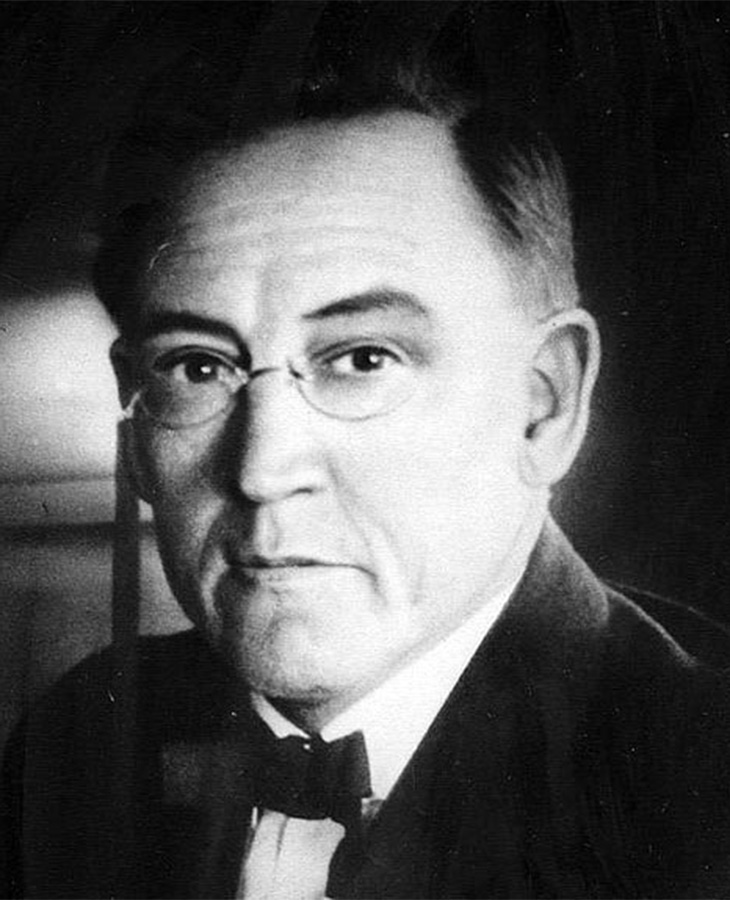 Dr. James Burnette Eskridge (Oct. 24, 1866-April 2, 1952) served as the eighth president
of Oklahoma Agricultural and Mechanical College (now Oklahoma State University) from
1921-23.
Dr. James Burnette Eskridge (Oct. 24, 1866-April 2, 1952) served as the eighth president
of Oklahoma Agricultural and Mechanical College (now Oklahoma State University) from
1921-23.
He earned his master’s degree from Burritt College in Spencer, Tennessee, in 1893, his Ph.D. from Cumberland University in Lebanon, Tennessee, in 1897, as well as another master’s degree and Ph.D. from the University of Chicago in 1903 and 1912, respectively. Before coming to OAMC, he was president at the now University of Science and Arts of Oklahoma in Chickasha and Southwestern Oklahoma State University in Weatherford. In Stillwater, Eskridge focused on helping impoverished students and improving relations with state high schools during his tenure.
His presidency was marked by efforts to enhance the academic environment and support student welfare. However, his term ended abruptly in 1923 when John Calloway Walton, the fifth Oklahoma governor, had the Oklahoma National Guard remove Eskridge from campus to install his political favorite, George Wilson. Eskridge then moved to Tulsa in retirement and Evansville, Indiana, where he died in 1952. He was 85.
EXCELSIOR Laboratory (OSU-Stillwater)
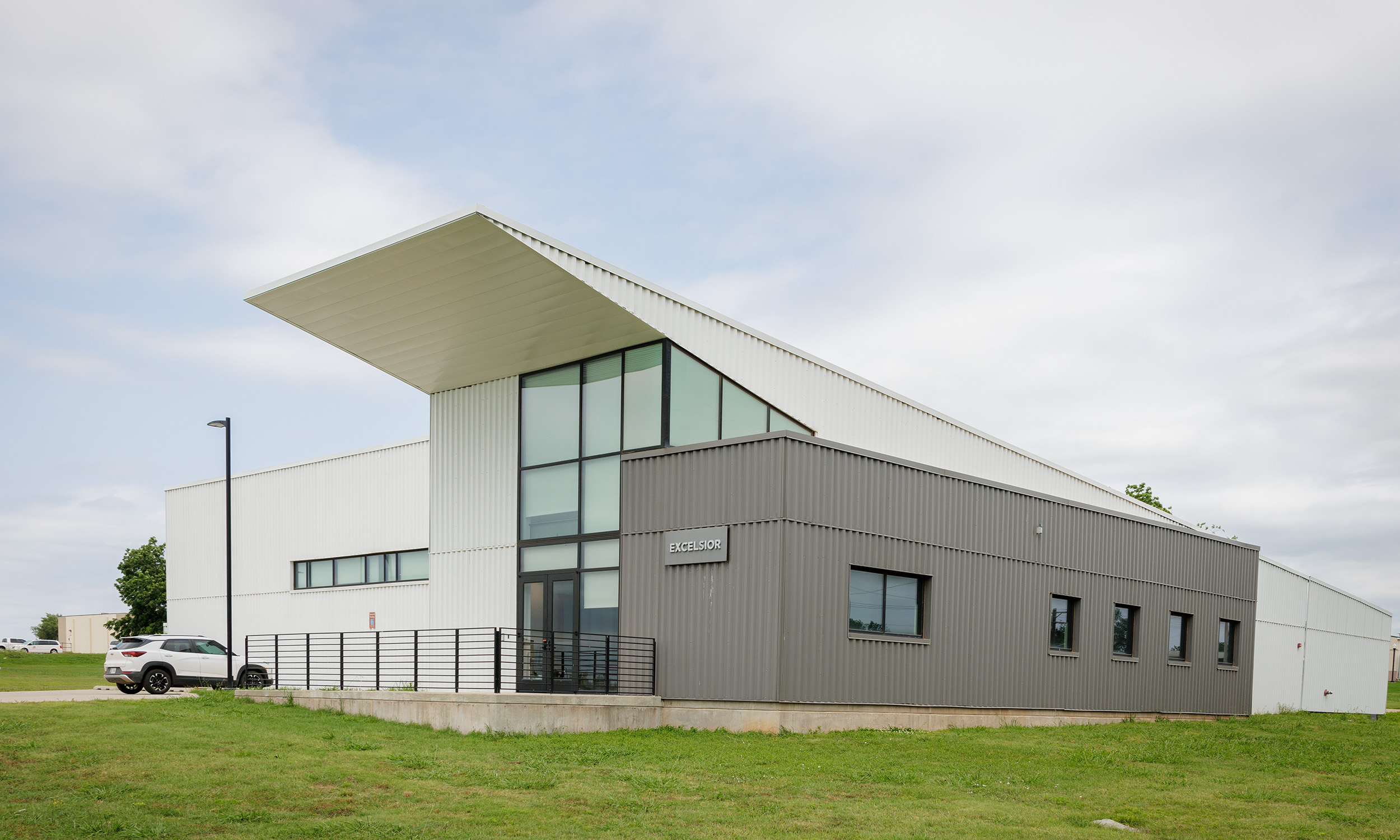
EXCELSIOR is a state-of-the-art research facility at Oklahoma State University that provides a dedicated space for advanced research and development in mechanical and aerospace engineering, including integration, testing and manufacturing.
Opened in 2019, the facility features specialized rooms for electrical manufacturing, 3D printing, composite work and engine testing, as well as a secure integration room. EXCELSIOR supports a wide range of projects related to the environment, ecology, weather, climate change and national security, offering enhanced educational opportunities for students studying aerospace engineering.
The lab's strategic location on Willis Street, closer to the Stillwater campus, facilitates better collaboration and coordination with university and industrial partners.
Note: The name of the lab is stylized in all caps.
Facilities Management
Facilities Management at Oklahoma State University is dedicated to creating an inviting and inspiring campus environment for students, faculty, staff, alumni and visitors.
The department is responsible for maintaining, repairing and renovating over 8.6 million gross square feet of campus space and managing 700 acres of landscape, including 4,050 trees of 131 species. Facilities Management focuses on excellence, innovation and leadership to support the university's education, research and outreach mission. The team works year-round to ensure that every aspect of the campus, from classrooms to grounds, contributes to a positive first impression and a sense of pride for the OSU community.
FIRST REFERENCE: Use the full name, "Facilities Management."
SECOND REFERENCE: For all subsequent references, it is acceptable to use the term "FM."
Faculty/Staff
Faculty and staff are collective nouns that may be used in the singular or in the plural. In either case, the antecedent should agree.
Faculty refers to employees of Oklahoma State University who serve in teaching or research roles.
Staff refers to employees of Oklahoma State University who serve in support or non-academic roles.
Family Resource Center (OSU-Stillwater)
The Family Resource Center at Oklahoma State University is dedicated to supporting the needs of students and their families, particularly those residing in Family and Graduate Student Housing.
Established in 1998, the FRC offers a wide range of programs and services, including a food pantry, loan closet, and various adult and youth activities. The center aims to enhance the quality of life for its residents by providing resources such as conversational English classes, book clubs and sewing clubs. Located at 719 N. Walnut St. in Stillwater, the FRC also features community gardens, a free shopping shuttle and a support group for single parents.
The center fosters community and supports OSU students and their families.
FIRST REFERENCE: Use the full name, "Family Resource Center."
SECOND REFERENCE: For all subsequent references, it is acceptable to use the term "FRC."
Federal Cabinet Departments
Oklahoma State University often works with federal entities. The AP style listing for cabinet departments allows for acronyms on the second reference but cautions against using them too much in an article, as they could confuse the reader.
The following are the U.S. Cabinet departments:
- Department of Agriculture (USDA acceptable on second reference);
- Department of Commerce;
Department of Defense (DOD or Pentagon acceptable on second reference); - Department of Education; Department of Energy (DOE acceptable on second reference);
- Department of Health and Human Services (HHS acceptable on second reference);
- Department of Homeland Security (DHS acceptable on second reference);
- Department of Housing and Urban Development (HUD acceptable on second reference);
- Department of the Interior;
- Department of Justice (DOJ acceptable on second reference);
- Department of Labor;
- Department of State;
- Department of Transportation (DOT acceptable on second reference);
- Department of the Treasury;
- Department of Veterans Affairs (VA acceptable on second reference).
It is preferable to list the subject first in stories, such as the Agriculture Department and Commerce Department. Exceptions are the Department of Health and Human Services, Department of Homeland Security, Department of Housing and Urban Development, and Department of Veterans Affairs.
Felmlee Building (OSU-CHS)
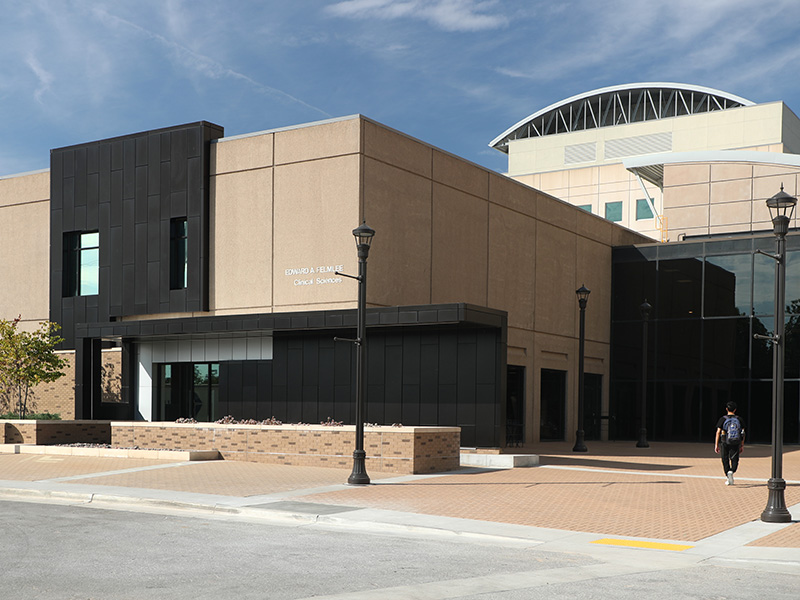
The Felmlee Building at the Oklahoma State University Center for Health Sciences in Tulsa is a key facility that has undergone significant renovations to support the university's mission of advancing medical education and research.
The building is part of the OSU-CHS campus and was built in 1977. It is named after Dr. Edward Felmlee (Jan. 1, 1924-Jan. 4, 2006) former president of the Oklahoma Osteopathic Association and the Oklahoma State Board of Osteopathic Examiners, who was instrumental in developing the OSU College of Osteopathic Medicine.
The Felmlee Building has been renovated to enhance its infrastructure and provide state-of-the-art facilities for students and faculty. These renovations are part of a broader effort to improve the campus and ensure that it meets the needs of the university's growing medical programs.
Ferguson College of Agriculture

The Ferguson College of Agriculture at Oklahoma State University is a dynamic and diverse college offering various academic programs.
Home to several departments, the college provides undergraduate and graduate degree options in fields such as agricultural sciences, natural resources and related disciplines. With a strong emphasis on hands-on learning, students gain practical experience through laboratories, teaching farms and state-of-the-art facilities. The college also offers numerous scholarships, study abroad opportunities and over 60 student organizations and competitive teams, fostering a vibrant and supportive community for students to thrive.
It is named after Kayleen and Larry Ferguson. The Fergusons are avid OSU benefactors who have made significant contributions to the university, including a historic $50 million gift from the Ferguson Family Foundation. This gift is one of the largest commitments to academics in OSU's history and has been instrumental in transforming the former College of Agricultural Sciences and Natural Resources.
The official magazine of the Ferguson College of Agriculture is Cowboy Journal.
The Ferguson College of Agriculture Dean’s Office is at 202 Agricultural Hall.
The college houses the following nine departments:
- Department of Agricultural Economics
- Department of Agricultural Education, Communications and Leadership
- Department of Animal and Food Sciences
- Department of Biochemistry and Molecular Biology
- Department of Biosystems and Agricultural Engineering (Partnership with College of Engineering, Architecture and Technology)
- Department of Entomology and Plant Pathology
- Department of Horticulture and Landscape Architecture
- Department of Natural Resource Ecology and Management
- Department of Plant and Soil Sciences
To view a complete list of majors and minors in the college, visit their website.
Note: The Ferguson College of Agriculture is housed in Agricultural Hall, so please do not use the college's name in reference to the building itself.
Ferguson Family Dairy Center (OSU-Stillwater)
The Ferguson Family Dairy Center, formerly the Dairy Barn, is a state-of-the-art facility dedicated to dairy production and education.
Located on approximately 300 acres of pasture with an additional 80 acres of tillable land, the center features a free-stall barn that houses the entire milking herd, equipped with sand bedding, a robotic milker and designated areas for pre-fresh, maternity, fresh and calf management. Located at the corner of McElroy Road and Marvista Street, the facility includes a double-six herringbone parlor with automated cow identification, milk yield recording and milking unit detachers.
Named for alumni and agricultural benefactors Larry and Kayleen Ferguson, the Dairy Center provides undergraduate and graduate students hands-on experience and research opportunities, making it a vital part of OSU's agricultural education and research programs. The facilities were officially dedicated on April 5, 2018.
Fire and Emergency Services Training Center (OSU-Stillwater)
Known to many Fire Service Training patrons as the “Out West” facility, the Fire and Emergency Services Training Center admirably serves the Oklahoma fire service as its new title implies.
Located south of Highway 51, six miles west of Stillwater, the FESTC is best known as Oklahoma’s major host site for firefighter academies and various live burn training sessions. The training center is 56 acres, with 14 currently secured for fire training. The facility was funded in 1981 by the 1st session of the 38th Oklahoma Legislature through the leadership of Speaker of the House of Representatives Dan Draper Jr. The approved funding was obtained through cooperation with the Oklahoma Commission on Fire Protection personnel standards and education.
The appropriation for the construction of the fire training facility was $550,000. On April 29, 1984, the facility was first used for a Fire Fighter I basic academy course under Harold R. Mace, then director of Fire Service Training.
Fire Protection and Safety Technology Laboratory (OSU-Stillwater)
The Fire Protection and Safety Technology Laboratory at Oklahoma State University is part of the Fire Protection and Safety Engineering Technology program within the College of Engineering, Architecture and Technology.
Built in 2003, this laboratory is dedicated to educating students and researching fire protection, safety engineering and industrial loss control. The FPSET program, which has existed since 1937, prepares students to assess and reduce risks associated with fires, safety hazards, chemical exposures and hazardous materials. The laboratory provides hands-on experience and practical applications of fire protection and safety principles, ensuring that graduates are well-equipped to handle real-world challenges in their field.
FIRST REFERENCE: Use the full name, "Fire Protection and Safety Technology Laboratory."
SECOND REFERENCE: For all subsequent references, it is acceptable to use the term "FPSET" when referring to the Fire Protection and Safety Engineering Technology program.
Fire Protection Publications (OSU-Stillwater)
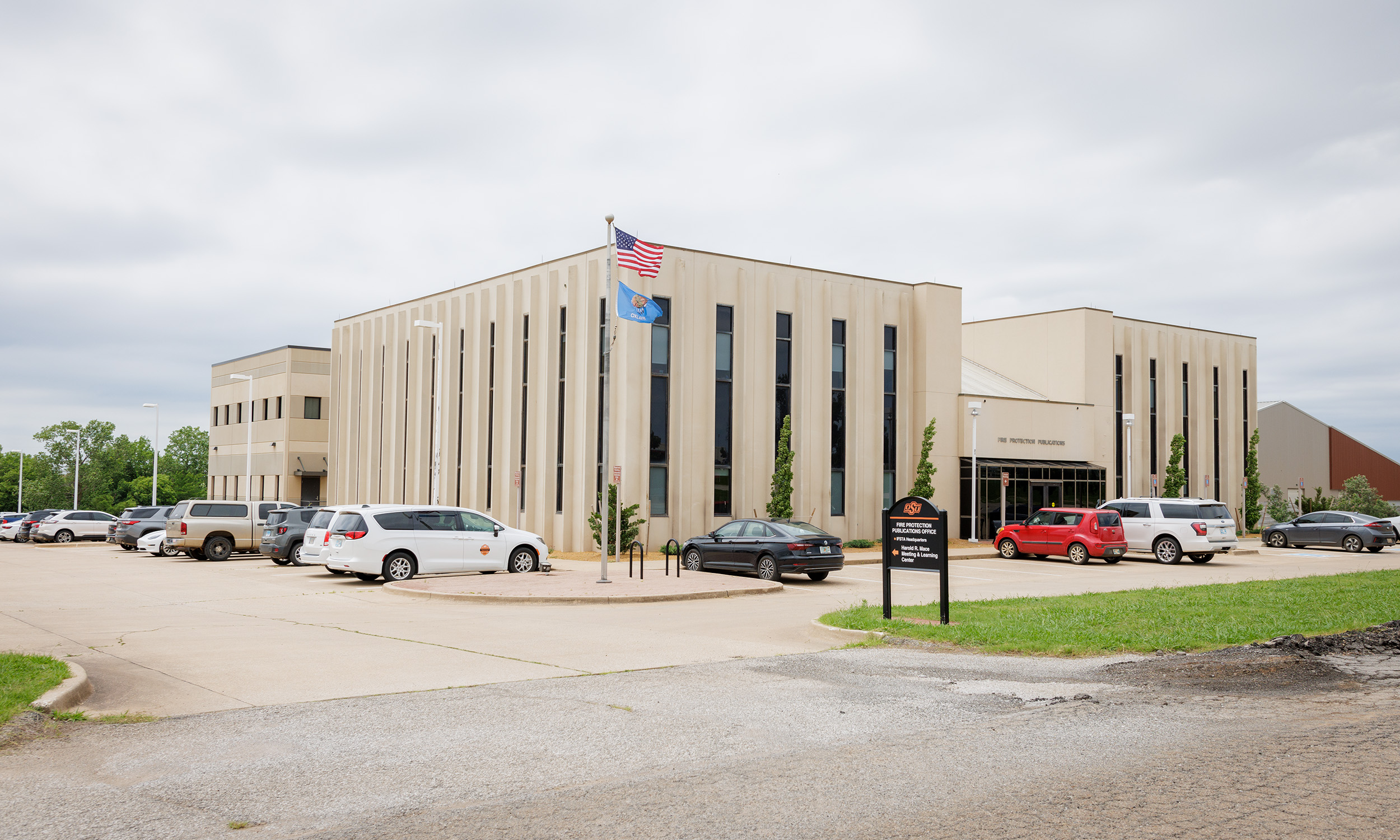
Fire Protection Publications at Oklahoma State University is a leading organization that produces high-quality, technically accurate and state-of-the-art fire training and educational materials.
Established in 1937, FPP collaborates with the International Fire Service Training Association to support OSU’s mission by providing essential resources for the fire service community. Built in 1990, the center is at 930 N. Willis St. in Stillwater. FPP offers a wide range of publications and training programs designed to enhance the safety and effectiveness of fire service professionals.
The organization is committed to innovation and excellence, continually updating its materials to reflect the latest advancements in fire protection and safety engineering.
FIRST REFERENCE: Use the full name, "Fire Protection Publications."
SECOND REFERENCE: For all subsequent references, it is acceptable to use the term "FPP."
Fire Publications and Training (OSU-Stillwater)
Fire Publications and Training, also known as the Mace Center, is vital to Oklahoma State University's College of Engineering, Architecture and Technology.
Named in honor of Harold Raymond Mace (May 23, 1939-Oct 8, 2024), a former director of Fire Protection Publications, the center is dedicated to developing and distributing fire service training materials. Built in 1975, the Mace Center houses the International Fire Service Training Association. Located at the corner of Tyler Avenue and Willis Street, it plays a crucial role in advancing firefighter education and safety through its extensive range of publications and training programs.
Under Mace's leadership, FPP grew to become the world's largest publisher of firefighter training materials, and his legacy continues to influence the center's mission and operations.
Fire Publication Warehouse (OSU-Stillwater)
The Fire Publication Warehouse at Oklahoma State University is a facility that stores and distributes fire service training materials.
Located at 930 N Willis St. in Stillwater, the warehouse is part of the Fire Protection Publications department within the College of Engineering, Architecture and Technology. FPP has been a leader in developing fire and emergency responder training materials since 1934, ensuring firefighters can access validated and up-to-date educational resources.
Built in 1981, the warehouse plays a crucial role in supporting the mission of FPP by efficiently managing the logistics of these essential publications.
Forensic Science and Biomedical Research Building (OSU-CHS)
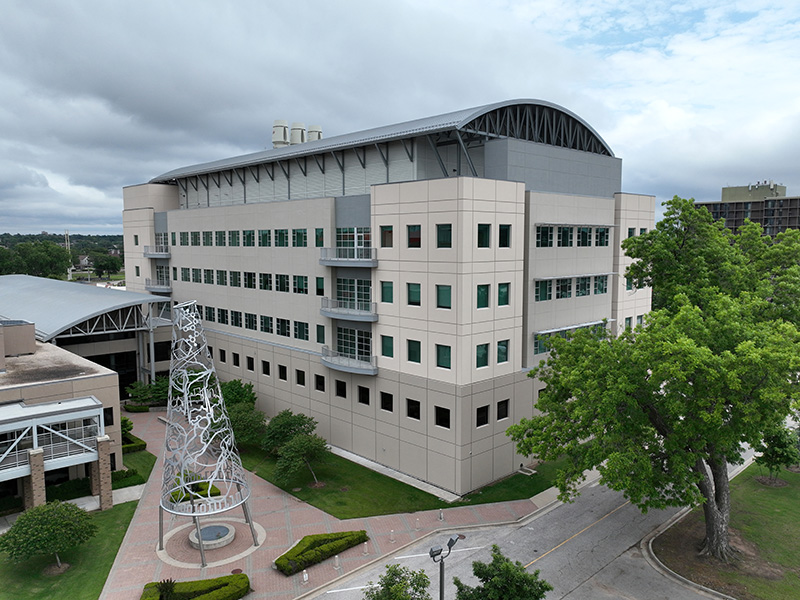
The Forensic Science and Biomedical Research Building at the Oklahoma State University Center for Health Sciences in Tulsa is a state-of-the-art facility dedicated to advancing forensic and biomedical research.
This building houses advanced laboratories and research spaces designed to support cutting-edge studies in forensic sciences, biomedical sciences and clinical research. Built in 2010, the facility is equipped with modern technology and resources that enable faculty and students to conduct high-impact research, contributing to the university's mission of improving health outcomes and advancing scientific knowledge.
The Forensic Science and Biomedical Research Building is a cornerstone of OSU-CHS's commitment to excellence in education, research and community service.
Formal Gardens (OSU-Stillwater)
The Formal Gardens at Oklahoma State University-Stillwater is a beautifully landscaped area located in the heart of the campus, providing a serene and picturesque environment for students, faculty and visitors.
These gardens feature a variety of seasonal plants and flowers, meticulously maintained to ensure vibrant colors and lush greenery throughout the year. The Formal Gardens are not only a place for relaxation and reflection but also serve as a popular spot for campus events, photographs and community gatherings.
The gardens are a testament to OSU's commitment to campus beautification and environmental stewardship.
Founders Hall (OSU-CHS)
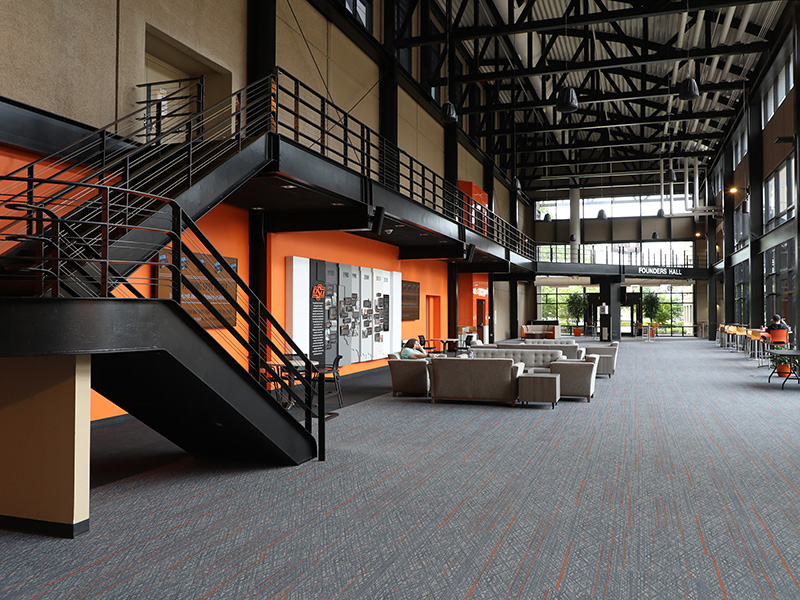
Founders Hall at the Oklahoma State University Center for Health Sciences in Tulsa is a notable building that plays a significant role in the campus's history and development.
Established in 1998, Founders Hall is part of a series of significant transformations the OSU-CHS campus has undergone in its 50-year history. The building is integral to the university's mission of advancing medical education and research and supports various academic and administrative functions.
Fraternity & Sorority Life (Greek Life)
Oklahoma State University offers students the opportunity to experience Greek life through fraternities and sororities.
There are four governing bodies representing these organizations:
- Interfraternity Council
- Multicultural Greek Council
- National Pan-Hellenic Council
- Panhellenic Council
Follow each council’s specific guidelines on how to refer to their respective organizations.
Gallagher-Iba Arena (OSU-Stillwater)
Gallagher-Iba Arena, known as "The Rowdiest Arena in the Country" and "The Madison Square Garden of the Plains," is the basketball and wrestling venue at Oklahoma State University in Stillwater.
Originally completed in 1938 as the 4-H Club and Student Activities Building, it was renamed Gallagher Hall to honor wrestling coach Edward Clark Gallagher (Sept. 5, 1887-Aug. 28, 1940). In 1987, it became Gallagher-Iba Arena, adding the name of legendary basketball coach Henry Payne Iba (Aug. 6, 1904-Jan. 15, 1993). The arena, which has undergone several renovations, retains its historic charm with the original white maple floor and a seating capacity of 13,611.
The court is named after men's basketball coach Edward Eugene "Eddie" Sutton (March 12, 1936-May 23, 2020), who won over 800 games (368 at OSU) as a basketball coach and took the Cowboys to two Final Fours.
GIA remains a central and iconic part of OSU's athletic facilities.
FIRST REFERENCE: Use the full name, "Gallagher-Iba Arena."
SECOND REFERENCE: For all subsequent references, it is acceptable to use the term "GIA."
Garden Apartments (OSUIT)
The Garden Apartments at Oklahoma State University Institute of Technology provide students with a comfortable and convenient living environment.
Built in 1980, these apartments offer a variety of room types, including one-room studio-style apartments for non-traditional residents and two-room studio-style apartments for family residents.
Located next to Covelle Hall, the Garden Apartments are designed to support the academic and social needs of students, ensuring they have access to the resources and amenities needed for a successful college experience.
Gary F. Stewart Core Research Facility (OSU-Stillwater)
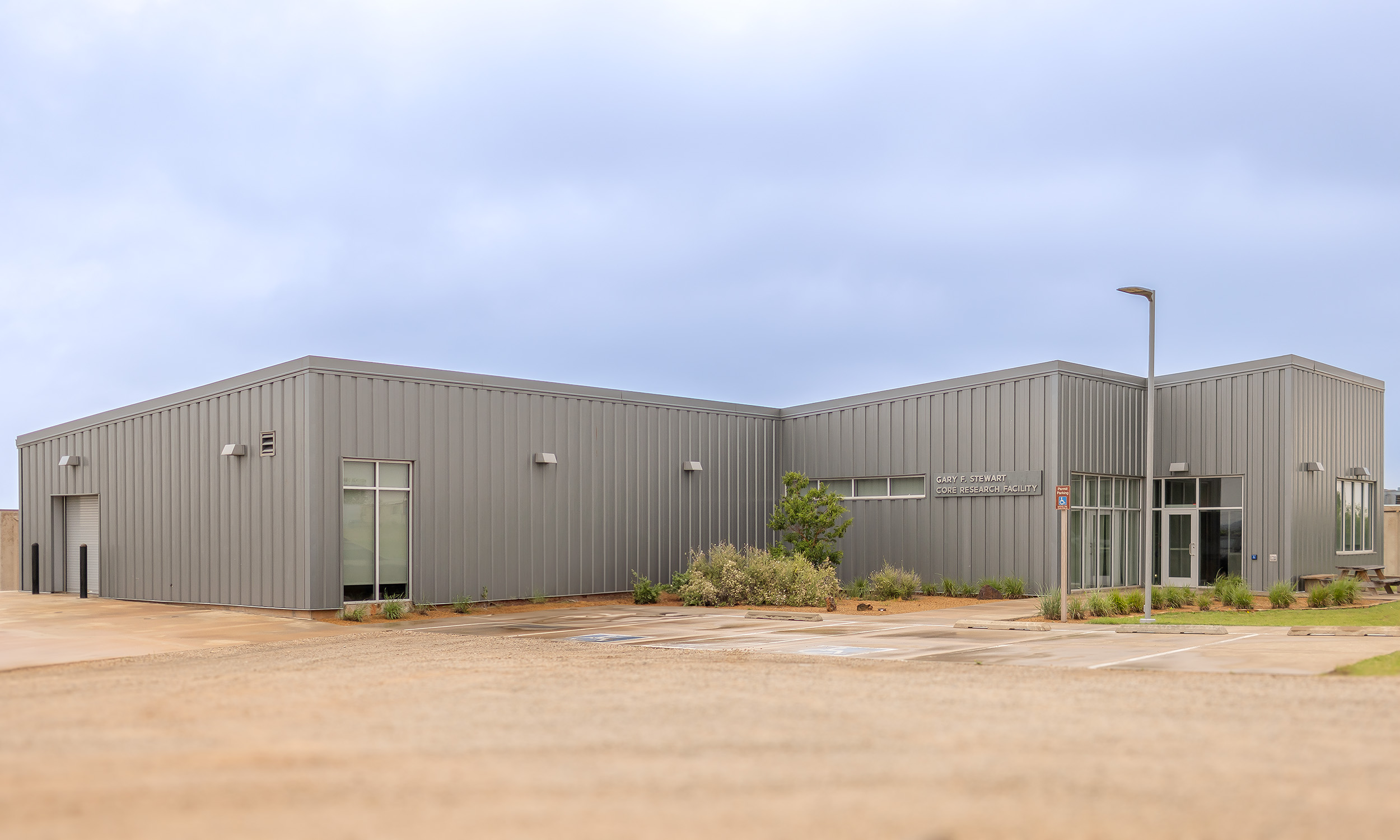
The Gary F. Stewart Core Research Facility at Oklahoma State University is a state-of-the-art research center dedicated to geological studies.
Named after Dr. Gary F. Stewart, a beloved professor who significantly contributed to the field of geology and education at OSU, the facility was dedicated on Nov. 16, 2019. It is a hub for storing and analyzing core samples, equipped with advanced tools such as a grinding and polishing table and an area for thin section preparation. The facility also includes offices, a conference room and workstations, providing a comprehensive environment for faculty and students to conduct active research. It is located near the corner of McDonald Street and Tyler Avenue.
Under the purview of the Boone Pickens School of Geology, the Gary F. Stewart Core Research Facility supports the academic and professional growth of students, particularly those pursuing careers in the oil and gas industry.
General Academic Building (OSU-Stillwater)
The General Academic Building at Oklahoma State University is a central hub for various administrative and academic activities.
Located on the Stillwater campus, it houses several key offices, including the Office of Equal Opportunity and Title IX Coordinator, as well as Human Resources. Built in 1966 as the Business Building, it has been repurposed to house various departments. It provides essential services to students, faculty and staff, making it a vital part of the university's operations.
At the corner of Morrill Avenue and Hester Street, the building's strategic location and comprehensive facilities support various academic and administrative functions, contributing to the university's overall efficiency and effectiveness.
Geothermal Pond (OSUIT)
The Geothermal Pond at the Oklahoma State University Institute of Technology is an innovative feature of the campus's sustainable energy initiatives.
Located by the Nursing Building, this pond utilizes geothermal energy to provide efficient heating and cooling solutions for campus buildings. By leveraging the stable temperatures of the Earth, the geothermal system reduces energy consumption and minimizes the environmental impact.
The pond loop system, consisting of submerged polyethylene piping coils, facilitates heat exchange, making it a key component of OSUIT's sustainability and energy efficiency commitment.
Graduate College
The Graduate College at Oklahoma State University supports students who wish to pursue advanced education beyond a bachelor’s degree. It provides pathways to earn a master’s degree, a doctoral degree, or a graduate certificate. The Graduate College Dean's Office is located at 202 Whitehurst.
FIRST REFERENCE: Use the full name of the college. "The" is not an official part of the name, so it does not need to be capitalized unless dictated by standard grammar rules.
SECOND REFERENCE: Do not abbreviate (GC).
Grady W. Clack Center (OSUIT)
The Grady W. Clack Center at the Oklahoma State University Institute of Technology is a central facility that houses several essential student services, including the Bursar's Office, Financial Aid & Scholarships Office and the Assessment Center.
Built in 1967, it plays a crucial role in supporting students' academic and financial needs by providing resources and assistance related to tuition payments, financial aid and career counseling. The Grady W. Clack Center is conveniently located off of Willham Drive, with office hours from 7:30 am to 4:30 pm, Monday through Friday.
It is named after Grady Wright Clack (April 11, 1911-Aug. 8, 1998), a founding father of OSUIT.
Greenhouse Learning Center (OSU-Stillwater)
The Greenhouse Learning Center at Oklahoma State University is a state-of-the-art facility designed to provide hands-on learning experiences for students in the horticulture and landscape architecture programs.
Opened in 2019, the center features six greenhouses, including an isolated entomology greenhouse and a headhouse with a classroom, office space and plant-preparation area. It is located south of Hall of Fame Avenue between Lincoln and Cleveland streets. The facility is equipped with cutting-edge technology, such as new irrigation systems, climate and humidity control components, and hydroponics systems, to prepare students for careers in the national horticulture industry.
The GLC also supports various research projects and community events, making it a vital resource for education and outreach at OSU.
FIRST REFERENCE: Use the full name, "Greenhouse Learning Center."
SECOND REFERENCE: For all subsequent references, it is acceptable to use the term "GLC."
Greenwood District
The Greenwood District in Tulsa is a historic area known for its significant role in African-American history and culture.
Often referred to as "Black Wall Street," Greenwood was one of the most prosperous African-American communities in the United States during the early 20th century. The district was tragically destroyed during the 1921 Tulsa Race Massacre, which resulted in the deaths of as many as 300 people and the destruction of over 35 square blocks of the neighborhood when white mobs attacked Black residents, homes and businesses in Greenwood from May 31-June 1, 1921. Despite this devastation, the residents of Greenwood rebuilt the district, and it remains a symbol of resilience and community strength.
Today, the Greenwood District is home to several historical sites, including the Greenwood Cultural Center, the Mabel B. Little Heritage House and the John Hope Franklin Reconciliation Park, all within walking distance of the Oklahoma State University-Tulsa campus.
Greiner Family OSU Cross Country Course (OSU-Stillwater)

The Greiner Family OSU Cross Country Course, unveiled in 2019, is a state-of-the-art facility that serves as the home for the OSU men's and women's cross-country teams. Named after Don and Shellie Greiner and Don's father, Ken (Aug. 19, 1938-Feb. 19, 2024), the course stands out as a premier collegiate cross country competition venue.
The Greiner family's significant contributions have not only funded the course but also supported counseling services for student-athletes. Construction of the course began on June 12, 2018, and was completed in July 2019. The course, which consists of just under one million square feet of Astro Bermuda grass, is carved throughout wooded areas and prairie with varying elevations. The course offers multiple loop configurations, including 10K, 8K, 6K, 5K and 2K.
It has hosted prestigious events such as the 2019 Midwest Regional, the 2020 and 2022 NCAA Cross Country Championships, and the 2021 Big 12 Championships. Additionally, OSU, in partnership with the Simon Greiner Track and Field Program, hosts high school track programs and coaching clinics to promote running sports in Oklahoma City.
Note: AP hyphenates cross-country, which is an exception to most writings about the sport.
Griffith Community Center (OSU-Stillwater)
The Griffith Community Center at Oklahoma State University serves as a vibrant hub for student activities and community engagement.
Named after Jim Griffith, a 1975 OSU alumnus and business leader, the center is strategically located at the heart of the North Monroe halls, between Sitlington and Young halls. It offers a variety of amenities, including indoor gathering spaces with recreation and entertainment areas, as well as outdoor patios and landscaped grounds.
The center provides desk services and recreational areas for many residential halls, making it a central spot for students to socialize, study and participate in various events. The Griffith Community Center plays a crucial role in fostering a sense of community and enhancing the student experience at OSU.
Guest House (OSUIT)
The Guest House at Oklahoma State University Institute of Technology provides comfortable and convenient on-campus accommodations for visitors to OSUIT.
Located at the corner of Bennett and Willham drives, the Guest House offers a welcoming environment with modern amenities, making it an ideal choice for short-term stays. Guests can easily access campus facilities, including dining options, recreational areas and academic buildings.
Whether visiting for a conference, a campus tour, or a special event, the Guest House ensures a pleasant and memorable stay for all its visitors.
Gundersen Hall (OSU-Stillwater)
Gundersen Hall is a historic building on the main campus of Oklahoma State University in Stillwater.
Construction began in the fall of 1911 and was completed in November 1912. Initially designed for engineering students, Gundersen Hall now houses faculty offices and computer labs. Located at the corner of Morrill Avenue and Hester Street, the building also includes a foreign language lab for students, providing a space for language learning and cultural exchange.
Gundersen Hall is named for Carl Gundersen, the university's former head of the mathematics department in its early days.
Halligan, James Edmund
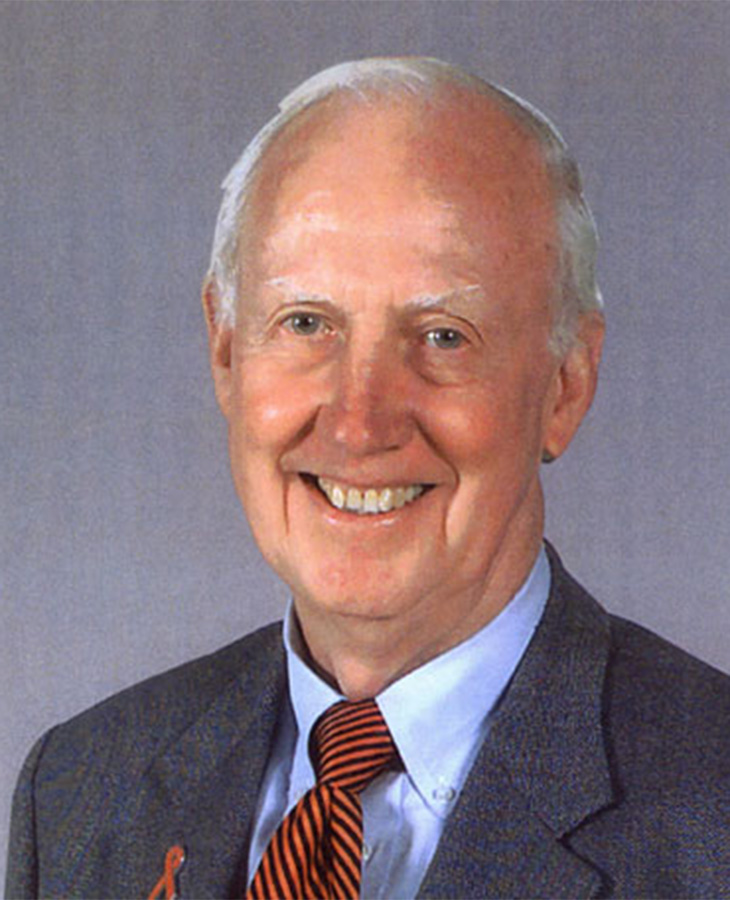 James Edmund Halligan (June 23, 1936-Oct. 25, 2022) served as the 16th president of
Oklahoma State University from 1994 to 2002.
James Edmund Halligan (June 23, 1936-Oct. 25, 2022) served as the 16th president of
Oklahoma State University from 1994 to 2002.
An Air Force veteran, Halligan earned his bachelor’s, master’s and doctoral degrees from Iowa State University. He taught engineering at the University of Arkansas, Texas Tech University and New Mexico State University, where he became president in 1984. At OSU, he was instrumental in increasing retention and graduation rates and invested over $200 million in facilities.
Halligan guided the university through the aftermath of a tragic plane crash in 2001 that claimed the lives of 10 people associated with the men's basketball program. His leadership earned OSU recognition as "America's Best College Buy" and a "Truman Honor Institution."
After retiring from OSU, Halligan continued to serve the community as a state senator from 2008-16. He resided in Stillwater until he died in 2022. He was 86.
Hannigan Residence Hall (OSUIT)
Hannigan Residence Hall at OSU Institute of Technology is one of the on-campus housing options available to students.
It provides a comfortable and convenient living environment, fostering a sense of community among residents. The hall is equipped with modern amenities and is designed to support the academic and social needs of students. Built in 1984, it is named after the late James "Pat" Hannigan, an Okmulgee attorney who donated more than $350,000 to construct the two-story building.
Living in Hannigan Residence Hall allows students to be close to their classes, campus resources and extracurricular activities, enhancing their overall college experience.
Hardesty Center for Clinical Research and Neuroscience (OSU-CHS)
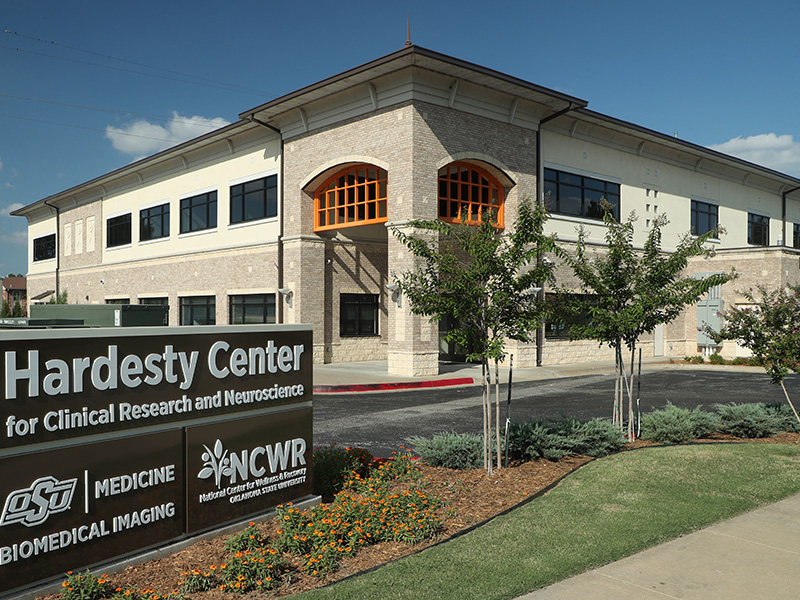
The Hardesty Center for Clinical Research and Neuroscience at Oklahoma State University is a cutting-edge facility in Tulsa.
This 49,000-square-foot center, established with a $2 million gift from The Hardesty Family Foundation, is dedicated to combating addictive behaviors through advanced research and clinical trials. The foundation is named after Floyd Roger Hardesty and Donna J. Hardesty. Located at 1013 E. 66th Place, the center is equipped with the most advanced MRI system in the state. It includes the National Center for Wellness & Recovery clinical trials unit, research initiatives and the OSU Medicine Biomedical Imaging Center.
Officially opened on July 14, 2021, the Hardesty Center reflects OSU's strong commitment to addressing addiction and substance use disorders, making significant contributions to the health and well-being of Oklahomans.
Hargis, Vaden Burns
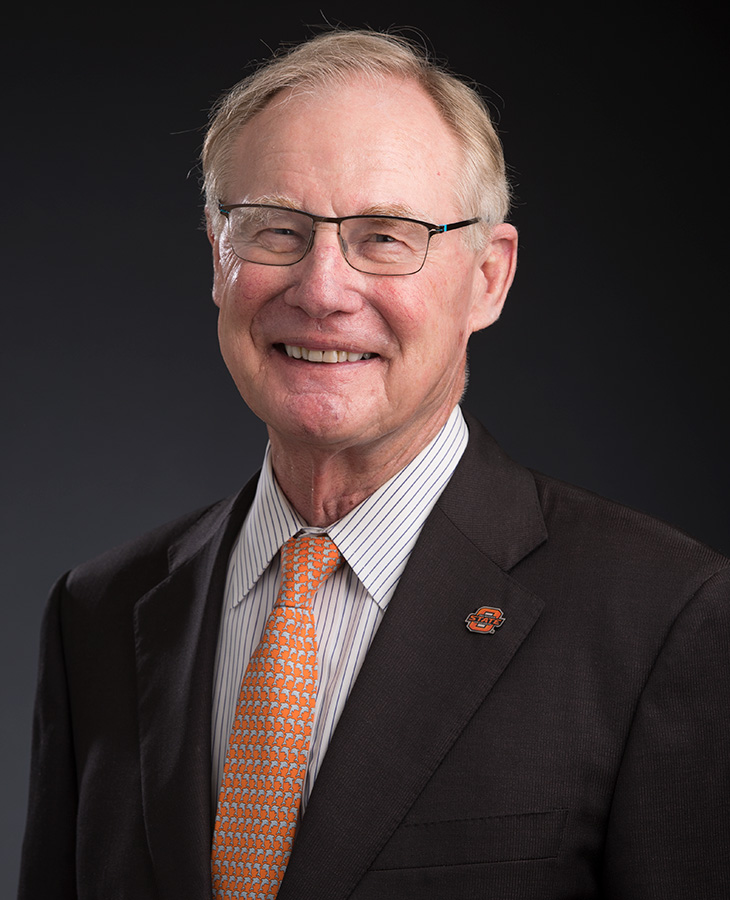 Vaden Burns Hargis (born Oct. 29, 1945) served as the 18th president of Oklahoma State
University from March 10, 2008, to July 1, 2021.
Vaden Burns Hargis (born Oct. 29, 1945) served as the 18th president of Oklahoma State
University from March 10, 2008, to July 1, 2021.
He was instrumental in enhancing the university's infrastructure and academic programs during his tenure, overseeing significant projects such as The McKnight Center for the Performing Arts, the Greenwood School of Music and O’Brate Stadium. Hargis also led the successful "Branding Success" campaign, which raised over $1.2 billion in donations, creating more than a thousand new scholarships and 135 new endowed faculty positions. His leadership extended beyond academics, as he and his wife, Ann Hargis, were dedicated to making OSU America’s Healthiest Campus and were active members of Pete’s Pet Posse.
Hargis' contributions left a lasting legacy, firmly establishing OSU as a modern land-grant institution and a competitive Division I program.
Hazardous Reaction Laboratory (OSU-Stillwater)
The Hazardous Reaction Laboratory at Oklahoma State University is a specialized facility that supports research and education in safely handling and studying hazardous materials.
Built in 1982, the lab is equipped with advanced safety features and state-of-the-art technology to ensure the safe conduct of experiments involving hazardous chemicals and reactions. Located at the corner of Eskridge Avenue and Willis Street, it provides students and faculty with the resources needed to explore the properties and behaviors of hazardous substances, contributing to advancements in chemical safety and engineering practices.
Hazel Ann Seidle Remembrance Garden (OSU-CHS)

The Hazel Ann Seidle Remembrance Garden at the Oklahoma State University Center for Health Sciences in Tulsa is a designated space for gathering, remembering and reflecting on the lives of fellow members of the OSU family who have passed away.
Seidle was a dedicated educator and community member from Tulsa. Born on May 9, 1942, in Durant, Oklahoma, she earned her degree in education from OSU, where she met her future husband, Neal T. Seidle, at OSU's Edmon Low Library. After a brief period in Oklahoma City, the couple moved to Bartlesville, where Hazel taught at Horace Mann Elementary and Douglas Schools. She retired from teaching in 1968. This serene garden provides a peaceful environment for students, faculty and visitors to honor and commemorate those who have made significant contributions to the university community.
The garden's thoughtful design and tranquil atmosphere make it a meaningful addition to the OSU-CHS campus, reflecting the university's commitment to supporting its community through all stages of life.
Helmerich Research Center (OSU-Tulsa)
The Helmerich Research Center at Oklahoma State University-Tulsa is a state-of-the-art facility dedicated to research, development, testing and education in advanced materials and technologies.
Located at the corner of Detroit Avenue and John Hope Franklin Boulevard, the 123,000-square-foot center houses the OSU School of Materials Science and Engineering, the OAIRE LaunchPad Center for Advanced Air Mobility, and the National Center for Wellness & Recovery, along with other various industry partners. It features specialized laboratories, a clean room, an imaging suite, advanced IT equipment and faculty offices. Built in 2007, the HRC focuses on four key research areas: materials for energy technologies, bio-materials for medical technologies, advanced materials for aerospace, and materials for electronics and control technologies. The center also includes high-tech seminar rooms and a spacious atrium for research conferences and interactions.
The HRC is crucial in advancing the region's aerospace, energy, manufacturing, transportation, electronics and medical industries, providing opportunities for OSU students and faculty to collaborate with industry partners. It is named after Walter and Peggy Helmerich, along with The Helmerich Foundation. The Helmerich family pledged $9 million to OSU-Tulsa to create this research and technology development center.
FIRST REFERENCE: Use the full name, "Helmerich Research Center."
SECOND REFERENCE: For all subsequent references, it is acceptable to use the term "HRC."
Henry Bellmon Research Center (OSU-Stillwater)
The Henry Bellmon Research Center at Oklahoma State University is a cutting-edge facility dedicated to interdisciplinary research.
Named in honor of Henry Louis Bellmon (Sept. 3, 1921-Sept. 29, 2009), Oklahoma's first Republican governor and a staunch advocate for education and research, the HBRC was dedicated on Sept. 9, 2011. This $70 million, 124,000-square-foot facility brings together over 200 faculty members, post-doctoral students and graduate students to tackle critical issues related to energy, food safety, cancer treatment and more.
Located at the corner of Farm Road and Monroe Street, the HBRC has advanced research tools, including Nuclear Magnetic Resonance machines, and is designed to foster collaboration across multiple disciplines.
FIRST REFERENCE: Use the full name, "Henry Bellmon Research Center."
SECOND REFERENCE: For all subsequent references, it is acceptable to use the term "HBRC."
Hess, James Daniel
Dr. James Daniel Hess, a native of Henryetta, Oklahoma, was appointed as the 20th
president of Oklahoma State University in 2025 after serving as interim president
since February of the same year.
Hess earned his bachelor's and master's degrees at Northeastern State University in Tahlequah before completing his doctorate at OSU.
Hess began his career at Rogers State College in Claremore in 1981, holding various senior leadership positions for 15 years. In 1996, he became vice president for administration at Rogers University, formed by merging the University Center at Tulsa and Rogers State. When the institutions separated two years later, he was appointed transition CEO to create OSU-Tulsa and Rogers State University. From 1999 to 2003, Hess served as vice president and chief operating officer at OSU-Tulsa, where he doubled enrollment and established the Big Orange Bus (BOB) shuttle service between Tulsa and Stillwater.
He has over four decades of experience in Oklahoma higher education, including roles as vice provost for graduate programs at the OSU Center for Health Sciences and CEO of the OSU Veterinary Medicine Authority. Hess has been instrumental in advancing OSU's land-grant mission, emphasizing student success and strengthening connections within the university community.
Homecoming
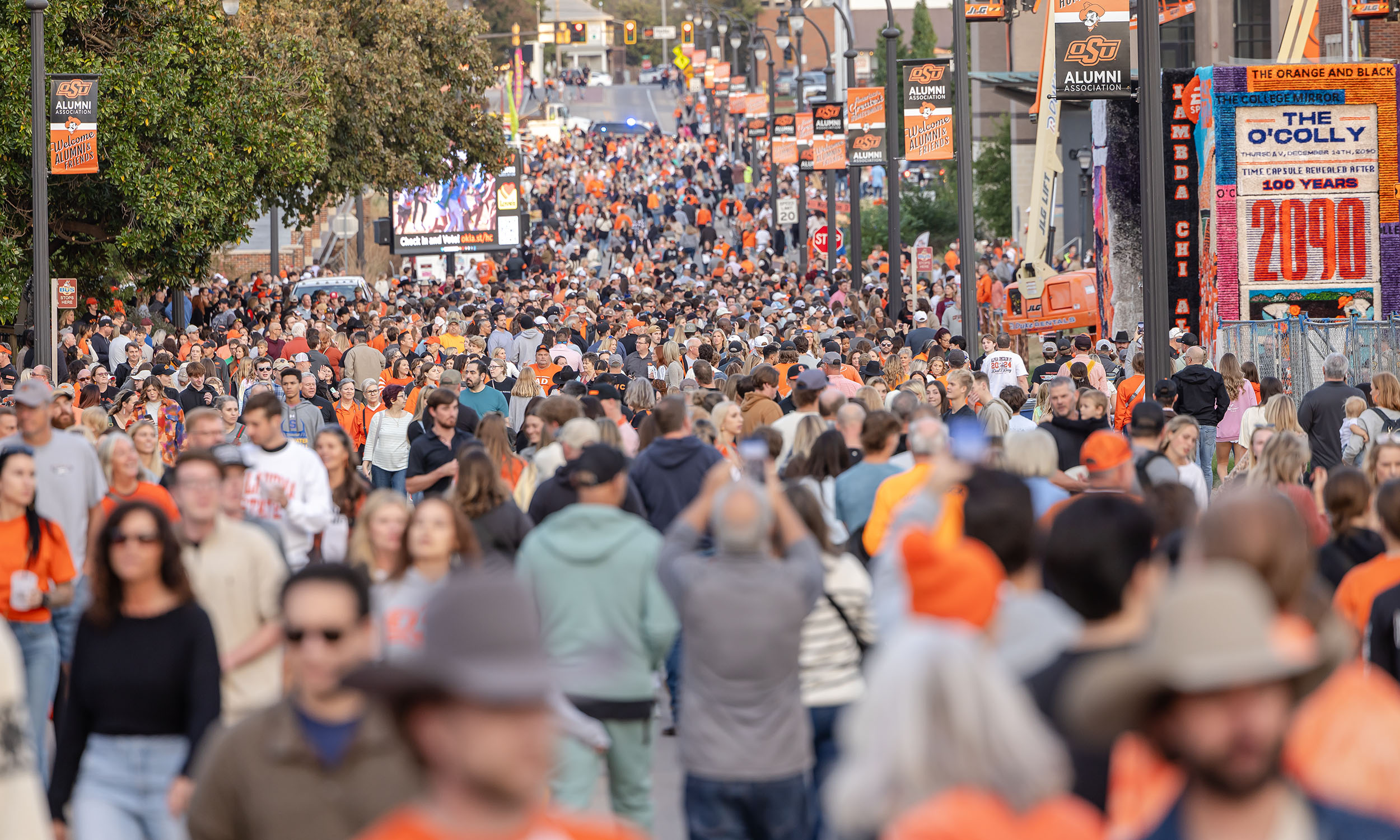
Widely publicized as America’s Greatest Homecoming, OSU Homecoming is a vibrant, weeklong tradition that unites Oklahoma State University alumni, students and the Stillwater community each fall.
First held in 1913 as part of the Harvest Carnival and officially organized by the OSU Alumni Association in 1920, the celebration has grown to attract more than 80,000 alumni annually. Signature events include Walkaround, Sea of Orange Parade, Harvest Carnival and the Homecoming football game, all of which showcase student creativity and Cowboy spirit. The event is executed by more than 150 students serving on three committees as well as thousands more participating through numerous OSU living groups and student organizations.
Since 2021, OSU Homecoming has been sponsored by Love’s Travel Stops, and the Homecoming and Student Programs Endowment is active in ensuring the continuation of this cherished tradition for future generations.
Note: Homecoming is capitalized when referring to OSU’s celebration. Walkaround is also capitalized as one word.
Honors College
The Honors College at Oklahoma State University offers an enriching academic experience for undergraduate students from various majors across campus.
Students admitted to OSU and the Honors College are also enrolled in a disciplinary college, where they pursue one of the available majors and concentrations offered by that college.
Note: Always use the full name of the college in all references. Do not use "College of Honors" or "HC."
Horticulture Education Center (OSU-Stillwater)
The Horticulture Education Center at Oklahoma State University-Stillwater is a vital facility near the south entrance of The Botanic Garden at OSU.
This 2,100-square-foot center, which opened in December 2023, features a large classroom, office space and restrooms. It serves as an educational hub for students, faculty and the community, offering formal and informal learning opportunities about plants, gardening and sustainable practices. The center aligns with OSU's land-grant mission by providing a space for community engagement and knowledge sharing, supported by funding from the Tobacco Settlement Endowment Trust, OSU Department of Horticulture and Landscape Architecture, and private donors.
The Horticulture Education Center is an essential resource for enhancing educational programming and fostering a deeper connection to horticulture within the community.
Horticulture Pavilion (OSU-OKC)
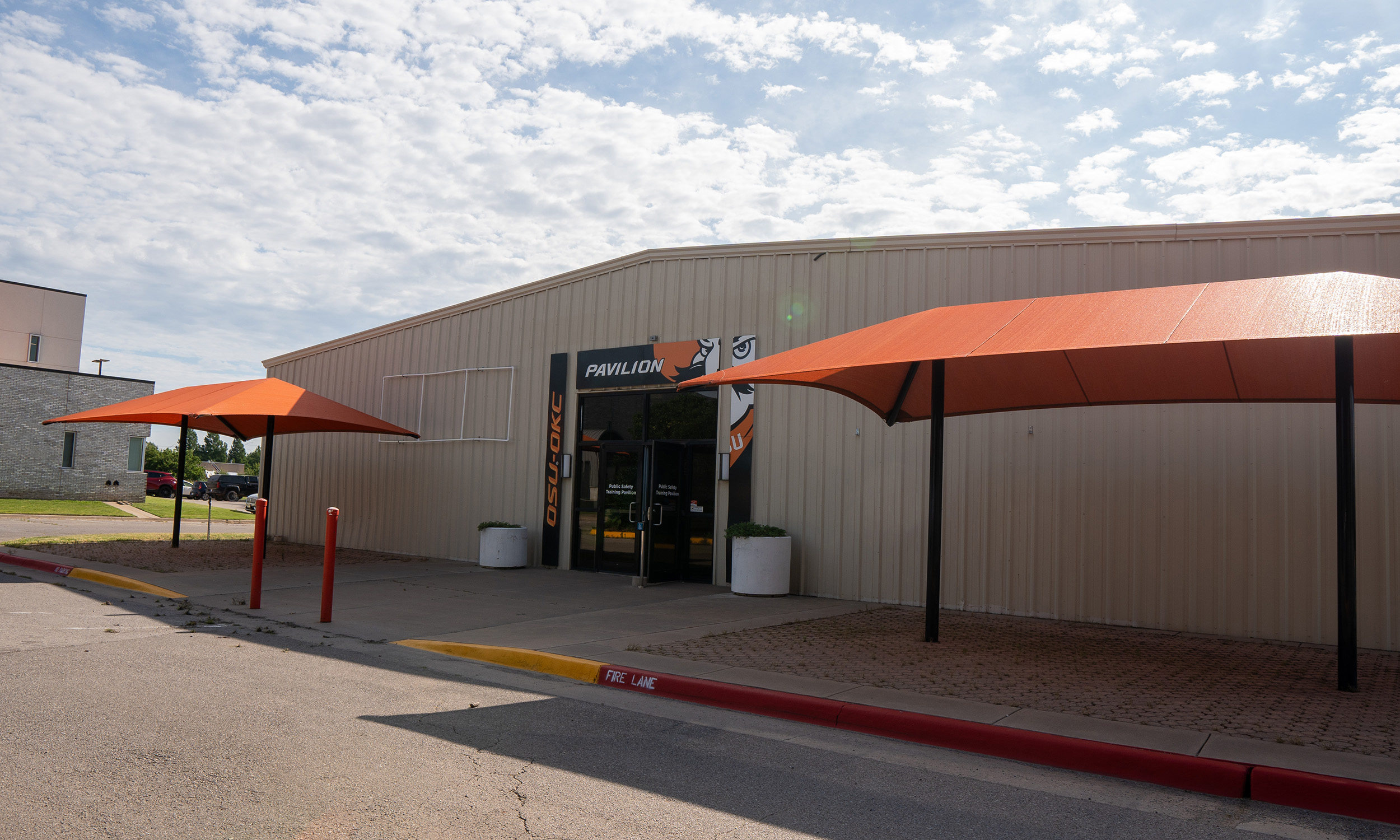
The Horticulture Pavilion at Oklahoma State University-Oklahoma City is a versatile facility that plays a significant role in the university's agricultural and horticultural programs.
This pavilion is not only used for educational purposes but also serves as the venue for the OSU-OKC Farmers Market, which operates year-round every Saturday, providing a platform for local vendors and a community gathering spot. The pavilion's location at 400 N. Portland Ave. makes it easily accessible and a central hub for various horticultural activities.
Additionally, the pavilion supports the university's commitment to sustainable practices and community engagement, reflecting OSU-OKC's dedication to fostering a strong connection between education and the local community.
H.S. Mendenhall Observatory (OSU-Stillwater)
The H.S. Mendenhall Observatory at Oklahoma State University is a premier astronomical research facility off 44th Street southwest of Stillwater.
It houses the largest and most advanced telescope within 300 miles. It is a 24-inch telescope designed for astrometry, photometry and multicolor imaging of celestial objects such as near-Earth asteroids, transiting exoplanets and quasars. The observatory also features portable 8- and 14-inch telescopes for visual observing, particularly by OSU's introductory astronomy students. The facility includes a heated and cooled control building with a restroom, kitchenette, telescope control room and equipment storeroom, making it well-suited for research and instruction.
Named after Harrison Shepler Mendenhall (Feb. 2, 1903-March 20, 2000), OSU's first astronomer, the observatory continues to support the academic and professional growth of students in physics, engineering and related fields.
Human Services Education Center (OSU-OKC)
The Human Services Education Center at Oklahoma State University-Oklahoma City is a dedicated facility that supports the university's commitment to training professionals in various human services fields.
This center houses programs that prepare students for careers in areas such as addiction counseling, crime victim/survivor services, early care education, fire protection, interpreter training and police science. Located at the corner of Reno Avenue and Will Rogers Expressway, the building has modern classrooms and labs, providing students with hands-on learning experiences essential for their future roles in social services and public safety.
Built in 2000, the HSEC reflects OSU-OKC's dedication to addressing the community's educational needs and fostering a skilled workforce.
FIRST REFERENCE: Use the full name, "Human Services Education Center."
SECOND REFERENCE: For all subsequent references, it is acceptable to use the term "HSEC."
Iba Hall (OSU-Stillwater)
Iba Hall is a dormitory at Farm Road and Cleveland Street in the heart of Oklahoma State University's Stillwater campus.
Named after the legendary OSU men’s basketball coach Henry Payne Iba (Aug. 6, 1904-Jan. 15, 1993), the hall offers traditional residential experiences with coed living arrangements, where individual rooms are same-gender. Constructed in 1967, Iba Hall features four floors and accommodates approximately 240 residents. The building includes amenities such as community bathrooms with private stalls and showers, a community kitchen, free unlimited laundry facilities, living rooms/lounges and a meditation room.
Its central location provides easy access to various campus facilities, including the Colvin Recreation Center, Central Market Place and several academic buildings. Iba Hall continues to be a popular choice for students seeking a convenient and comfortable living environment on campus.
Institute for Teaching and Learning Excellence
The Institute for Teaching and Learning Excellence at Oklahoma State University is dedicated to supporting excellence in teaching across the Stillwater campus.
ITLE provides a wide range of resources and services, including training and consultation on innovative teaching strategies, high-quality video production, multimedia creation and state-of-the-art instructional technology. Founded in the early 1980s, the institute also offers professional development opportunities for faculty, instructors and graduate teaching assistants to enhance student engagement and success.
ITLE's initiatives include the AI Integration Program, which helps integrate AI tools into courses and provides online course templates to support virtual classrooms.
FIRST REFERENCE: Use full name "Institute for Teaching and Learning Excellence."
SECOND REFERENCE: For all subsequent references, it is acceptable to use the term "ITLE."
Institutional Titles
A formal title is capitalized when it precedes a name but is not capitalized when it follows a name.
Ex:
President John Doe
Dean Jane Doe
Chairwoman Jane Doe
Interim Chairman John Doe
But
Ex:
John Doe, president
Jane Doe, dean
Jane Doe, chairwoman
John Doe, interim chairman
International Mall (OSU-Stillwater)
The International Mall at Oklahoma State University-Stillwater is a large grassy area located on the north side of the Edmon Low Library and south of the Noble Research Center.
Established in 1966, the mall was created to signify OSU's leadership in international development, world peace and goodwill among all peoples. The International Mall also boasts an international flag plaza representing the diverse international student population at OSU.
This picturesque space is a popular spot for campus events, gatherings and tailgating during game days.
John Kirkpatrick Agriculture Resource Center (OSU-OKC)
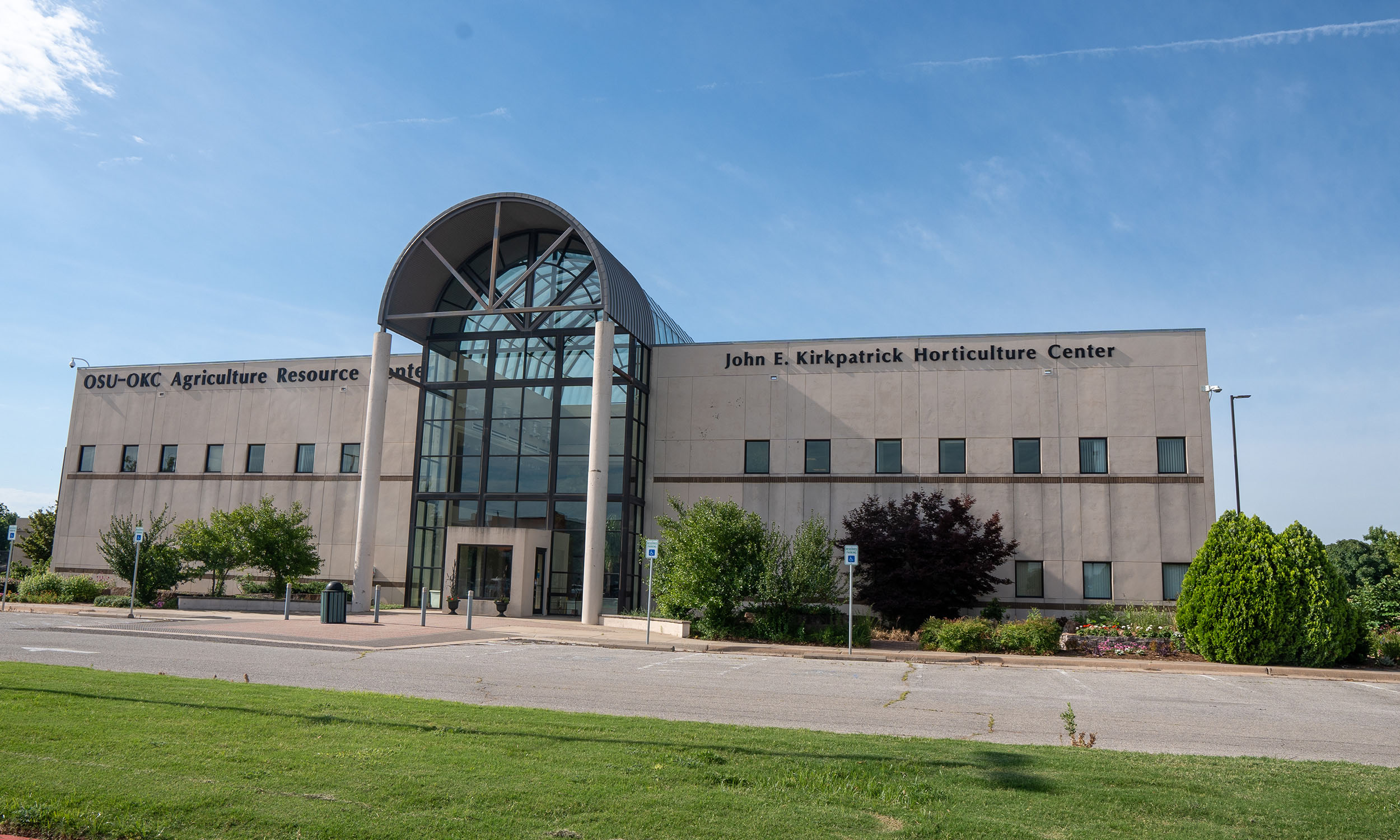
The John Kirkpatrick Agriculture Resource Center at Oklahoma State University-Oklahoma City is a state-of-the-art facility for advancing agricultural education and research.
This 33,000-square-foot center was made possible by a generous $1 million gift from Oklahoma City philanthropist John Elson Kirkpatrick (Feb. 13, 1908-Oct. 4, 2006), marking the largest one-time private gift in OSU-OKC's history.
Built in 2008, the center is adjacent to the existing John E. Kirkpatrick Horticulture Center and features two separate wings flanking a large, open area with a high, barrel-vaulted ceiling. It serves as a hub for the university's agriculture programs, providing modern classrooms, labs and resources to support the growth and development of students and faculty in agriculture.
John Kirkpatrick Horticulture Center (OSU-OKC)

The John Kirkpatrick Horticulture Center at Oklahoma State University-Oklahoma City is an 11,000-square-foot facility dedicated to the study and practice of horticulture.
This center is part of the Horticulture Technologies Department, which offers programs such as the Associate in Applied Science in Horticulture Technology and certificates in Horticulture and Retail Floral Design. Named after Oklahoma City philanthropist John Elson Kirkpatrick (Feb. 13, 1908-Oct. 4, 2006), the center supports various educational activities, including hands-on training and sustainable practices. It is located at 400 North Portland Ave. in Oklahoma City.
Built in 1984, the John Kirkpatrick Horticulture Center reflects OSU-OKC's commitment to providing high-quality education in plant science and horticulture, fostering a strong connection between students and the local community.
Kamm, Robert Balthasar
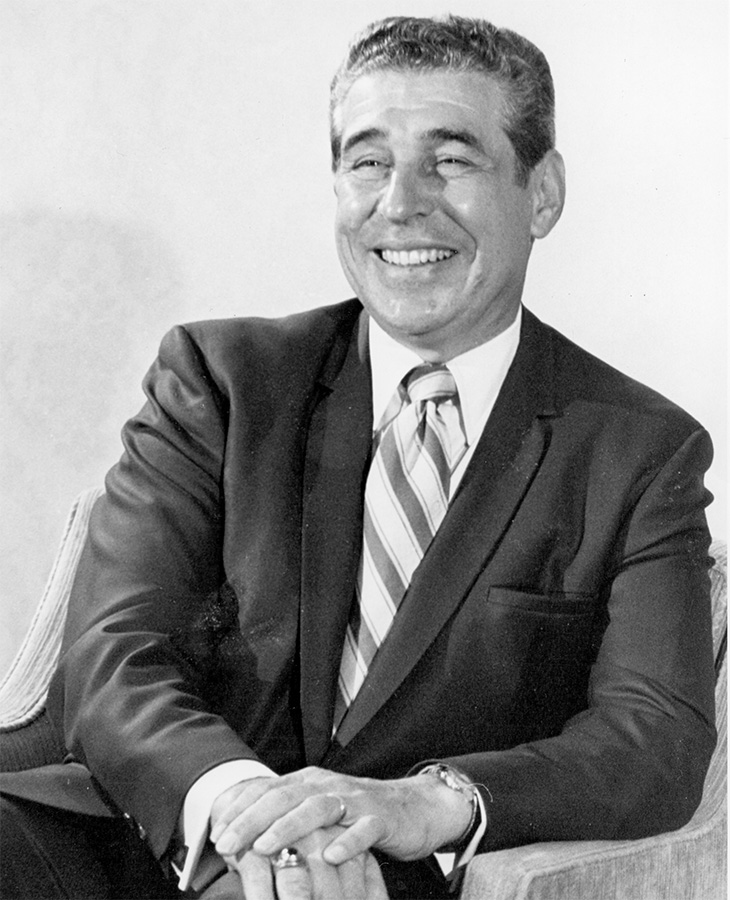 Dr. Robert Balthasar Kamm (Jan. 22, 1919-Oct. 10, 2008) served as the 13th president
of Oklahoma State University from July 1, 1966, to Jan. 31, 1977.
Dr. Robert Balthasar Kamm (Jan. 22, 1919-Oct. 10, 2008) served as the 13th president
of Oklahoma State University from July 1, 1966, to Jan. 31, 1977.
A Navy veteran, he received his bachelor’s degree in English and speech from the University of Northern Iowa in 1940 and his master’s and Ph.D. from the University of Minnesota in 1946 and 1948, respectively. He was dean of the OSU College of Arts and Sciences before becoming president. During his tenure, he led the university through significant growth and development, enhancing its academic programs and infrastructure.
Kamm was known for his dedication to higher education, having previously served in various academic and administrative roles at institutions such as Drake University and Texas A&M University. He was also recognized for his contributions to the field of education, receiving numerous awards and honors, including induction into the Oklahoma Hall of Fame and the Oklahoma Educators Hall of Fame. He was instrumental in the Oklahoma Centennial Series of books to celebrate OSU’s 100th anniversary.
Kamm died in Okmulgee in 2008. He was 89.
Kamm Hall (OSU-Stillwater)
Kamm Hall at Oklahoma State University is a three-story residential building at the corner of McFarland Street and Farm Road, adjacent to the OSU College of Veterinary Medicine and Pattillo Community Center.
Named in honor of Dr. Robert Balthasar Kamm (Jan. 22, 1919-Oct. 10, 2008), who served as the 13th OSU president from 1966-77. and his wife, Maxine (Nov. 24, 1919-Aug. 4, 2004), Kamm Hall accommodates approximately 96 undergraduate students from various classifications and majors. Built in 2000, the hall features four-bedroom, two-bathroom apartments, each equipped with a living room, kitchen and utility room.
Residents enjoy central heating and air conditioning, a washer/dryer set and pet-friendly policies.
Karsten Creek Golf Club (OSU-Stillwater)
Karsten Creek Golf Club is the home of the Oklahoma State University golf program.
Designed by Tom Fazio and opened in May 1994, the course stretches over 7,400 yards with SR1020 bent-grass greens and zoysia fairways and was honored as the Best New Public Course for 1994 by Golf Digest Magazine. Named to honor Karsten Solheim (Sept. 15, 1911-Feb. 16, 2000), the founder of Karsten Manufacturing and PING, and his wife Louise (June 6, 1918-July 8, 2017), the course has received numerous accolades, including a five-star rating from Golf Digest in 1998.
Karsten Creek has hosted multiple prestigious events, including the NCAA Men's Golf Championships in 2003, 2011 and 2018. The course features dramatic elevation changes, native oak trees and a $4.5 million state-of-the-art clubhouse completed in 2001. It also boasts an elaborate practice facility used exclusively by the men's and women's golf teams.
Karsten Creek is about six miles west of Stillwater, off Highway 51 at 1800 S. Memorial Drive.
Kern-Headington Terrace (OSU-CHS)
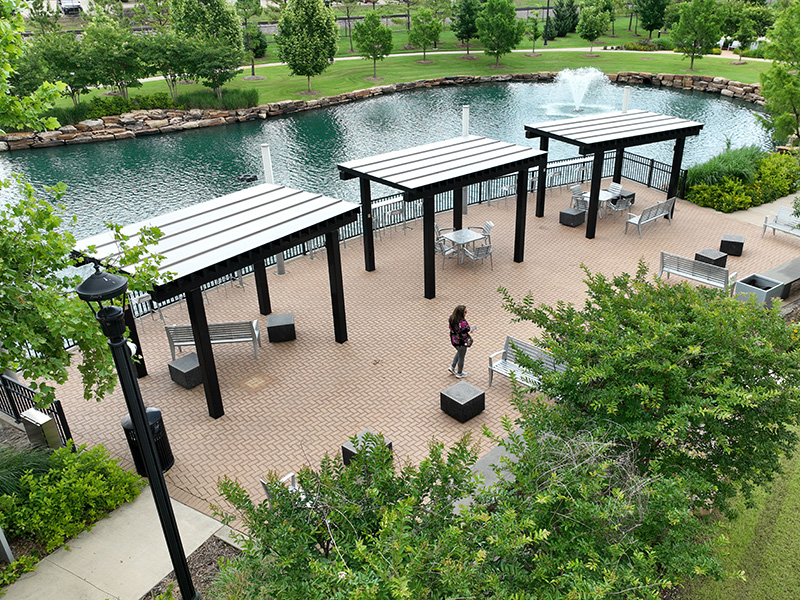
The Kern-Headington Terrace at the Oklahoma State University Center for Health Sciences in Tulsa is a notable outdoor space that provides a serene environment for students, faculty and visitors.
This terrace is part of the Kern-Headington Student Center, which offers various amenities and services to support the campus community. It is named after Senior U.S. District Judge Terence Kern and his wife, Jeanette, along with Jeanette's brother, Timothy C. Headington. Terence Kern is a 1966 OSU graduate who has supported the OSU College of Osteopathic Medicine. Headington is an American billionaire, the CEO and owner of Headington Oil, and a notable philanthropist. He has supported various educational and health care initiatives, including those at OSU.
The terrace is often used for relaxation, social gatherings and campus events, contributing to the vibrant and welcoming atmosphere at OSU-CHS. It is a key feature of the campus, reflecting the university's commitment to creating a supportive and engaging environment for all its members.
Kerr Hall (OSU-Stillwater)
Kerr Hall at Oklahoma State University, built in 1966, was named in honor of Robert Samuel Kerr (Sept. 11, 1896-Jan. 1, 1963), the first Oklahoma-born governor.
This residential hall, a duplicate of Drummond Hall, was a significant housing facility on campus for many years. However, the university plans to demolish Kerr Hall to make way for new developments. The hall's legacy remains a part of OSU's rich history, reflecting its commitment to providing quality student housing and fostering a vibrant campus community.
Knapp, Bradford
 Bradford Knapp (Dec. 24, 1870-June 11, 1938) served as the 10th president of Oklahoma
Agricultural and Mechanical College (now Oklahoma State University) from 1923-28.
Bradford Knapp (Dec. 24, 1870-June 11, 1938) served as the 10th president of Oklahoma
Agricultural and Mechanical College (now Oklahoma State University) from 1923-28.
He attended Iowa State University before transferring to Vanderbilt University, where he earned his bachelor’s degree in chemistry in 1892. He received his Bachelor of Laws degree in 1894 from the University of Michigan and an honorary doctorate from the University of Maryland in 1918.
During his tenure, Knapp focused on improving relations between the college and the citizens of Oklahoma, upgrading agriculture, engineering and home economics programs, and placing special emphasis on faculty morale and budgeting. He brought stability to the institution during significant change and growth, and his leadership helped lay the foundation for the university's future development.
After leaving OAMC, Knapp went on to serve as president of Auburn University and Texas Tech University. He died in 1938 in Lubbock, Texas. He was 67.
KOSU

KOSU is a public radio station operated by Oklahoma State University, with studios on OSU's campus in Stillwater and downtown Oklahoma City.
The station broadcasts a mix of National Public Radio news, talk radio and adult album alternative music from The Spy FM. KOSU plays a pivotal role in community camaraderie, managing music events and festivals throughout Oklahoma. KOSU began broadcasting on Dec. 29, 1955, as KAMC, owned by what was then Oklahoma Agricultural & Mechanical College.
It became KOSU in 1958 after OAMC won university status.
Lake Carl Blackwell (OSU-Stillwater)
Lake Carl Blackwell, located approximately seven miles west of Stillwater, is a significant aquatic resource owned by Oklahoma State University.
Constructed in 1937, the lake serves as the primary water source for the university and a backup supply for the City of Stillwater. It offers a variety of recreational activities, including hiking, fishing, picnicking and camping, with amenities such as equestrian trails, mountain bike trails and an 18-hole disc golf course. The lake also provides valuable habitat for freshwater fish, migratory waterfowl and shorebirds. Visitors can enjoy rustic cabin rentals, pavilion rentals for celebrations and a range of outdoor activities, making it a popular destination for relaxation and adventure.
The lake is named for Carl Petty Blackwell Sr. (Nov. 5, 1886- March 4, 1937), who served as the dean of agriculture and director of the experimental station at the Oklahoma Agricultural and Mechanical College from 1928-37.
Langston University
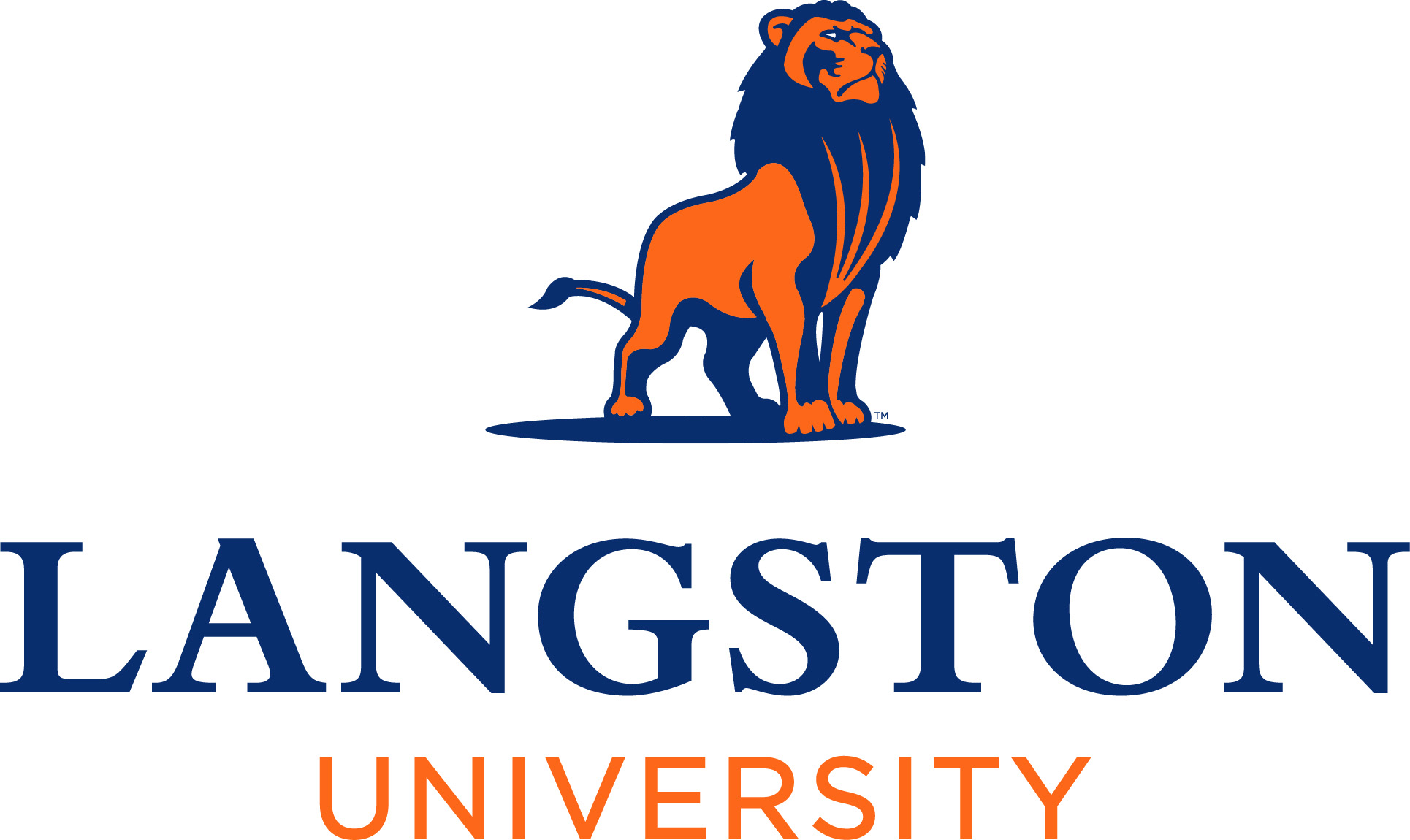
Langston University is Oklahoma's only historically Black college or university and is part of the OSU/A&M System.
Founded in 1897, it offers a range of undergraduate and graduate programs across its main campus in Langston, as well as branch campuses in Tulsa and Oklahoma City. Langston University was named after John Mercer Langston (Dec. 14, 1829-Nov. 15, 1897), a prominent Black educator, politician and civil rights leader. He was the first dean of the law school at Howard University and the first African American elected to public office in the United States.
The university is known for its strong emphasis on academic excellence, community engagement and cultural heritage. Langston University provides a supportive environment for students, fostering personal and professional growth through various academic and extracurricular activities. The university mascot is the Lions.
Langston is located in Logan County. Founded on April 22, 1890, by Edward P. McCabe, a Black American political figure from Kansas, Langston was established as a haven for Black settlers escaping discrimination in the southern United States.
Large Animal Research Building (OSU-Stillwater)
The Large Animal Research Building at Oklahoma State University-Stillwater is dedicated to advancing animal health and production research.
Built in 1994, it is part of the OSU College of Veterinary Medicine. The building supports a wide range of research activities, including studies on climate variability, production efficiency and sustainability in animal and human health, as well as genetics, growth, nutrition and reproduction.
This facility plays a crucial role in OSU's mission to enhance veterinary education and contribute to the well-being of both animals and humans through innovative research.
Learning Resource Center (OSUIT)
The Learning Resource Center at the Oklahoma State University Institute of Technology is a hub for learning and innovation.
It offers a wide range of library resources, advanced technology and hands-on tools like 3D printers and laser engravers. Built in 1972, the center includes the MakerSpace, which empowers students to bring their ideas to life with cutting-edge tools, fostering creativity and practical skills.
Additionally, the LASSO Center within the Learning Resource Center provides tutoring, test preparation, proctoring and student disability services, ensuring comprehensive support for academic success.
Learning Resource Center (OSU-OKC)
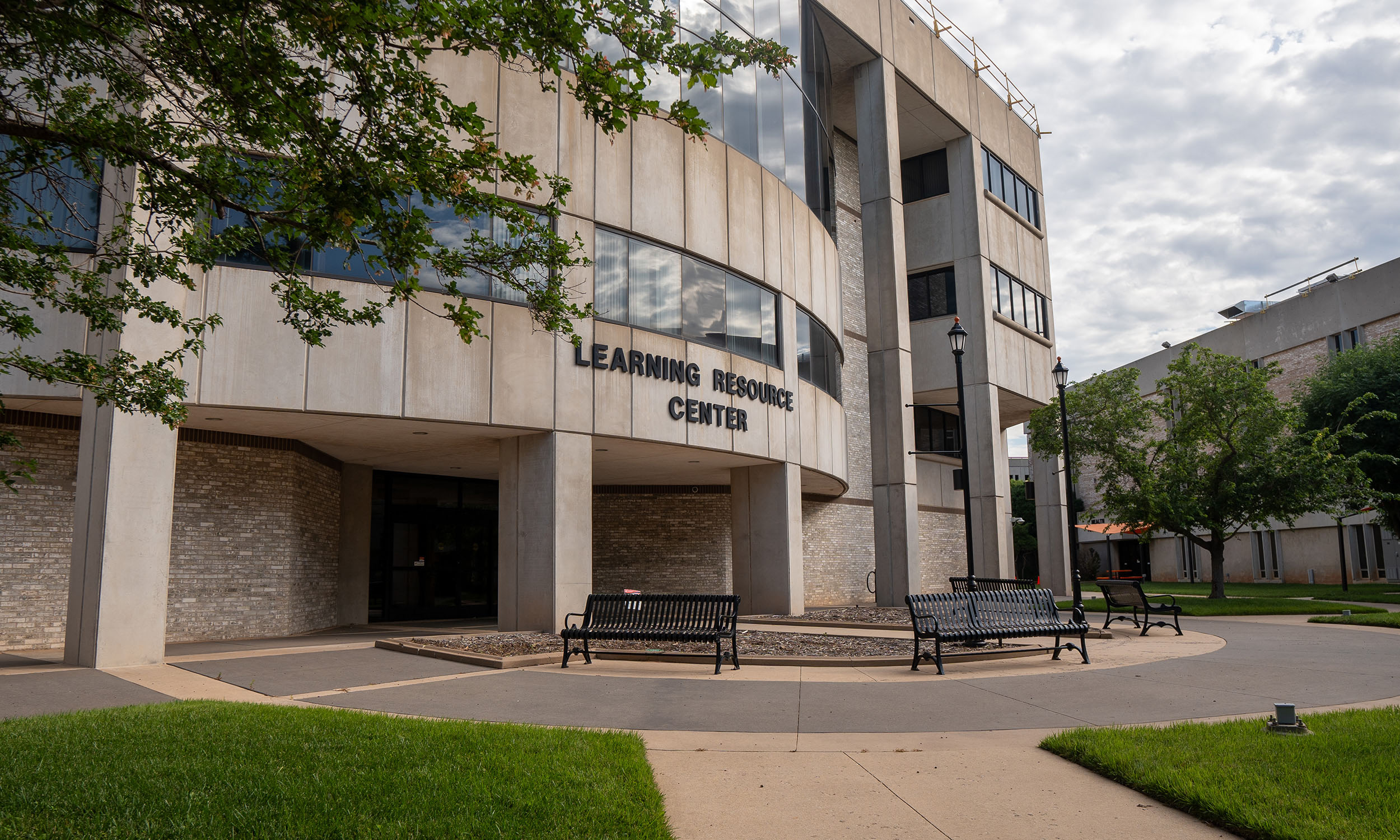
The Learning Resource Center at Oklahoma State University-Oklahoma City is a vital facility that supports student success through various academic resources and services.
This center houses the Library, School of Professional Studies and the Writing Center, where highly qualified tutors assist students with writing assignments, from brainstorming to final proofreads. Additionally, the Academic Success coaches are located on the second floor, providing individualized assistance to help students overcome academic challenges and achieve their goals.
Built in 1994, the Learning Resource Center is a hub for collaborative learning, offering spaces for students to study, work on group projects and access essential academic support services.
FIRST REFERENCE: Use full name "Learning Resource Center."
SECOND REFERENCE: For all subsequent references, it is acceptable to use the term "LRC."
Legacy Hall (OSU-Stillwater)
Legacy Hall at Oklahoma State University, formerly known as Agricultural Hall, was renamed on June 14, 2024, by the OSU/A&M Board of Regents.
This historic building, located at the intersection of Farm Road and Monroe Street, has been a cornerstone of the university since its north wing was completed in early 1958, followed by the south hall in 1964, and the east-facing building in March 1969. Legacy Hall houses several OSU Agriculture programs and service units, including the Department of Landscape Architecture, the Office of Communications and Marketing-OSU Agriculture, the Office of Finance and Business Operations, and Sponsored Programs. It also includes general university classrooms and the OSU Office of Student Success and First-Year Advising.
The renaming signifies the building's rich history and legacy, allowing it to continue serving future generations of Cowboys.
Library (OSU-Tulsa)
The Oklahoma State University-Tulsa Library is more than just a repository of books; it serves as the intellectual hub of the Tulsa campus, facilitating research and learning through innovative services, technologies and spaces.
Located inside Main Hall, the library offers a variety of resources, including tech-to-go, course reserves, online media, and digital and special collections. It provides physical and online spaces to foster creation, collaboration and engagement. Students can access a wide range of materials, from textbooks available for short-term checkout to e-books accessible online.
The library also supports interlibrary loans, allowing access to collections from libraries across the state, country and globe.
Library Fountain (OSU-Stillwater)
The Library Fountain, located outside the Edmon Low Library on the Oklahoma State University-Stillwater campus, is an iconic landmark and a popular gathering spot for students, faculty and visitors.
The fountain is often dyed orange during special events, such as Homecoming, to celebrate school spirit. The area around the fountain is also a designated tabling area for various campus events and activities.
It sits on the Beverly Clerico Plaza, dedicated in 2005 after Tulsa businessman John Clerico donated $500,000 to renovate the original 1953 South Plaza of the Edmon Low Library in Stillwater to honor his late wife, who was an alumna of Oklahoma State University.
Library Lawn (OSU-Stillwater)
The Library Lawn at Oklahoma State University is a central and iconic green space located in front of Edmon Low Library.
It is a popular gathering spot for students, faculty and visitors, offering a serene environment for relaxation, socializing and various campus events. The lawn is known for its lush greenery, well-maintained gardens, and the annual flag display on Veterans Day, which honors soldiers who have lost their lives since Sept. 11, 2001.
The Library Lawn is a testament to OSU's commitment to creating a welcoming and vibrant campus atmosphere.
Life Sciences East (OSU-Stillwater)
Life Sciences East at Oklahoma State University-Stillwater is a key facility within the College of Arts and Sciences.
Built in 1938, this building houses various academic and administrative offices, including the CAS Dean’s Office and the OSU Center for Sovereign Nations. The center is crucial in supporting Native American students and fostering partnerships with tribal nations. Life Sciences East is dedicated to advancing scientific research and education, providing students and faculty with state-of-the-art resources and a collaborative environment to explore the intricacies of life sciences. LSE also houses the Center for Africana Studies.
It is located between Edmon Low Library and Life Sciences West.
Life Sciences West (OSU-Stillwater)
Life Sciences West at Oklahoma State University-Stillwater is under the purview of the College of Arts and Sciences, dedicated to advancing scientific research and education.
Built in 1960, this building houses various academic and administrative offices, including the Department of Integrative Biology. The facility provides resources and a collaborative environment for students and faculty to explore the intricacies of life sciences. Life Sciences West supports OSU's mission to foster innovation and excellence in scientific inquiry.
It is located at the corner of Monroe Street and Athletic Avenue.
Main Hall (OSU-Tulsa)
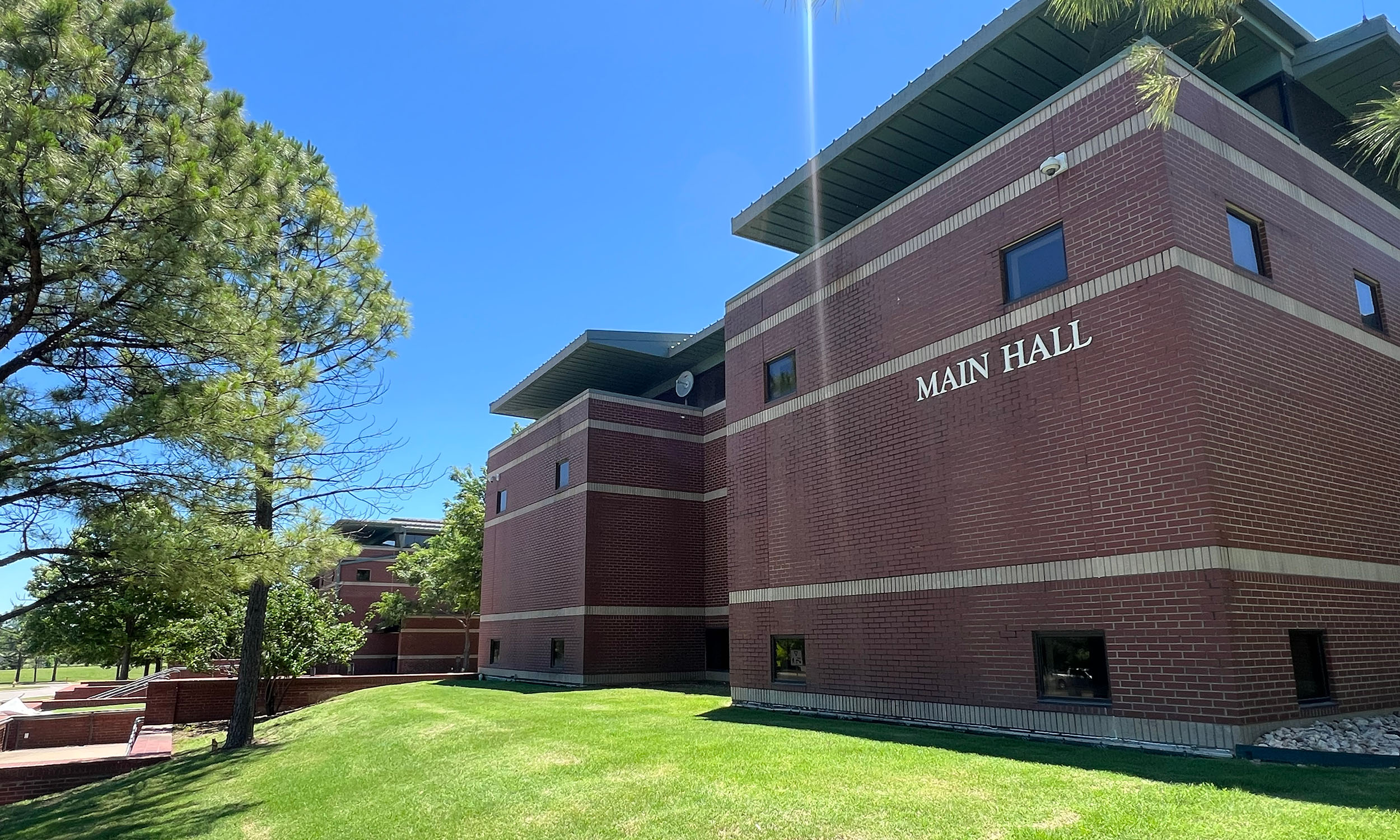
Main Hall is a key building on the Oklahoma State University-Tulsa campus, located in the heart of downtown Tulsa's Greenwood District.
Established in 1999, Main Hall was the first building on the OSU-Tulsa campus and has since evolved into a connected urban campus with strong ties to its neighbors. The building houses the OSU-Tulsa Library, various administrative offices, classrooms and student services, providing essential support for students, faculty and staff.
The building's strategic location and comprehensive facilities make it a hub for academic and community activities at OSU-Tulsa.
Math Sciences Building (OSU-Stillwater)
The Math Sciences Building at Oklahoma State University is a central facility under the purview of the College of Arts and Sciences.
This building houses the Department of Mathematics, which offers a comprehensive range of undergraduate and graduate programs designed to equip students with practical skills and knowledge in mathematics. Built in 1968, the Math Sciences Building is also home to the Department of Computer Science.
Located off Monroe Street by Whitehurst Hall, the building's facilities and collaborative environment make it a hub for mathematical research and education at OSU.
McElroy Hall (OSU-Stillwater)
McElroy Hall at Oklahoma State University is a key facility under the purview of the College of Veterinary Medicine.
This building houses various academic and administrative offices, including the CVM Dean’s Office. Built in 1949, McElroy Hall is integral to the college's operations, supporting a wide range of activities and services that contribute to advancing veterinary education and research. It is named after Dr. Clarence Hamilton McElroy (March 26, 1886-March 7, 1970), a significant figure in veterinary medicine who served as the head of the Department of Veterinary Medicine at Oklahoma A&M College from 1948-53. He had arrived as an assistant to Dr. Lowery Layman Lewis (Sept. 3, 1869-Sept. 26, 1922) in 1909 and was instrumental to the CVM’s history at OSU.
The hall is equipped with modern amenities and provides a collaborative environment for students, faculty and staff to engage in innovative research and educational initiatives.
McKnight Center for the Performing Arts, The (OSU-Stillwater)
The McKnight Center for the Performing Arts at Oklahoma State University is a world-class cultural hub dedicated to attracting celebrated national and international programs featuring notable performing arts productions and artists.
Opened in October 2019, the center is at 705 W. University Ave. in Stillwater. It offers a variety of performances, including concerts by prestigious orchestras, touring Broadway musicals, and other renowned artists. It is named after Ross and Billie McKnight, alumni who met as OSU students in 1970, while Ross was an animal science senior and Billie was a freshman working toward a degree in business administration. They donated $25 million for the facility in 2016.
The McKnight Center also significantly contributes to student employment and career development, providing hands-on experience in arts management, customer service, marketing and event coordination.
FIRST REFERENCE: Use full name and capitalize "The Mcknight Center for the Performing Arts."
SECOND REFERENCE: For all subsequent references, it is acceptable to use the term "McKnight Center."
McPherson Hall (OSU-Stillwater)
McPherson Hall at Oklahoma State University-Stillwater is a three-story residential building at the corner of Garfield Street and McElroy Road.
Part of the Morrison Neighborhood, McPherson Hall accommodates 108 undergraduate students from various classifications and majors. Each unit offers apartment-style living with private or shared bedrooms, a bathroom, a living room, a full-size kitchen, and an in-unit washer and dryer. Constructed in 2001, the building provides modern amenities such as central heating and air conditioning, a balcony or patio, and a smoke detector and sprinkler system. It is named after Dr. James King McPherson (1937-July 11, 1994), professor emeritus of botany at Oklahoma State University, where he taught from 1968 until his retirement in 1992. McPherson was known for his rigorous field botany course and volunteer work with the Nature Conservancy and the Sierra Club.
McPherson Hall is conveniently located near the Griffith Community Center and several dining options, making it a popular choice for students seeking a comfortable and well-equipped living environment.
Mechanical and Aerospace Engineering Research Lab (OSU-Stillwater)
The Mechanical and Aerospace Engineering Research Lab at Oklahoma State University is a state-of-the-art facility dedicated to advancing research and development in mechanical and aerospace engineering.
Built in 1976, the lab supports various projects, including aerospace propulsion, unmanned systems, fluid mechanics, solid mechanics, and materials and manufacturing. It features specialized rooms for electrical manufacturing, 3D printing, composite work, engine testing and a secure integration room.
The lab's strategic location on Willis Street, closer to the Stillwater campus, facilitates better collaboration and coordination with university and industrial partners.
FIRST REFERENCE: Use full name and capitalize "Mechanical and Aerospace Engineering Research Lab."
SECOND REFERENCE: For all subsequent references, it is acceptable to use the term "MERL."
Michael and Anne Greenwood School of Music (OSU-Stillwater)
The Michael and Anne Greenwood School of Music at Oklahoma State University is a premier music education facility dedicated to enriching lives through music.
Opened in 2019, it is attached to The McKnight Center for the Performing Arts, creating one of the finest performing arts complexes in the nation. The school offers a comprehensive and enriching experience for both undergraduate and graduate students, as well as non-music majors. It features state-of-the-art instructional rooms designed to optimize acoustics, specialized applied instruction studios, ample student practice rooms and advanced technology. The GSM is recognized for its outstanding faculty and students, and it has been named a top music business school by Billboard magazine for multiple years.
The facility was made possible by a generous donation from OSU alumni Michael and Anne Greenwood, longtime supporters of the university and its music programs.
FIRST REFERENCE: Use full name and capitalize "Michael and Anne Greenwood School of Music."
SECOND REFERENCE: For all subsequent references, it is acceptable to use the term "GSM."
Michael and Anne Greenwood Tennis Center (OSU-Stillwater)
The Michael and Anne Greenwood Tennis Center at Oklahoma State University is a premier facility for the university's men's and women's tennis programs.
Built in 2014, it features 12 outdoor and six indoor courts, providing a top-notch environment for practice and competition. The center includes coaches' offices, locker rooms, a sports medicine hub with a hydrotherapy center and seating for at least 350 spectators in the indoor facility. The GTC has been recognized as one of the top collegiate tennis facilities in the country. It has hosted numerous prestigious events, including the 2024 NCAA Division I Tennis Championships.
The center was made possible by a generous donation from OSU alumni Michael and Anne Greenwood, longtime supporters of the university and its athletic programs.
FIRST REFERENCE: Use full name and capitalize "Michael and Anne Greenwood Tennis Center."
SECOND REFERENCE: For all subsequent references, it is acceptable to use the term "GTC."
Michael S. Morgan Business Accelerator (OSU-Stillwater)
The Michael S. Morgan Business Accelerator at Oklahoma State University is a state-of-the-art facility that fosters innovation and entrepreneurship.
Located in Stillwater, the accelerator provides a comprehensive suite of resources and support for startups and established businesses. It features modern amenities, including a proposed Analytical Solutions Center equipped with a supercomputer, which will be the largest in Oklahoma and several nearby states. It is at the corner of 6th Avenue and Sangre Road. The facility aims to enhance research capabilities and facilitate valuable commercial partnerships, making it a hub for technological advancement and economic growth.
It is named after Michael S. Morgan, chairman of Houston-based MORGAN, a fully integrated development, construction and management company.
Miller-Kamm Halls (OSUIT)
Miller-Kamm North and South Halls at the Oklahoma State University Institute of Technology are co-ed residence halls located off Willham Drive that provide private furnished rooms with semi-private baths.
Each room is equipped with local telephone service, cable and internet access, ensuring residents have the amenities for a comfortable stay. Built in 2001, the halls also feature laundry facilities, study rooms and student gathering areas, making them ideal for fostering a vibrant and supportive campus community. With a total of 316 rooms, Miller-Kamm Halls offers a variety of suite configurations to accommodate the diverse needs of students.
The buildings are named after Wayne Miller (March 8, 1920-April 19, 2004), OSUIT director from 1963-83, and Dr. Robert B. Kamm (Jan. 22, 1919-Oct. 10, 2008), OSU president from 1966-77.
Monroe Street Garage (OSU-Stillwater)
The Monroe Street Garage, located at the corner of Monroe Street and Hall of Fame Avenue, is a key parking facility at Oklahoma State University.
Built in 2008, this multi-level garage provides convenient parking options for faculty, staff, students and visitors. It is strategically positioned behind the Multi-Modal Transportation Terminal, making it easily accessible for those commuting to and from campus. The garage has various parking zones, including metered, faculty, staff and commuter sections, ensuring that all parking needs are met.
Morrill, Justin Smith
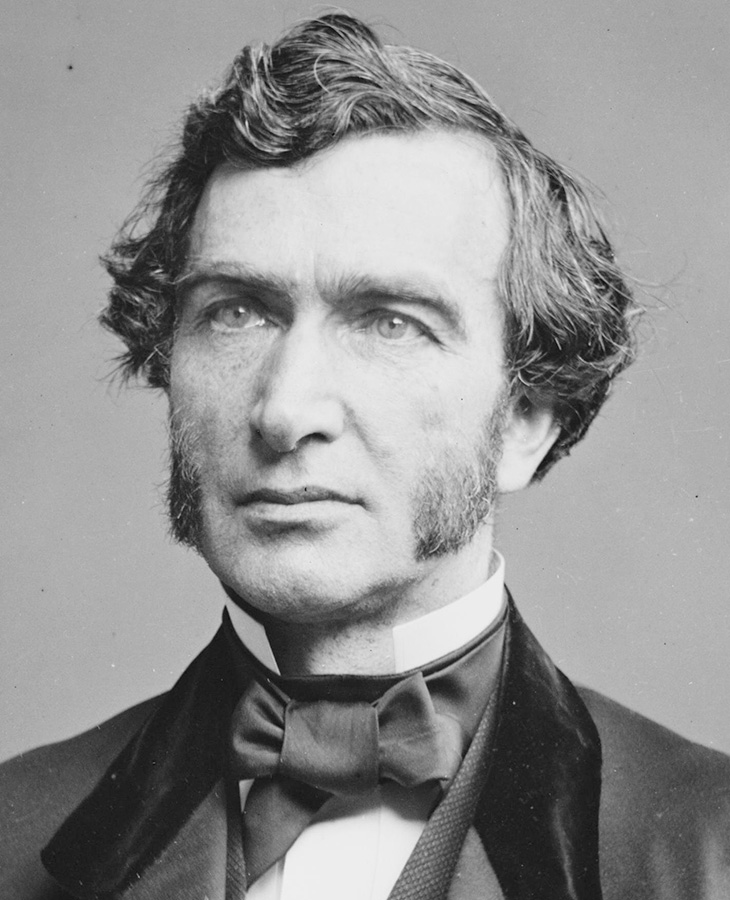 Justin Smith Morrill (April 14, 1810-Dec. 28, 1898) was an American politician and
entrepreneur who represented Vermont in the United States House of Representatives
from 1855 to 1867 and in the United States Senate from 1867 to 1898.
Justin Smith Morrill (April 14, 1810-Dec. 28, 1898) was an American politician and
entrepreneur who represented Vermont in the United States House of Representatives
from 1855 to 1867 and in the United States Senate from 1867 to 1898.
He is most widely remembered for the Morrill Land-Grant Acts, which provided federal funding for creating public colleges and universities, which aimed to offer higher education to a broader segment of the population, particularly in agriculture and the mechanical arts. Morrill's vision was to create institutions that would not only focus on practical education but also teach critical thinking and the essential nature of humanity.
His efforts led to the foundation of many land-grant universities, including Oklahoma State University.
Morrill Hall (OSU-Stillwater)
Morrill Hall at Oklahoma State University is one of the oldest buildings on the Stillwater campus, constructed in 1906.
Originally, it housed the agricultural college, administrative offices and the experiment station. The building was named in homage to Justin Smith Morrill (April 14, 1810-Dec. 28, 1898), a Vermont congressman and senator who played a pivotal role in establishing land-grant universities through the Morrill Act of 1862. In 1914, Morrill Hall was devastated by a fire but was reconstructed in 1915. Its stone and brick design and its columns set a precedent for future architectural projects on campus.
Today, it serves as the home of the OSU Department of English. It is between the General Academic Building and the Bartlett Center for the Visual Arts.
Morrison Neighborhood (OSU-Stillwater)
The Morrison Neighborhood is a residential area on the Oklahoma State University campus, featuring several halls, including McPherson Hall, Carreker East, and Carreker West.
The neighborhood is located near the Griffith Community Center and offers convenient access to dining options such as Adams Market and North Dining. The halls in the Morrison Neighborhood provide a range of amenities, including spacious living areas, modern kitchens, and various recreational facilities.
It is named after Edward Lester Morrison (Aug. 15, 1900-Nov. 16, 1962), an OAMC alumnus who transformed student housing at OSU. As director of campus residence halls, he alleviated the post-war housing shortage, oversaw the sale of temporary housing, and established a modern residence hall system by 1951. Appointed the first director of Auxiliary Enterprises in 1952, he coordinated housing, food services, and non-academic support. Morrison's leadership improved operational efficiency and student services.
Morrow, George Espy
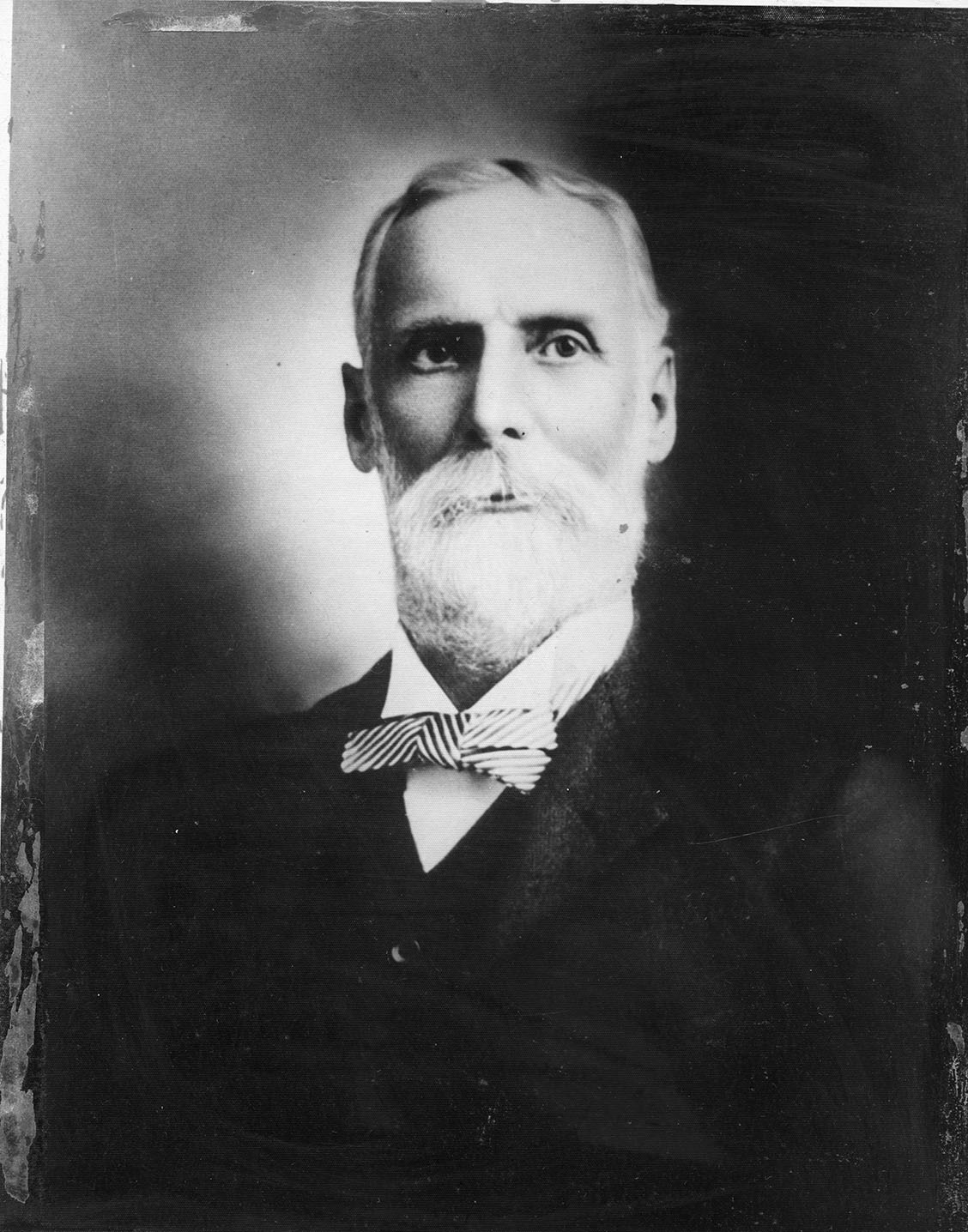 George Espy Morrow (Oct. 19, 1840-March 26, 1900) served as the fourth president of
Oklahoma Agricultural and Mechanical College (now Oklahoma State University) from
1895-99.
George Espy Morrow (Oct. 19, 1840-March 26, 1900) served as the fourth president of
Oklahoma Agricultural and Mechanical College (now Oklahoma State University) from
1895-99.
He earned his law degree from the University of Michigan in 1866. Before coming to Stillwater, he taught for 18 years at the University of Illinois. During his tenure at OSU, he brought stability and respect to the institution, initiated extension work, and supported the development of the Magruder Plots. Morrow also launched new construction projects, expanded the faculty and added mechanical engineering and business degrees.
He resigned due to health reasons and passed away a year later in Paxton, Illinois. He was 59.
Morsani-Smith Hall (OSU-Stillwater)
Morsani-Smith Hall at Oklahoma State University is part of the North Monroe Neighborhood and consists of two connected buildings forming a U-shape around a popular outdoor courtyard.
Located next to the Griffith Community Center and near the Monroe Street Garage, Morsani-Smith Hall offers apartment-style living with private bedrooms, a living room, a full-size kitchen, and in-unit washer and dryer. Built in 2001, the hall is conveniently situated close to dining options such as Adams Market and North Dining Hall, as well as academic buildings like the Wes Watkins Center.
The former is named after Frank and Carol Morsani. Both Frank and Carol hold honorary doctorates from OSU and are recipients of the 2005 Henry G. Bennett Award. Additionally, Frank was inducted into the OSU College of Education Hall of Fame in 2000. The latter is named after Eloise (Feb. 29, 1928-Sept. 12, 2018) and Sherman Edward Smith (May 22, 1923-June 6, 2011), distinguished OSU alumni. A Bristow native and Oklahoma oilman, Sherman retired as chairman and CEO of SerDrilco.
Multimodal Transportation Terminal (OSU-Stillwater)
The Multimodal Transportation Terminal at Oklahoma State University serves as the central hub for the OSU Transit System.
This facility includes a large bus parking area, a lobby waiting room, restrooms, retail space and administration offices for OSU Parking and Transit Services. The terminal is adjacent to the Monroe Street Garage, a five-level parking structure with 1,099 parking spaces. The terminal supports various transit services, including the Big Orange Bus connecting OSU-Stillwater and OSU-Tulsa, and the community transit system known as THE BUS.
Completed in August 2008, the terminal accommodates the university community's growing transportation and parking needs.
Murdaugh, Edmund Dandridge
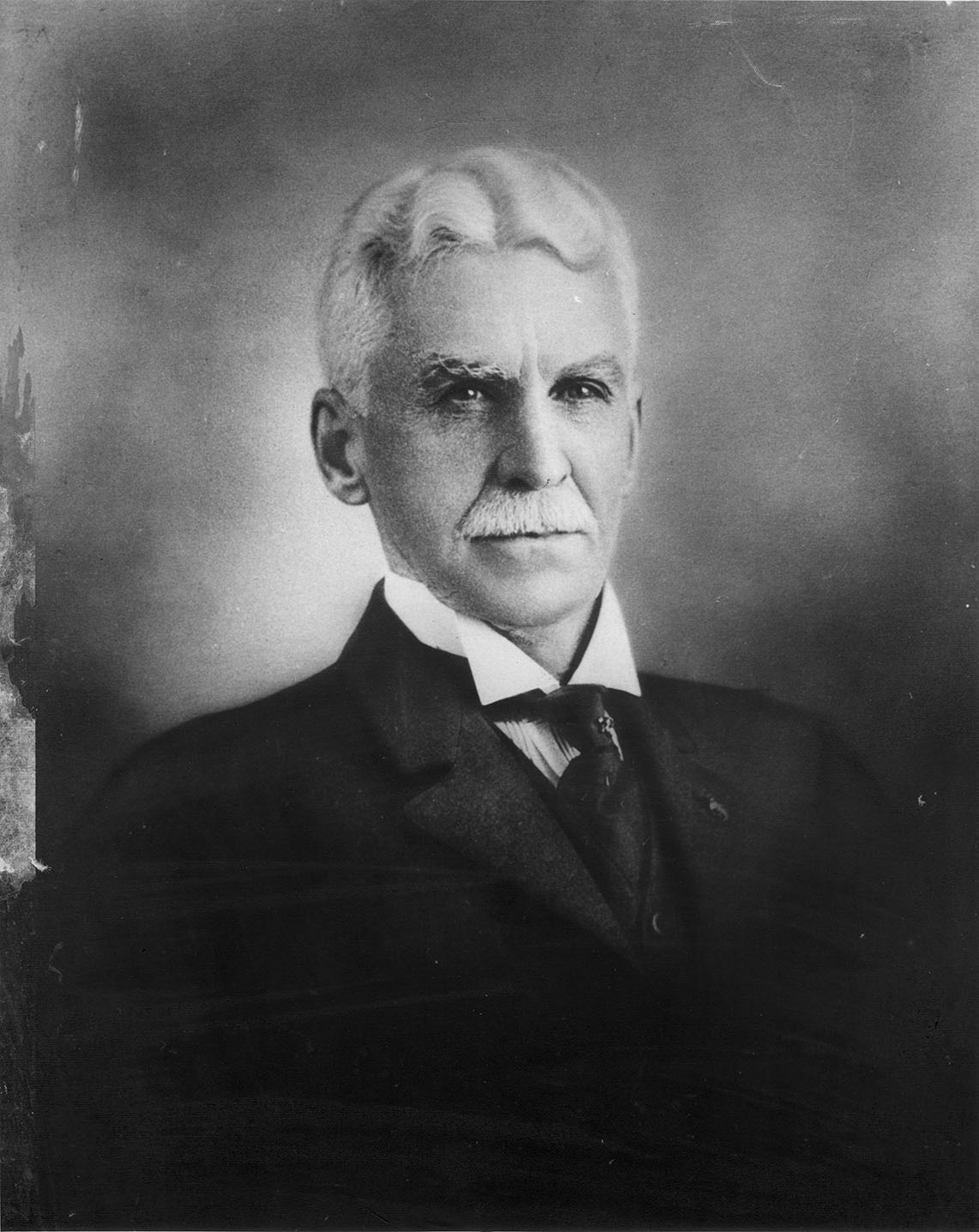 Dr. Edmund Dandridge Murdaugh (1853-May 21, 1925) served as the third president of
Oklahoma Agricultural and Mechanical College (now Oklahoma State University) from
January to June 1895.
Dr. Edmund Dandridge Murdaugh (1853-May 21, 1925) served as the third president of
Oklahoma Agricultural and Mechanical College (now Oklahoma State University) from
January to June 1895.
He attended William and Mary College before studying law at the University of Virginia. The Maryland State Board of Education awarded him a doctorate.
He served as president of a vocational school in Eaton, Maryland, for 18 years before moving to Stillwater.
During his brief tenure, Murdaugh established the college's first press bureau, which significantly improved the flow of information from the university. Murdaugh resigned due to differences of opinion regarding the operations of the Agricultural Experiment Station but went on to have a successful career as the "father" of the state teacher college system.
He later became president of what is now the University of Central Oklahoma in Edmond, organized Northwestern Oklahoma State University in Alva and served as its president, then became president of Southwestern Oklahoma State University in Weatherford.
Murdaugh lived in Edmond until his death in 1925. he was 71.
Nancy Randolph Davis Building (OSU-Stillwater)
The Nancy Randolph Davis Building at Oklahoma State University is named in honor of Nancy Randolph Davis (April 14, 1926-March 23, 2015), the first Black student to attend the university, then known as Oklahoma A&M College, in 1949.
This building, then known as the Human Sciences Building until its rededication on Oct. 23, 2020, was built in 1949. The west edition was completed in 1983. Located on the Stillwater campus, it houses the College of Education and Human Sciences and symbolizes Davis' legacy and contributions to civil rights and education.
In 2019, a life-size bronze statue of Davis was unveiled in the courtyard of the building, celebrating her achievements and her impact on the university and the broader community.
National Wrestling Hall of Fame and Museum
The National Wrestling Hall of Fame and Museum, located in Stillwater, is a premier institution dedicated to preserving the history and legacy of amateur wrestling.
Established in 1976, the Hall of Fame honors outstanding wrestlers, coaches and contributors who have significantly impacted the sport. The museum features exhibits that showcase the rich heritage of wrestling, including memorabilia, photographs and interactive displays. It also operates the Dan Gable Museum in Waterloo, Iowa, further extending its reach and influence.
The Hall of Fame serves as a symbol of the wrestling community's dedication and passion, celebrating its members' achievements and contributions.
Neal Patterson Stadium (OSU-Stillwater)
Neal Patterson Stadium is a premier soccer-specific facility located on the campus of Oklahoma State University in Stillwater.
Officially dedicated on Aug. 19, 2018, the stadium is named in honor of its major benefactor and OSU alumnus, the late Neal Lynn Patterson (Dec. 10, 1949-July 9, 2017), who co-founded Cerner Corporation. Patterson was a significant figure in the health information technology industry and contributed to the $20 million project that transformed the stadium into one of the top collegiate soccer facilities. The stadium serves as the home for the Cowgirl soccer team. It features modern amenities, including club seats, gathering areas and a north end zone terrace designed specifically for OSU students.
With a seating capacity of 2,500, Patterson Stadium stands as a testament to Patterson's legacy and his commitment to supporting OSU. It replaced the former Cowgirl Soccer Complex on the same site, which had been the program’s home since its beginnings in the mid-1990s.
Noble Research Center (OSU-Stillwater)
The Noble Research Center at Oklahoma State University is a prominent facility used by multiple departments, including the Department of Animal and Food Sciences and the Boone Pickens School of Geology.
It houses large classrooms, offices and research laboratories, making it a central hub for academic and research activities on campus. Built in 1988, the center is equipped with state-of-the-art ultrafast lasers and experimental stations dedicated to THz spectroscopy, supporting advanced research in laser and photonics.
It is named after Samuel Lloyd Noble (Nov. 30, 1896-Feb. 14, 1950), a prominent oilman and philanthropist from Oklahoma. Noble founded the Noble Foundation in 1945, which has been instrumental in supporting agricultural research and education.
The Noble Research Center is integral to OSU's commitment to providing cutting-edge research opportunities and fostering academic excellence.
North Classroom Building (OSU-Stillwater)
The North Classroom Building at Oklahoma State University is a significant facility on the Stillwater campus, known for its extensive use in various academic and administrative functions.
This building, with a gross square footage of 58,827.75, provides ample space for classrooms and offices.
Built in 2009, its strategic location and versatile facilities make it an essential part of the university's infrastructure.
North Hall (OSU-CHS)
North Hall at the Oklahoma State University Center for Health Sciences in Tulsa is a modern, 120,000-square-foot facility that opened on July 28, 2022.
This four-story building was a collaborative project with the Oklahoma Office of the Chief Medical Examiner, which occupies a portion of the first and second floors. North Hall houses new anatomy and neuroanatomy labs, conference rooms, instructional learning spaces and offices for administration, select research centers and academic programs.
The building also includes 65 graduate program student study carrels, 21 conference and meeting rooms, and several collaborative spaces. North Hall is a significant addition to the OSU-CHS campus, reflecting the university's commitment to advancing medical education and research.
North Hall (OSU-Tulsa)
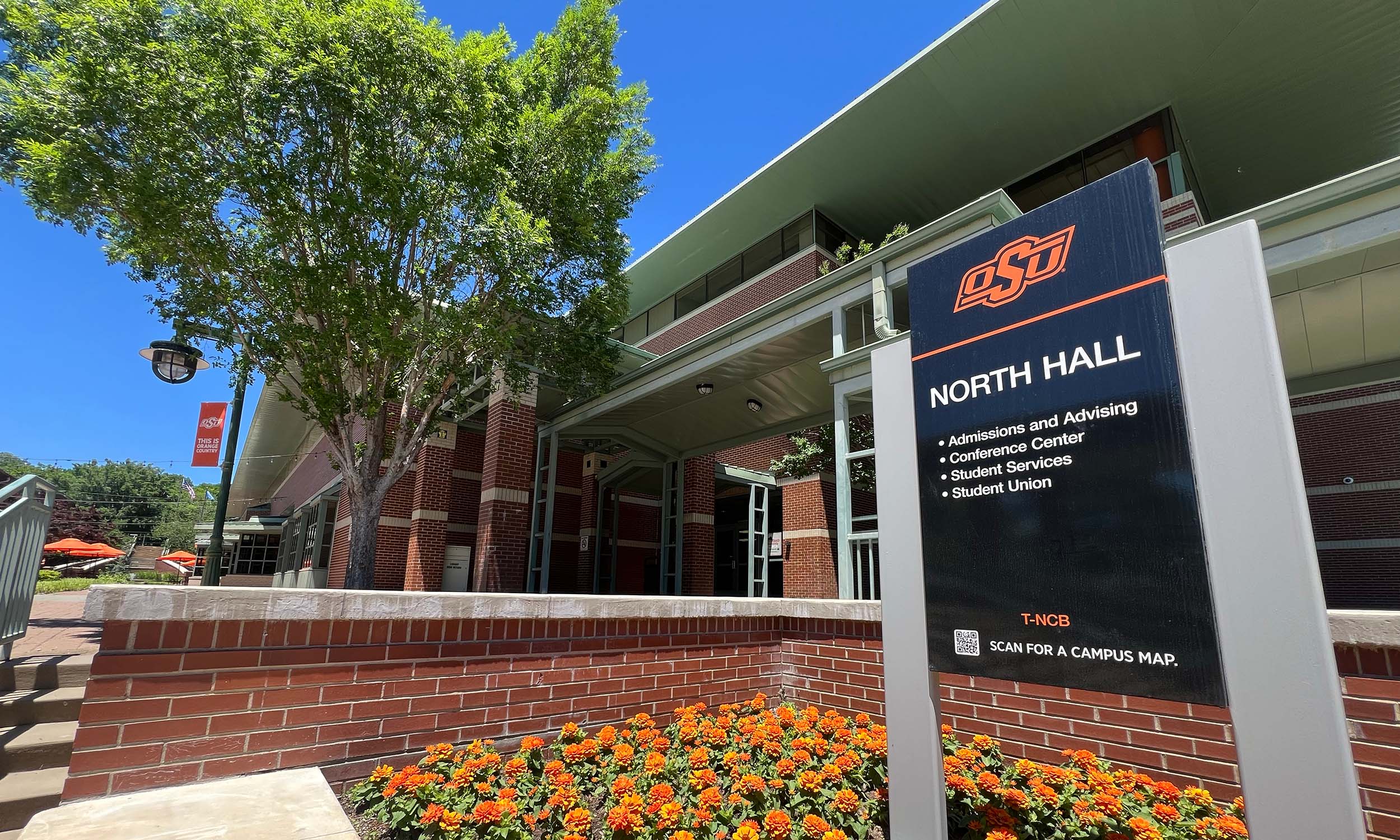
North Hall at Oklahoma State University-Tulsa is a key building on the OSU-Tulsa campus, located in the heart of downtown Tulsa's Greenwood District.
This building houses various administrative offices, classrooms and student services, providing essential support for students, faculty and staff. The North Hall Lobby is home to the OSU-Tulsa Information Center, which assists with tickets for the Big Orange Bus, directions around campus, and other needs.
Northeastern Oklahoma A&M College

Northeastern Oklahoma A&M College is a two-year public college in Miami, Oklahoma (pronounced My-am-uh).
As part of the OSU/A&M System, NEO A&M offers a variety of associate degree programs and certificates in fields such as agriculture, business, health sciences and liberal arts. The college is known for its strong emphasis on student success, providing a supportive learning environment with small class sizes and personalized attention. NEO A&M also boasts a vibrant campus life with numerous student organizations, athletic programs, and community engagement opportunities.
It was founded on March 17, 1919, and was initially established as the Miami School of Mines. The university mascot is the Golden Norsemen.
Miami is serves as the Ottawa County seat and has a population of nearly 13,000. Founded in 1891, Miami was named after the Miami tribe, with Chief Thomas F. Richardville playing a significant role in its establishment.
Northern Oklahoma College-Stillwater
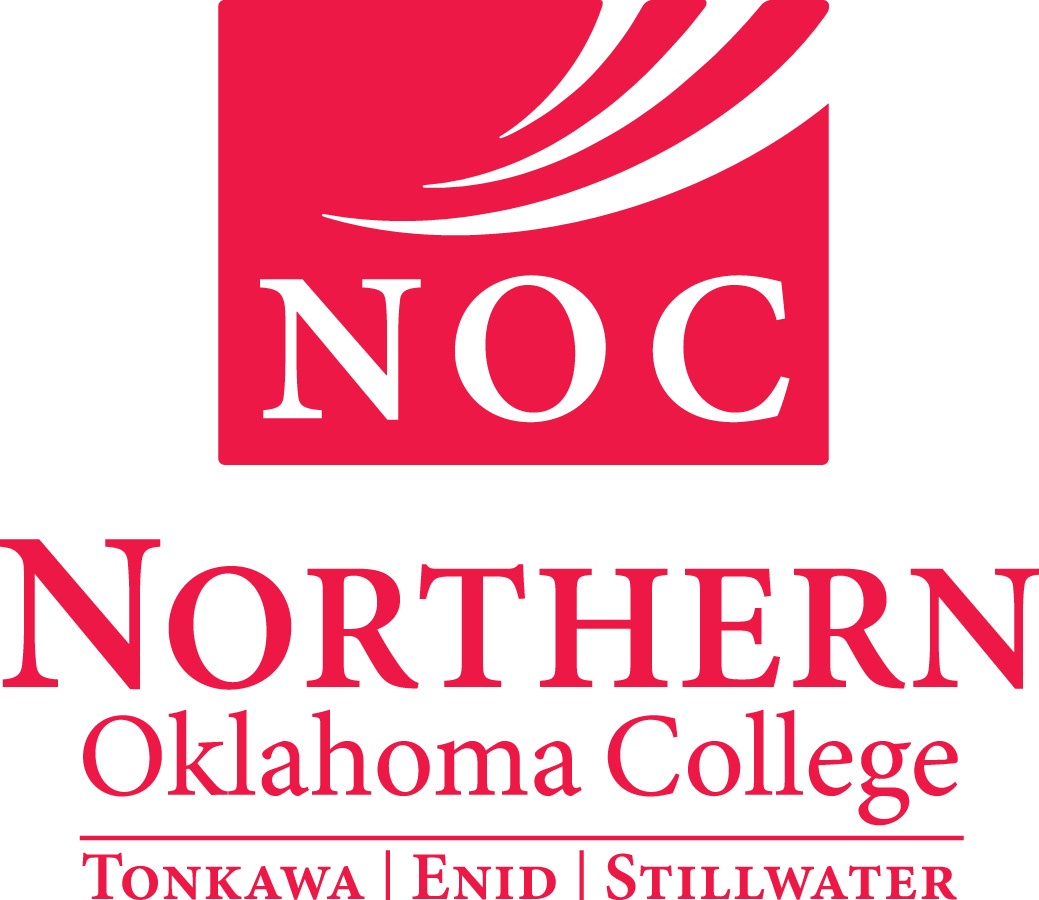
Northern Oklahoma College-Stillwater, established in 2003, serves as a vital educational institution in the Stillwater area.
Primarily functioning as a Gateway Program, it provides opportunities for students who might not otherwise gain admission to Oklahoma State University. The campus also offers general education courses that are transferable to other comprehensive colleges and universities. Each fall and spring semester, NOC-Stillwater admits approximately 400 new students, serving around 1,700 students. The campus is housed in the NOC-Stillwater Building, which was completed in 2018.
NOC is a public community college established in 1901. It is the state's first public community college and offers high-quality, accessible and affordable educational opportunities. NOC has three campuses located in Tonkawa, Enid and Stillwater.
Nursing Building (OSUIT)
The Nursing Building at the Oklahoma State University Institute of Technology is a state-of-the-art facility dedicated to educating and training future nurses.
This building houses modern classrooms, simulation labs and faculty offices, providing a comprehensive learning environment for students pursuing degrees in nursing. Located between 1st and 2nd streets, the facility is designed to support hands-on learning and practical experience, ensuring that graduates are well-prepared for their careers in health care.
The Nursing Building is a testament to OSUIT's commitment to excellence in nursing education and its role in addressing the growing demand for skilled health care professionals.
OBGA Educational Center (OSU-Stillwater)
The OBGA Educational Center, part of the Oklahoma Botanical Garden and Arboretum, is a key facility at Oklahoma State University dedicated to research, education and community engagement in horticulture and environmental conservation.
Located on 100 acres in Stillwater, the center conducts research and shares results through workshops, short courses and TV programs. Built in 1999, it features educational display gardens and conservation areas accessible to Oklahomans of all ages.
The OBGA system includes 18 affiliate gardens throughout the state, with OSU serving as the headquarters and providing support for community development and garden establishment.
O'Brate Stadium (OSU-Stillwater)
O'Brate Stadium is a premier baseball facility located on the campus of Oklahoma State University in Stillwater.
Named after major benefactor Cecil O'Brate (Nov. 21, 1928-Jan. 20, 2024), the stadium officially opened on Feb. 24, 2021, and was dedicated on May 20, 2021, with former U.S. President George W. Bush throwing out the first pitch. It serves as the home field for the Cowboy baseball team and features approximately 3,500 permanent seats, with the capacity to expand to 8,000.
The stadium includes modern amenities such as 11 suites, 400 premium seats, a "training triangle" area with an indoor facility, a pitching lab and an artificial turf infield. Additionally, it boasts a 7,400-square-foot locker room, a player lounge, a nutrition center and a tiered seating classroom.
It replaced Allie P. Reynolds Stadium as the Cowboys’ home.
Office of Central Procurement
The Office of Central Procurement at Oklahoma State University facilitates the acquisition of goods and services for OSU and A&M Systems, ensuring timely and best-value procurement.
This office provides administrative direction within established standards, manages supplier relationships, oversees bid opportunities and ensures compliance with procurement policies.
Located at 1224 N Boomer Road in Stillwater, the office operates Monday through Friday from 8 a.m. to 5 p.m.
Oklahoma Animal Disease Diagnostic Laboratory (OSU-Stillwater)
The Oklahoma Animal Disease Diagnostic Laboratory at Oklahoma State University is a vital facility dedicated to promoting animal health through veterinary diagnostic testing, instruction of professional students and research on diseases of economic importance to Oklahoma and beyond.
Established in 1975, OADDL provides a wide range of diagnostic services, including necropsy, biopsy, bacteriology, mycology, parasite screening, serology and molecular diagnostics. The lab handles approximately 185,000 testing requests annually from 44 states, significantly expanding its services since its inception.
OADDL also plays a crucial role in the One Health initiative, fostering collaborations with various departments and external partners to address complex health challenges at the intersection of animal and human health.
Oklahoma
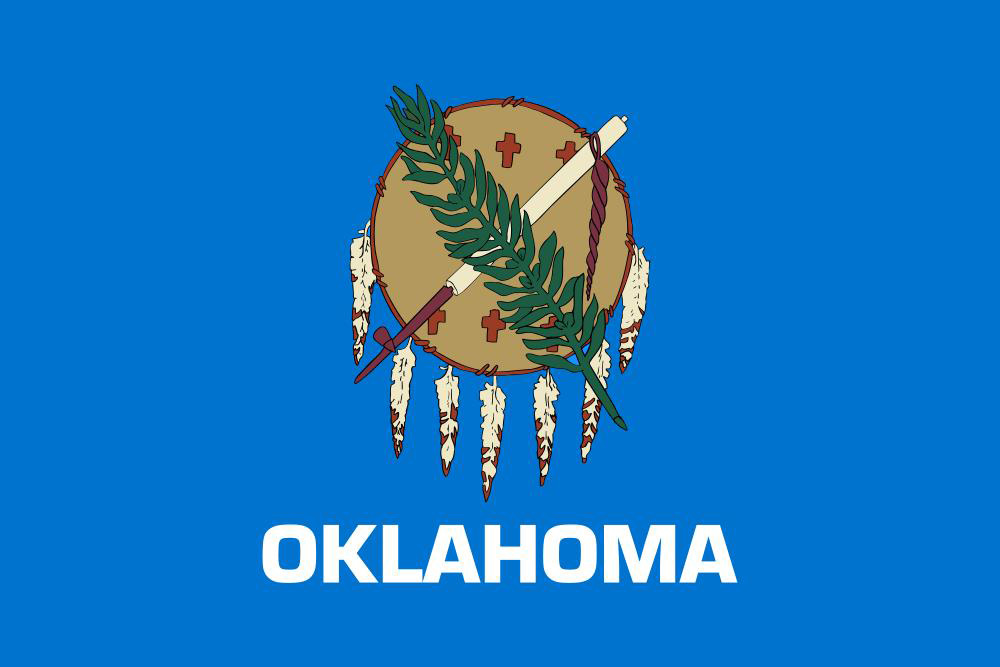
Oklahoma is located in the south-central region of the United States. It became the 46th state to join the Union on Nov. 16, 1907.
The name "Oklahoma" is derived from the Choctaw words "okla" and "humma," which translate to "red people." This name was first recorded by Spanish explorer Francisco Coronado in 1541 during his quest for the "Lost City of Gold." The state is characterized by its diverse geography, which includes prairies, forests and mountain ranges. Oklahoma's economy is driven by sectors such as energy, agriculture, aviation and biotechnology.
The state is also rich in Native American history and culture, with 39 tribal nations headquartered within its borders. As of 2024, the population of Oklahoma is approximately 4,088,380. Oklahoma City is the state capital and largest city.
Oklahoma City
Oklahoma City, the capital and largest city of the state of Oklahoma, is a bustling urban center known for its rich history, diverse culture and vibrant economy.
Founded during the Land Run of 1889, Oklahoma City has grown into a major hub for energy, aviation and biotechnology industries. The city has numerous attractions, including the Oklahoma State Capitol, the Myriad Botanical Gardens, the Oklahoma City Thunder and the Oklahoma City Museum of Art. With a strong commitment to community development and public services, Oklahoma City offers a high quality of life for its residents and visitors alike.
As of 2024, Oklahoma City’s population is approximately 709,330.
Oklahoma Panhandle State University
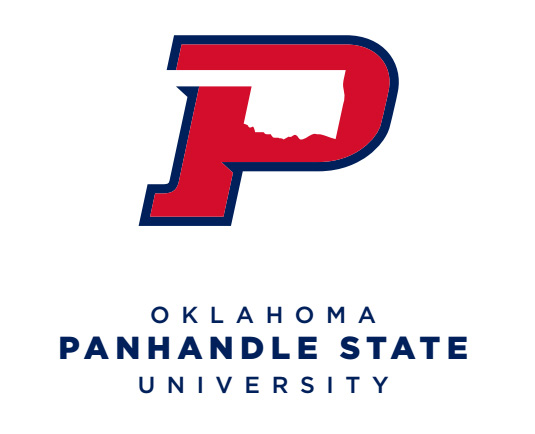
Oklahoma Panhandle State University is a public university located in Goodwell, Oklahoma.
It is part of the OSU/A&M System and offers a range of undergraduate programs in fields such as agriculture, business, education, and liberal arts. It was founded in 1909 and originally opened as the Pan-Handle Agricultural Institute, offering secondary agricultural education for the Panhandle area. OPSU is known for its strong emphasis on hands-on learning and community engagement, providing students with practical experiences that prepare them for successful careers. The university also supports various extracurricular activities, including athletics, clubs and organizations, fostering a vibrant campus life. The university mascot is the Aggies.
Goodwell has a population of about 1,000 and is located in Texas County, about 10 miles southwest of the county seat of Guymon. It officially became a town around 1902 with the arrival of the Chicago, Rock Island and Pacific Railway. A post office was established on June 16, 1903. The city was named "Goodwell" because good water came from a well that had been dug on the townsite for use by the railroad.
Oklahoma State Regents for Higher Education
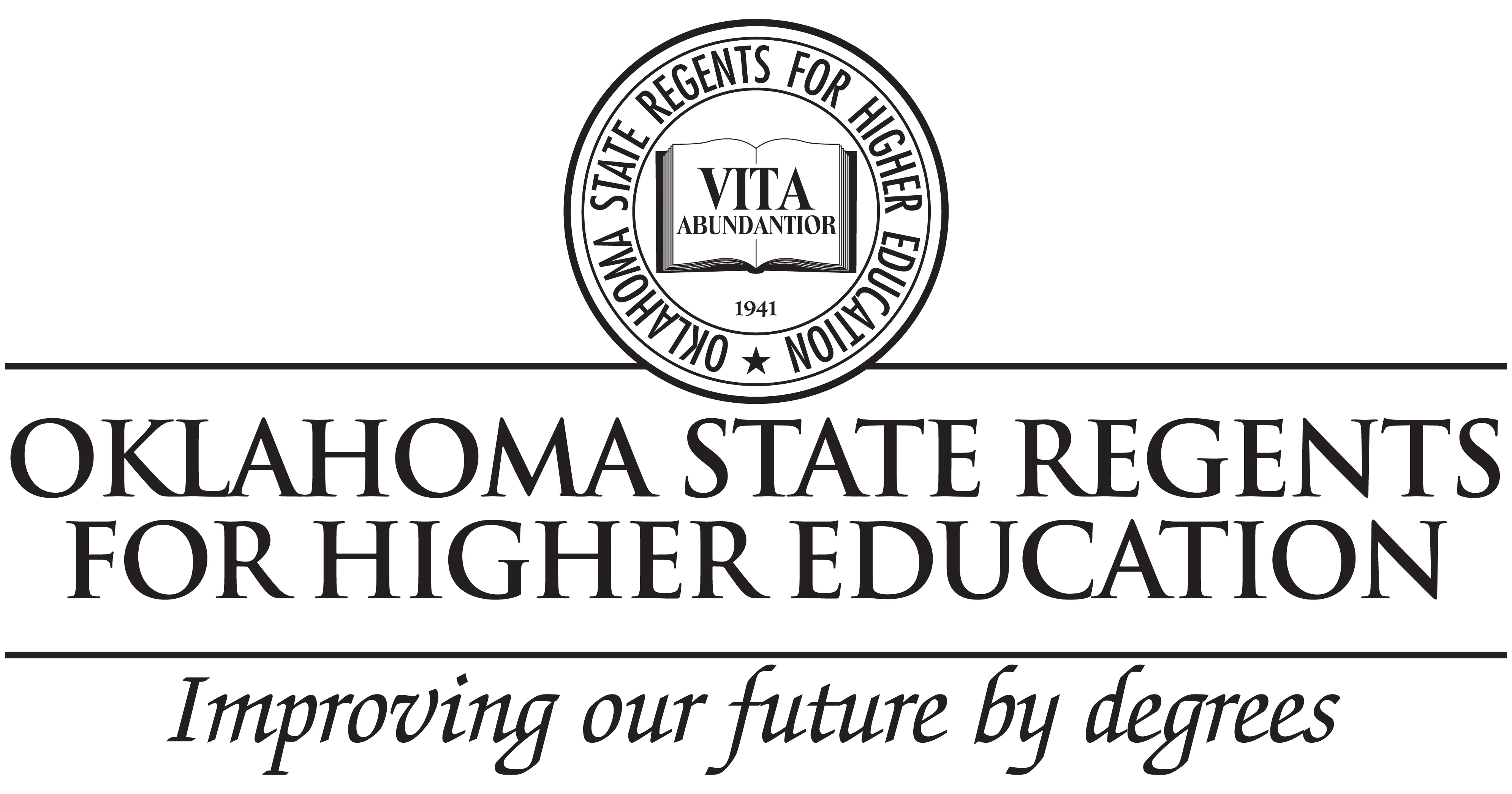
The Oklahoma State Regents for Higher Education is the coordinating board for the state's system of public colleges and universities, which includes 25 institutions: two research universities, 10 regional universities, one public liberal arts university and 12 community colleges.
The State Regents oversee the academic standards, budget allocations and policy development for these institutions. They also serve as the federally recognized approval agency for state authorization of all degree-granting institutions operating in Oklahoma and as the State Portal Entity for institutions participating in State Authorization Reciprocity Agreements.
The board consists of nine members appointed by the governor and confirmed by the Oklahoma Senate to serve nine-year terms.
Oklahoma State University Agriculture
Oklahoma State University Agriculture (also known as the Division of Agricultural Sciences and Natural Resources) improves Oklahomans' quality of life through science-based information and education.
As a land-grant university, OSU Agriculture is founded on OSU's premise and includes the Ferguson College of Agriculture, OSU Extension and OSU Ag Research. Field studies at OSU Agriculture's more than 40 research facilities, laboratories, greenhouses, teaching and testing facilities, and centers and institutes are implemented into curricula on campus.
This research-based information is shared among OSU Extension offices in Oklahoma’s 77 counties, supporting agriculture and natural sciences, rural economic development, family and consumer sciences, community health and 4-H youth development.
Oklahoma State University Alumni Association

The Oklahoma State University Alumni Association is the official organization that connects alumni, students and friends of OSU to foster lifelong connections with the university. It was founded in 1897 by the university’s first six graduates and, since 2005, has operated as a 501(c)3 nonprofit organization. Headquartered at the ConocoPhillips OSU Alumni Center in Stillwater, the Alumni Association supports more than 270,000 living alumni and students by:
- Strengthening connections within the Cowboy family.
- Celebrating university, alumni and student achievements.
- Supporting student access to education and leadership opportunities.
- Preserving time-honored OSU traditions like Homecoming.
- Advocating for university initiatives.
The Alumni Association is a dues-based organization open to anyone with special rates for students. Membership not only supports the university but also provides great benefits, including:
- Members-only communications and experiences.
- Access to regional, affinity and college alumni networks.
- Lifelong career support and continuing education opportunities.
- Special perks on tickets, goods and services.
- Give back to the university.
A 21-member board of directors governs the Alumni Association. The current Alumni Association president is Dr. Ann Caine, ‘98.
The official magazine of Oklahoma State University is STATE.
First reference: Use the full name “Oklahoma State University Alumni Association.”
Second reference: You can use “Alumni Association.”
Oklahoma State University Center for Health Sciences
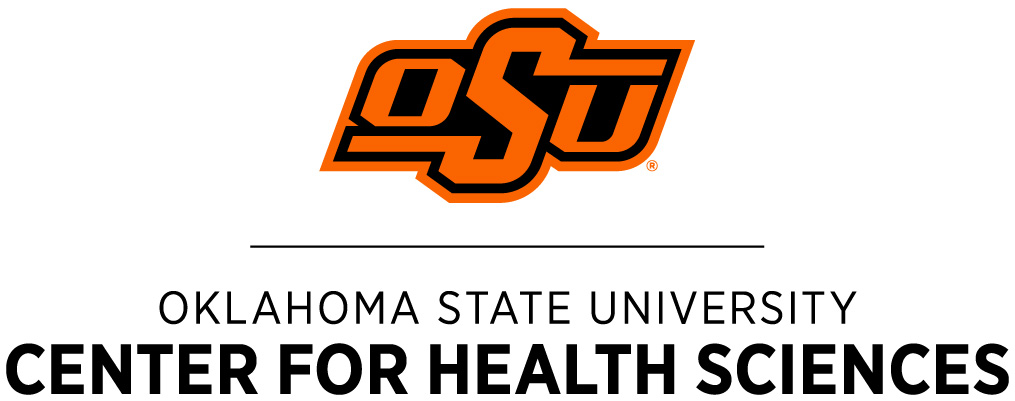
The Oklahoma State University Center for Health Sciences is a nationally recognized academic health center focused on teaching, research and patient care through its OSU Medicine clinics throughout the Tulsa metro area.
Established in 1972, OSU-CHS offers graduate and professional degrees through the College of Osteopathic Medicine, OSU-COM at the Cherokee Nation in Tahlequah, the School of Allied Health, the School of Health Care Administration, the School of Biomedical Sciences, the School of Forensic Sciences and the Physician Assistant program. The center operates a network of clinics offering many specialty services, including addiction medicine, cardiology, family medicine, internal medicine, pediatrics, psychiatry and women’s health.
OSU-CHS is dedicated to providing health care for rural and underserved areas of Oklahoma, reflecting its commitment to improving the state's health and delivering outstanding patient care.
Oklahoma State University College of Osteopathic Medicine
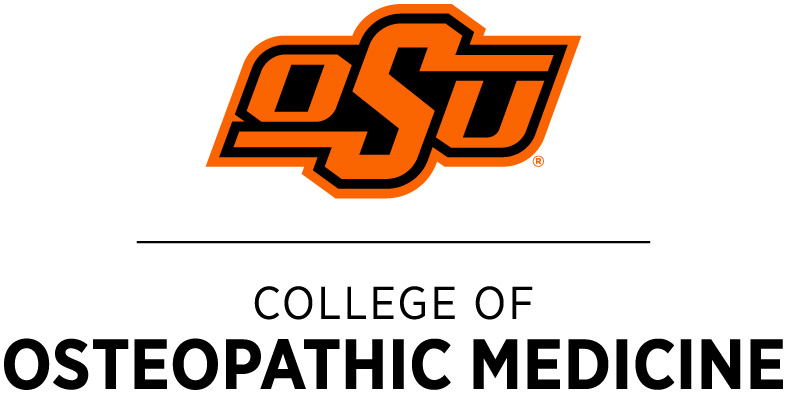
The OSU College of Osteopathic Medicine, part of the Oklahoma State University Center for Health Sciences, is a nationally recognized academic health center focused on teaching, research and patient care.
The college offers graduate and professional degrees in osteopathic medicine, with a strong emphasis on training primary care physicians to serve rural and underserved communities in Oklahoma. The curriculum includes comprehensive clinical education and hands-on training through OSU Medicine clinics throughout the Tulsa metro area. The OSU College of Osteopathic Medicine was founded in 1972 as the Oklahoma College of Osteopathic Medicine and Surgery.
It became part of the Oklahoma State University System in 1988 and was renamed the OSU College of Osteopathic Medicine. The college is committed to advancing health care access and outcomes, and it operates in collaboration with the OSU College of Osteopathic Medicine at the Cherokee Nation in Tahlequah.
Oklahoma State University College of Osteopathic Medicine at the Cherokee Nation
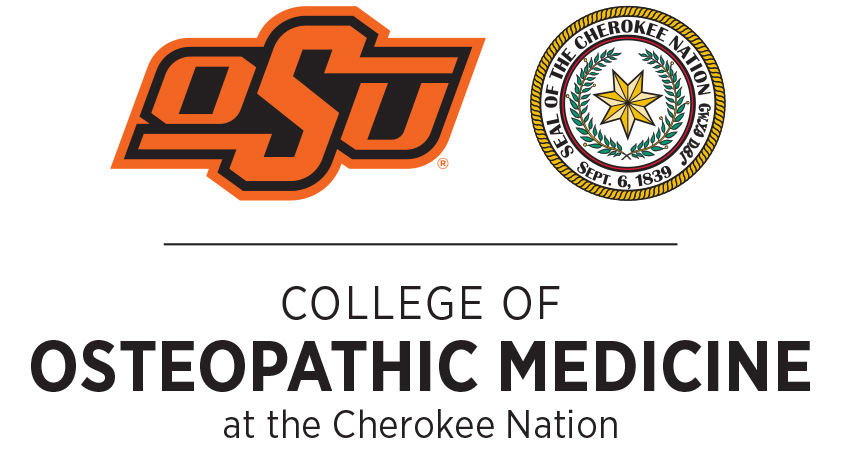
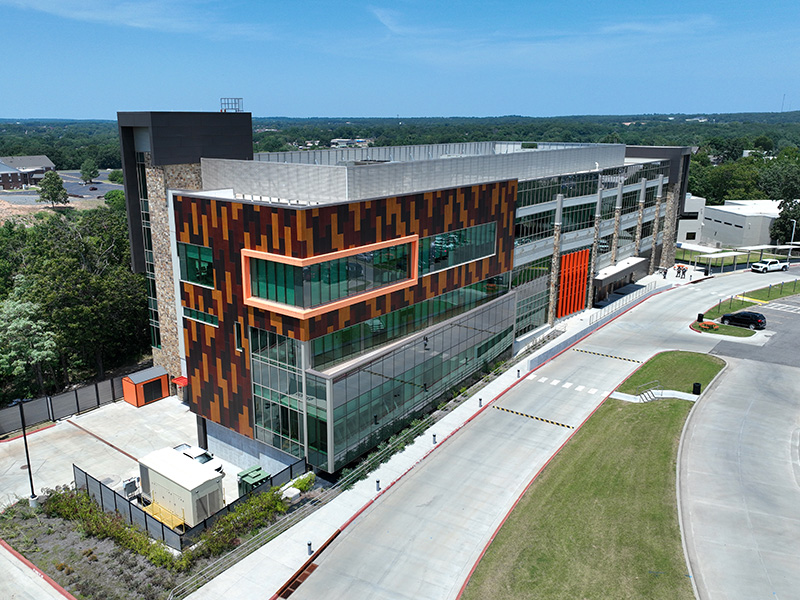 The Oklahoma State University College of Osteopathic Medicine at the Cherokee Nation, located in Tahlequah, Oklahoma, is the first tribally affiliated medical school
in the United States.
The Oklahoma State University College of Osteopathic Medicine at the Cherokee Nation, located in Tahlequah, Oklahoma, is the first tribally affiliated medical school
in the United States.
Established in partnership with the Cherokee Nation, the college opened in August 2020 with an inaugural class of 54 students. The 85,000-square-foot facility includes state-of-the-art anatomy, clinical skills, osteopathic manipulative medicine, and standardized patient labs, as well as a simulation center with computer-programmable manikins.
The college's mission is to train physicians dedicated to serving rural and underserved populations, focusing on improving health care access and outcomes for Native American communities.
Oklahoma State University Foundation
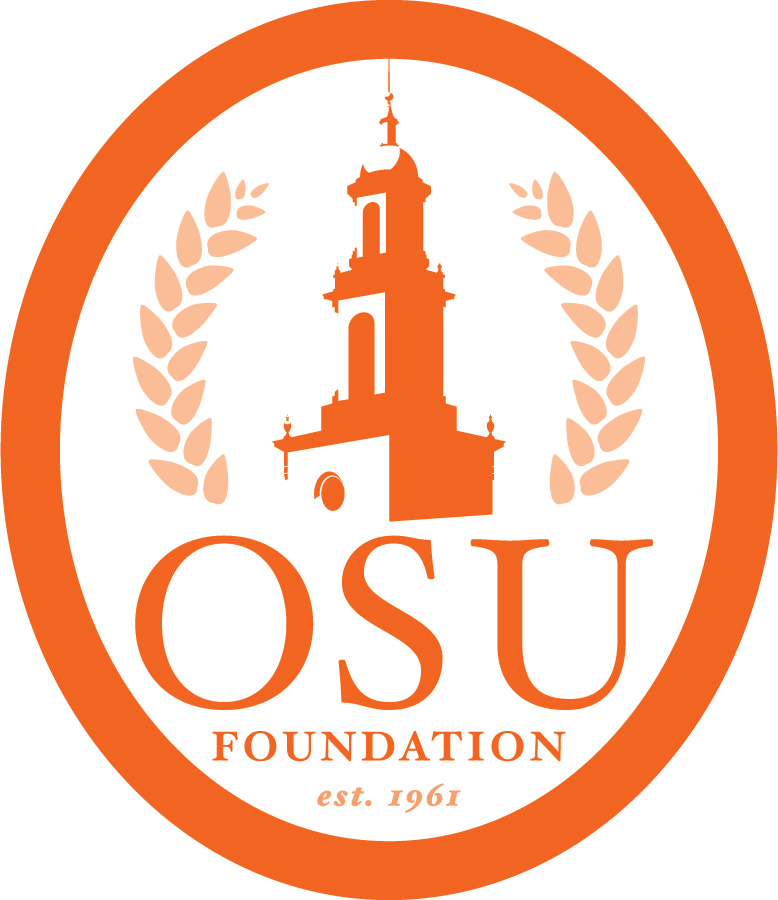 The OSU Foundation is the private fundraising organization for Oklahoma State University, dedicated
to uniting donor passions with university priorities to elevate the impact of OSU,
including enhancing the student experience, advancing research and supporting faculty
excellence.
The OSU Foundation is the private fundraising organization for Oklahoma State University, dedicated
to uniting donor passions with university priorities to elevate the impact of OSU,
including enhancing the student experience, advancing research and supporting faculty
excellence.
As a nonprofit entity, the Foundation manages private gifts and endowments that benefit all areas of the university, such as scholarships, academic programs, athletics and capital projects.
Established in 1961, it plays a vital role in fostering a culture of philanthropy among alumni and friends of OSU, ensuring that the university continues to thrive and fulfill its land-grant mission for future generations.
The Foundation is located at 400 S. Monroe St. in Stillwater.
Oklahoma State University Global
Oklahoma State University Global is a strategic and administrative center dedicated to fostering high-impact international experiences and projects for students, faculty, staff and the Stillwater community.
Home to several key components and programs, OSU Global offers a master's degree in Global Studies through the School of Global Studies, providing students with opportunities to see the world while earning academic credit. The center also includes the English Language and Intercultural Center, which helps international students improve their English proficiency through intensive programs. Additionally, OSU Global facilitates study abroad programs, including reciprocal exchange, third-party providers, short-term faculty-led programs, and the National Student Exchange.
With a strong emphasis on global partnerships, OSU Global collaborates with universities worldwide to enhance research and global learning. The center also engages in various international projects and initiatives, such as the Wes Watkins Center for International Trade Development and the Iranian and Persian Gulf Studies.
OSU Global actively reconnects with its international alumni through events such as the Global Alumni Reunion, which brings together alumni from around the world to celebrate the Cowboy spirit and share experiences.
The official magazine of OSU Global is GLOBAL.
The OSU Global Dean’s Office is located at the Wes Watkins Center for International Trade Development.
OSU Global has these entities under its purview:
For more information, visit the OSU Global website.
Oklahoma State University Institute of Technology
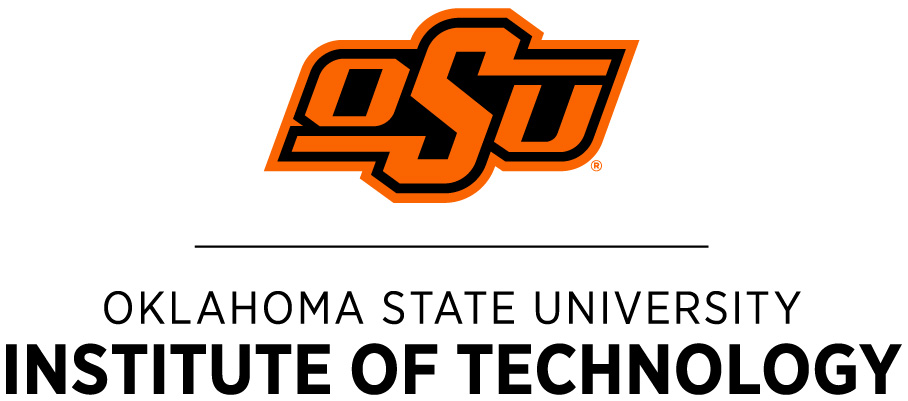
The Oklahoma State University Institute of Technology is Oklahoma's leader in applied technical education, offering hands-on, skills-based training tailored to today's industry needs.
Founded in 1946, OSUIT is part of the OSU Polytech initiative centered on workforce development. Located in Okmulgee, OSUIT is known for its high academic standards, world-class laboratory environments, reciprocal partnerships with businesses and industry, and top career placement rates in the region. OSUIT provides a range of programs, including accelerated bachelor of technology and associate degree programs, designed to meet global workforce demands. The institute is committed to promoting STEM education and preparing the next generation of IT professionals.
OSUIT has four schools under its purview:
- School of Arts, Sciences and Health
- School of Creative and Information Technologies
- School of Engineering and Construction Technologies
- School of Transportation and Heavy Equipment
Oklahoma State University Library

The OSU Library refers to the comprehensive library system at Oklahoma State University, encompassing the Edmon Low Library, two remote shelving locations and three branch libraries.
The Edmon Low Library serves as the main physical location for the collection and is often used to refer to the building itself or the site of events. In contrast, "OSU Library" describes the organization, its administration, services, resources, and sponsorships. The two remote shelving facilities in Stillwater, the Library Annex on Boomer Road and the Library Auxiliary Building on Hall of Fame Avenue, house older and more fragile library materials.
The terms "OSU Library" and "OSU Libraries" are often used interchangeably, with a preference for the singular form for simplicity.
OSU’s branch libraries are
- John Rex Cunningham Architecture Library, Room 160, Donald W. Reynolds School of Architecture Building. This branch library acquires materials and provides services to the School of Architecture and related programs elsewhere on campus.
- Mary L. Williams Education and Teaching Library, Room 001, Willard Hall. The Education and Teaching Library provides educational resources, print and online research materials, and readers' advisory assistance to the teacher education students and faculty of the College of Education's School of Teaching and Curriculum Leadership, its Aviation and Space Education program, the College of Human Sciences' Department of Human Development and Family Science, the Agricultural Education program, and the College of Arts and Sciences Department of Music's Education Program.
- William E. Brock Memorial Library, Room 102 McElroy Hall. This library primarily serves the College of Veterinary Medicine.
Oklahoma State University Museum of Art
The Oklahoma State University Museum of Art, located at 720 S. Husband Street in Stillwater, Oklahoma, serves as Oklahoma State University's official exhibition hall for art.
Since its opening in 2014, the museum has been dedicated to enriching the campus and community through its diverse permanent collection of more than 5,000 paintings, photographs and unique artworks from around the world. The museum hosts a variety of exhibitions — including traveling shows — and educational programs, making art accessible to audiences of all levels. It also significantly fosters artistic expression among students and the broader community, offering free admission to its exhibitions and events.
The museum's mission is to advance creativity, create lifelong learners, and provide cultural and civic engagement through its exhibitions and programs.
Oklahoma State University-Oklahoma City
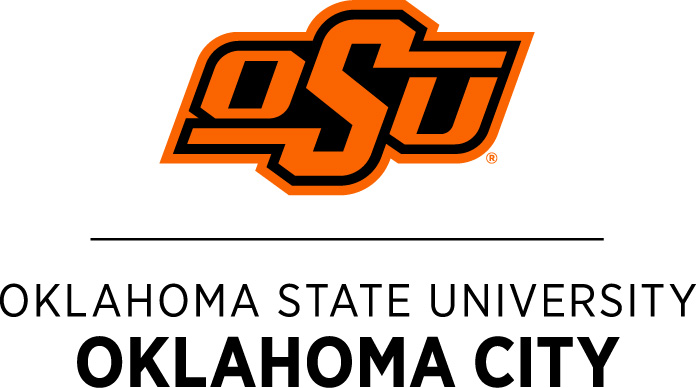
Oklahoma State University-Oklahoma City is a top-tier institution that combines a first-class education with the conveniences of an advantageous location and tremendous degree affordability.
Founded in 1961, OSU-OKC is OSU’s metropolitan branch campus in the state’s capital city, geared toward transfer students, working adults, and first-generation students. The campus offers flexible and workforce-driven academic programs in various fields, including health care, public safety and STEM. OSU-OKC serves thousands of students each semester through in-person, hybrid and online classes and is part of OSU Polytech, which focuses on workforce development to serve the state of Oklahoma, the nation, and the world. The university is committed to addressing workforce needs and providing abundant resources for students.
OSU-OKC has four schools under its purview:
- School of Health Sciences
- School of Human Services
- School of Professional Studies
- School of Science, Technology, Engineering and Mathematics
Oklahoma State University-Tulsa
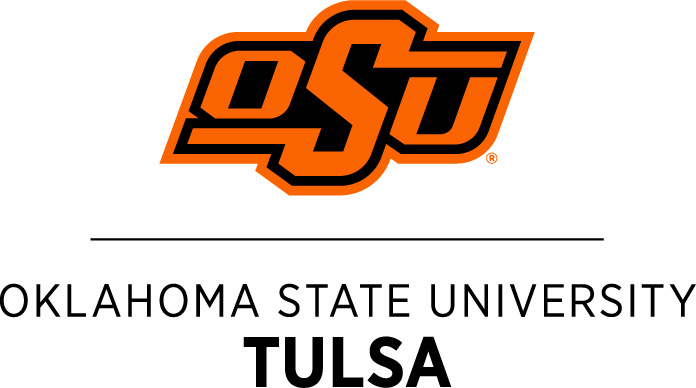
Oklahoma State University-Tulsa is the metropolitan branch campus of Oklahoma State University, located in the heart of downtown Tulsa's Greenwood District.
It was established on Jan. 1, 1999, following the approval of Oklahoma Senate Bill 1426 in May 1998. Before its establishment, the University Center at Tulsa was created in 1986 to address the lack of a public four-year university presence in Tulsa. UCAT was composed of OSU, Langston University, the University of Oklahoma and Northeastern State University, primarily offering graduate-level academic programming. The dissolution of UCAT led to the creation of OSU-Tulsa, with a new focus on bringing the full possibilities of OSU's land-grant mission to Tulsa.
OSU-Tulsa offers a wide range of bachelor's, master's and doctoral degree programs, as well as graduate certificates and non-credit professional development courses. The campus is designed to cater to transfer students and working adults, providing flexible schedules, online learning options and tailored support services. Through teaching, research and community building, OSU-Tulsa engages communities and empowers servant-leaders to meet society’s most pressing challenges. The College of Professional Studies is housed on the campus.
OSU-Tulsa is part of OSU Polytech, focusing on workforce development to serve the state of Oklahoma, the nation and the world.
Oklahoma Water Resources Center
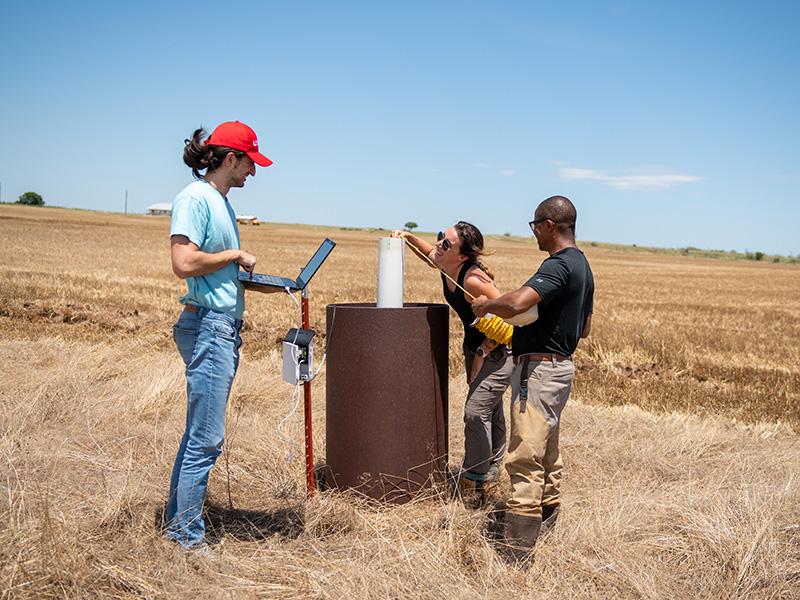
The Oklahoma Water Resources Center was established as a result of the Water Resources Research Act of 1964, which authorized the establishment of a water resources research and technology institute or center at the land-grant university in each state.
Although headquartered at OSU, the OWRC serves the entire state. OWRC strives to help Oklahoma achieve high levels of water quality and sustainable use of our region’s water through integrated programs of research, education, training and technology assistance.
Its vision is empowering informed decision making and enriching understanding of the state’s most critical water management issues through engagement, education and actionable science. OWRC supports research on all topics related to understanding and managing Oklahoma water resources; provide education and training opportunities for water specialists, professionals and students; and facilitate team building, outreach and information transfer in the Oklahoma water resource community to provide solutions to water issues.
Okmulgee
Okmulgee, Oklahoma, is a city rich in history and cultural significance and is home to the Oklahoma State University Institute of Technology.
It serves as the county seat of Okmulgee County and is the headquarters of the Muscogee (Creek) Nation. It was founded in 1868 following the Civil War when the Creek Nation began restoring order to their homeland. The Creek Nation established Okmulgee as their capital and came together in a general council to build a capitol building. A post office was opened in the town on April 29, 1869, originally spelled "Okmulkee" until it was changed to "Okmulgee" on Nov. 15, 1883. Its name derives from the Muskogee word "okimulgi," which means "boiling waters." The name reflects the area's connection to nearby rivers and springs.
The city is known for its historic architecture, including the Creek Council House, a symbol of the Muscogee (Creek) Nation's heritage. Okmulgee offers a blend of small-town charm and modern amenities, with various community events and recreational activities. As of 2024, Okmulgee’s population is approximately 11,404.
O.L. Lackey Residence Hall (OSUIT)
O.L. Lackey Residence Hall at the Oklahoma State University Institute of Technology is a three-story all-male residence hall with shared rooms and community bathrooms on each floor.
Each room is equipped with local telephone service, cable and internet access, ensuring residents have the amenities for a comfortable stay. Primarily used to house new male traditional residents during the fall and spring semesters, Lackey Hall also offers unlimited use of laundry facilities, which are included in the housing cost. It is named after Ona Luther “Bruce” Lackey (May 21, 1897-April 22, 2000). Lackey was an ardent supporter of higher education in the Okmulgee area who lived through three centuries, 17 presidents and under 25 Oklahoma governors.
Built in 1965, its convenient location off of Covelle Drive and supportive environment make it an ideal choice for students seeking a vibrant campus life.
Old Central (OSU-Stillwater)
Historically known as the College Building, Old Central is the oldest building on the Oklahoma State University campus in Stillwater.
Constructed in 1894, it was the first permanent building on the Oklahoma A&M campus and was originally the only academic building until 1900. The building's bell clapper symbolized university life and later a key element in the Bedlam rivalry between OSU and the University of Oklahoma. Designed by architect Herman McClure Hadley (April 13, 1850-Oct. 11, 1904), the building was constructed in 1894 using a mix of brick, timber and sandstone. Its eclectic design features a tower that has a somewhat Germanic appearance, reflecting the architectural styles of the late 19th century.
Despite structural challenges over the years, including serious cracks and condemnation in 1925, Old Central was restored and placed on the National Register of Historic Places in 1971. Today, it stands as a testament to the university's rich history and enduring legacy.
Osage Casino Hotel Student Union (OSU-Tulsa)
The Osage Casino Hotel Student Union at Oklahoma State University-Tulsa serves as a central hub for student activities and services on campus.
Built in 2020 inside North Hall, the Student Union offers a variety of amenities, including meeting rooms and recreational spaces designed to enhance the student experience. It is a place where students can gather, socialize and participate in a wide range of events and programs, fostering a sense of community and engagement.
The Student Union plays a crucial role in supporting the academic and social needs of the OSU-Tulsa student body.
OSU/A&M Board of Regents
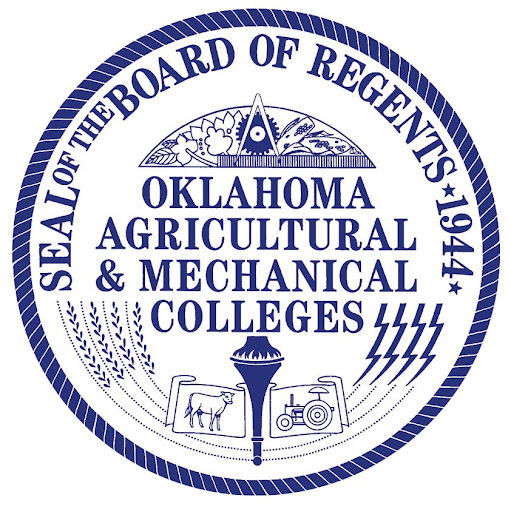
The OSU/A&M Board of Regents is the governing body for the Oklahoma Agricultural and Mechanical Colleges, which includes Oklahoma State University, Connors State College, Langston University, Northeastern Oklahoma Agricultural and Mechanical College, and Oklahoma Panhandle State University.
Established in 1944 under Section 31a, Article 6 of the Oklahoma Constitution, the Board comprises nine members: eight appointed by the governor with the advice and consent of the Senate, and the ninth being the President of the State Board of Agriculture.
The Board is responsible for overseeing the management, supervision, and growth of these institutions, ensuring they fulfill their educational missions and serve the needs of the state of Oklahoma.
OSU/A&M System
The OSU/A&M System is a comprehensive network of institutions that includes Oklahoma State University, OSU’s branch campuses, and the affiliated colleges of Connors State College, Langston University, Northeastern Oklahoma A&M College and Oklahoma Panhandle State University.
This system is dedicated to providing accessible and affordable higher education across Oklahoma. It encompasses a range of campuses and programs, including agricultural and mechanical colleges, which focus on practical and technical education.
The OSU/A&M System is committed to fostering academic excellence, research and community engagement, ensuring that students receive a well-rounded education that prepares them for successful careers.
Parker Hall (OSU-Stillwater)
Parker Hall at Oklahoma State University is part of the Scott-Parker-Wentz Triplex and offers traditional residential experiences for students.
Built in 1962, Parker Hall was named after the Comanche Nation leader Quanah Parker (1845-Feb. 23, 1911). In 1968, residents were allowed to submit names and vote for whom the hall should be named. When the election results were tallied, Quanah Parker won by a landslide. The hall provides a variety of amenities, including community bathrooms with private stalls and showers, a community kitchen, free unlimited laundry facilities, living rooms, lounges and a meditation room. It is located near the Wentz Lane Parking Garage and is close to dining options such as Central Market Place, Cafe Libro and Roots.
Parker Hall also features specialized services and programs for first-year College of Engineering, Architecture and Technology students through a dedicated Living Learning Program.
Parking and Transportation
Parking and Transportation is responsible for assigning and monitoring all automobile, motorcycle and bicycle parking on campus and supporting shuttle bus transportation for students to various locations throughout campus.
PARKING LOT REFERENCE: Parking lots on the Oklahoma State University campus are designated by a combination of letters and numerals. When referring to a specific parking lot on the Oklahoma State University campus, do not use a hyphen between the alphabetic and numeric designation, i.e.,10, 63A, etc.
Example: “Students may use the 5A parking lot at the corner of…”
Patchin-Jones Hall (OSU-Stillwater)
Patchin-Jones Hall at Oklahoma State University is a deluxe-suite-style residential facility accommodating approximately 160 residents.
Built in 2000, the hall offers two different floor plans, featuring two shared or four private bedrooms, a living room, kitchenette and two bathrooms. Each furnished unit includes free laundry facilities, community kitchens, study and recreational spaces. The hall is named in honor of OSU Dean of Women Zelma F. Patchin (1909-2001) and OSU alumnus Jay C. Jones (Dec. 23, 1955-Aug. 23, 1986), a student leader in the Residential Hall Association.
Located west of Wentz Hall and south of The Villages, Patchin-Jones Hall is near the University Testing and Assessment Center and various dining options.
Patillo Community Center (OSU-Stillwater)
The Patillo Community Center at Oklahoma State University serves the Kamm-Peterson-Friend Neighborhood.
It is between Hall of Fame Avenue and McFarland Street, near the College of Veterinary Medicine. Built in 2000, this center offers desk services and recreational areas for many residential halls, providing a welcoming space for students to gather and engage in various activities. Named after Naomi O. "Oleta" Patillo, a long-serving OSU food services director whose career spanned from 1949 to 1983, the center honors her contributions to the university community.
The Patillo Community Center is also conveniently situated near the Intramural Fields and the Colvin Recreation Center.
Paul Miller Journalism and Broadcasting Building (OSU-Stillwater)
The Paul Miller Journalism and Broadcasting Building at Oklahoma State University is home to the School of Media and Strategic Communications.
Named after Paul Miller (Sept. 28, 1906-Aug. 12, 1991), a distinguished alumnus and former president and CEO of Gannett Co., the building serves as a journalism and broadcasting education hub. It houses broadcast and recording studios, the O’Colly newsroom and other facilities designed to provide students with hands-on experience in media production and communication.
The building was constructed in 1918 and was originally the home of the young university’s chemistry department.
Payne Ellis Hall (OSU-Stillwater)
Payne Ellis Hall at Oklahoma State University is a three-story building located at the corner of Garfield Street and McElroy Road, part of the Morrison Neighborhood.
It offers apartment-style living with private or shared bedrooms, a living room, a full-size kitchen, and in-unit washer and dryer. Built in 2001, the hall accommodates 110 undergraduates of all classifications and majors, including first-year students. Named after distinguished community leader Nancy Payne Ellis, an OSU alumna, Payne Ellis Hall is conveniently situated near the Griffith Community Center and various dining options.
The building provides a comfortable and modern living environment, fostering a sense of community among its residents.
Pete's Pantry
Pete's Pantry at Oklahoma State University is a permanent program dedicated to addressing food insecurity among the Cowboy community.
Located in the OSU-Stillwater Student Union basement in room 042 and on the OSUIT campus, Pete's Pantry provides free food and basic essentials to all OSU students, faculty and staff who present a valid OSU ID. The pantry is an affiliate of the Regional Food Bank of Oklahoma and operates with the support of donations and partnerships, such as the ongoing collaboration with the OSU Student Farm, which supplies fresh produce based on seasonal availability.
By offering a variety of non-perishable foods and toiletry items, Pete's Pantry plays a crucial role in ensuring that members of the OSU community have access to the resources they need to thrive academically and personally.
Pete's Pet Posse
Pete's Pet Posse at Oklahoma State University is the nation's most comprehensive university-based pet therapy program, founded in 2013 by former First Cowgirl Ann Hargis and Kendria Cost.
The program aims to enhance the well-being of the Cowboy family through interactions with professionally trained and nationally certified pet therapy teams. With nearly 90 pet therapy teams across the OSU system, Pete's Pet Posse creates moments of joy, reduces stress and builds bonds within the community.
The program is self-funded, relying on private donations to support its operations, including providing therapy dogs with official OSU tartan vests, leashes and trading cards.
FIRST REFERENCE: Use full name "Pete's Pet Posse."
SECOND REFERENCE: For all subsequent references, it is acceptable to use the term "P3."
Peterson-Friend Halls (OSU-Stillwater)
Peterson-Friend Halls at Oklahoma State University are co-ed residence halls located near the Pattillo Community Center.
These halls house approximately 210 residents and offer apartment-style living with private bedrooms, a living room, a full-size kitchen, and in-unit washer and dryer, Built in 2000, they form a U-shape around a courtyard, providing a welcoming and communal environment for students.
They are named in honor of long-serving veterinary medicine faculty members Dr. Duane Russell Peterson (Dec. 16, 1921-May 31, 2006) and Dr. Jonathan David Friend (July 28, 1921-Nov. 13, 2008).
Petroleum Technology Classroom Building (OSU-Stillwater)
The Petroleum Technology Classroom Building at Oklahoma State University is a dedicated facility designed to support the educational and research needs of students and faculty in petroleum technology.
With a gross square footage of 12,385.12 and a net square footage of 11,722.99, the building provides ample space for classrooms, laboratories, and collaborative work areas. Built in 1990, it has modern amenities and technology to facilitate advanced learning and research in petroleum engineering and related disciplines.
Physical Sciences Building (OSU-Stillwater)
The Physical Sciences Building at Oklahoma State University is a central facility for the Department of Physics.
This building, with 183,772.54 square feet, houses classrooms, offices and state-of-the-art research laboratories. It supports various academic and research activities, providing students with opportunities to engage in cutting-edge scientific studies.
Built in 1958, its design and infrastructure are tailored to foster an environment conducive to learning and innovation in the physical sciences.
Pickens, Thomas Boone
Thomas Boone Pickens (May 22, 1928-Sept. 11, 2019) was a legendary energy executive,
philanthropist and proud alumnus of Oklahoma State University.
Born in Holdenville, Oklahoma, Pickens graduated from OSU in 1951 with a degree in geology. He founded one of the nation's largest independent oil companies and pioneered shareholder advocacy. Pickens' transformative impact on OSU is unparalleled, with his donations totaling over $650 million, benefiting academic and athletic programs. His $165 million gift in 2006 remains the largest single donation to college athletics.
The Boone Pickens Legacy Experience at Boone Pickens Stadium is a testament to his remarkable life and enduring legacy.
FIRST REFERENCE: Use full name "T. Boone Pickens."
SECOND REFERENCE: For all subsequent references, it is acceptable to use "Pickens."
Pistol Pete
Pistol Pete is the athletics mascot of Oklahoma State University, inspired by Frank Boardman Eaton (Oct. 26, 1860-April 8, 1958).
Eaton, a former cowboy, gunslinger, scout, trail rider and rumored deputy U.S. Marshal,
became the university's mascot in 1923 after leading Stillwater's Armistice Day parade.
Eaton was born in Hartford, Connecticut. His family moved to Twin Mound, Kansas, when
he was 8. After witnessing the murder of his father by six former Confederates, Eaton
vowed to avenge his father's death. He honed his shooting skills and earned the nickname
"Pistol Pete" at 15 after outshooting the cavalry's best marksmen at Fort Gibson,
Oklahoma. Eaton tracked down and killed his father's murderers, later becoming a lawman
and fighting alongside the military. Eaton settled in Perkins, Oklahoma, where he
became a local hero known for his quick draw abilities, colorful personality, and
storytelling.
Eaton was a symbol of Oklahoma State University until his death. Eaton's legacy continues to be celebrated at Oklahoma State University, with a monument dedicated to him on campus. His life and adventures are chronicled in his autobiography, "Pistol Pete, Veteran of the Old West," published in 1952. The Pistol Pete mascot costume features traditional cowboy attire and a headpiece resembling Eaton.
Over the years, Pistol Pete has become a symbol of the Cowboy spirit, representing the university at athletic events, parades, community festivals and more. Two students are selected to portray Pistol Pete each year, sharing around 650 appearances annually.
Pistol Pete Plaza (OSUIT)
The Pistol Pete Plaza at the Oklahoma State University Institute of Technology is an iconic landmark dedicated to Frank "Pistol Pete" Eaton, the symbol and mascot of Oklahoma State University.
Unveiled on Oct. 26, 2015 — Eaton’s 155th birthday — the plaza features a 12-foot-tall bronze statue of Pistol Pete, sculpted by Oklahoma artist Wayne Cooper, standing on a 6-foot-tall stone base.
Located at the campus' south entrance, the statue welcomes students, faculty, staff and visitors, serving as a source of pride and a popular backdrop for photos.
Police and Fire Training Building (OSU-OKC)
The Police and Fire Training Building at Oklahoma State University-Oklahoma City is a key facility dedicated to educating and training future first responders.
This building houses programs in police science, fire protection and public safety management, providing students with the necessary skills and knowledge to excel in their respective fields. Built in 1961, the facility is part of OSU-OKC's broader commitment to workforce development, serving the needs of the state of Oklahoma and beyond.
The building is equipped with modern classrooms, simulation labs and practical training areas to ensure comprehensive, hands-on learning experiences for students.
Police Department
The Oklahoma State University Police Department is a fully accredited law enforcement agency responsible for the safety and security of all properties, students and employees of Oklahoma State University while on campus.
The department’s jurisdiction includes all property owned, leased, rented or under the control of the Board of Regents for the Oklahoma Agricultural and Mechanical Colleges.
OSUPD patrols both the main campus and investigates all crimes on campus.
FIRST REFERENCE: Use full name "Oklahoma State University Police Department."
SECOND REFERENCE: For all subsequent references, it is acceptable to use the term "OSUPD."
Prairie Arts Center (OSU-Stillwater)
The Prairie Arts Center at Oklahoma State University is a vibrant community space in Stillwater, Oklahoma, that provides a platform for creativity and cultural exchange. Established as a partnership between OSU and the City of Stillwater in 2017, the center is committed to promoting and supporting the arts in the Stillwater community and beyond.
The Prairie Arts Center offers classes and workshops in various mediums, including painting, pottery, screen printing, metal smithing, stained glass and fiber arts. The center hosts community events — including the annual Stillwater Arts Festival — and K12 programming, with a mission to engage and inspire art enthusiasts of all ages.
Established as a partnership between OSU and the City of Stillwater in 2017, the center is committed to promoting and supporting the arts in the Stillwater community and beyond.
President
The President of Oklahoma State University leads the OSU system, which serves as an inclusive learning, teaching, and outreach institution through its land-grant mission.
This role encompasses oversight of the university's campuses in Stillwater, Tulsa, Oklahoma City and Okmulgee, as well as its extension offices across the state. The President is responsible for guiding the university's strategic direction, fostering academic excellence, and ensuring the institution's commitment to serving the needs of Oklahoma and its citizens.
FIRST REFERENCE: President is the highest rank, so the first reference will always be President John Doe. If mentioning a past president, lowercase the title.
Example: former president Burns Hargis.
SECOND REFERENCE: If the president has a doctorate or position of equal title, i.e., military rank, refer to them as Dr. Doe or Col. Doe on the second reference.
THIRD REFERENCE: Just the last name is needed on the third reference.
Example: Doe signed the executive document at OSU.
OSU has had 20 presidents, which are:
1. Robert Barker (1891-94)
2. Henry Elijah Alvord (1894-95)
3. Edmund Dandridge Murdaugh (January-June 1895)
4. George Espy Morrow (1895-99)
5. Angelo Cyrus Scott (1899-1908)
6. John Henry Connell (1908-14)
7. James William Cantwell (1915-21)
8. James Burnette Eskridge (1921-23)
9. George Wilson (June-July 1923)
10. Bradford Knapp (1923-28)
11. Henry Garland Bennett (1928-51)
12. Oliver Siralvo Willham (1952-66)
13. Robert Balthasar Kamm (1966-77)
14. Lawrence L. Boger (1977-88)
15. John Roy Campbell (1988-93)
16. James Edmund Halligan (1994-2003)
17. David James Schmidly (2003-07)
18. Vaden Burns Hargis (2008-21)
19. Kayse Marie Shrum (2021-25)
20. James Daniel Hess (2025-present)
Professional Studies (College of)
The College of Professional Studies at Oklahoma State University, based at OSU-Tulsa, is designed to address the workforce needs of local industries and agencies in Tulsa.
It offers flexible bachelor's degree programs tailored for working adults with some college credit but no degree, helping them complete a bachelor's degree that adds value to their current career. The college provides adaptable programs with flexible credit for prior learning, transfer credit and military credits.
Focusing on practical, relevant coursework, the College of Professional Studies ensures that every class helps students build skills they can use in the workplace.
Professor
When referring to a faculty member, use the following appropriate descriptions in accordance with their title:
- Professor
- Assistant Professor
- Associate Professor
- Instructor
- Lecturer
Prosser Apartments (OSU-Stillwater)
Prosser Apartments at Oklahoma State University, part of the Prosser Neighborhood, offers unfurnished, two-bedroom/one-bathroom units for students who qualify for year-round housing registration, including family and graduate student housing.
Built in 1957, these two-story buildings provide ample parking and open green spaces nearby. The apartments include utilities such as electric, gas, water, sewer, trash/recycling, internet, Wi-Fi, cable television and free laundry. In 1998, they were named after Ethel Mary Prosser, a pivotal figure in student housing administration at OSU for over 30 years. She directed the first distinct housing office on campus, overseeing the building and opening of eight residence halls, including Bennett Hall.
Located north of McElroy Road between Garfield and Walnut Streets, Prosser Apartments are conveniently situated near the Family Resource Center and University Laundry, with easy access to dining options like Adams Market and North Dining Hall.
Provost
Dr. Jeanette Mendez was appointed provost and senior vice president in May 2022 following a nationwide search. She joined the OSU political science faculty in 2005 and has since served in various leadership positions, including vice provost of academic affairs, interim dean of the College of Arts and Sciences and associate dean for research and facilities. Mendez earned her bachelor's degree in combined sciences from Santa Clara University, a master's degree and a Ph.D. in political science from Indiana University.
The provost is responsible for the university's overall academic mission. This involves promoting academic excellence with the president, deans, faculty, students, and staff.
The Office of the Provost houses the following units:
- Academic Innovation & Student Success
- Faculty Success
- Graduate & Postdoctoral Affairs
- Institutional Effectiveness
- International Affairs
- Outreach & Engagement
- Student Life
For more on Provost Mendez, visit her website.
Psychology Building (OSU-Stillwater)
The Psychology Building at Oklahoma State University is home to the Department of Psychology, which offers comprehensive training in understanding human behavior, statistical and research methods.
Built in 1936, the building houses various facilities, including the Psychological Services Center, which provides services to children, adolescents and adults, and the OSU Psychology Museum and Resource Center, offering hands-on learning experiences.
The department is known for its undergraduate and graduate programs, nationally and internationally recognized research and its commitment to promoting behavioral science.
Public Safety Training Building (OSU-OKC)
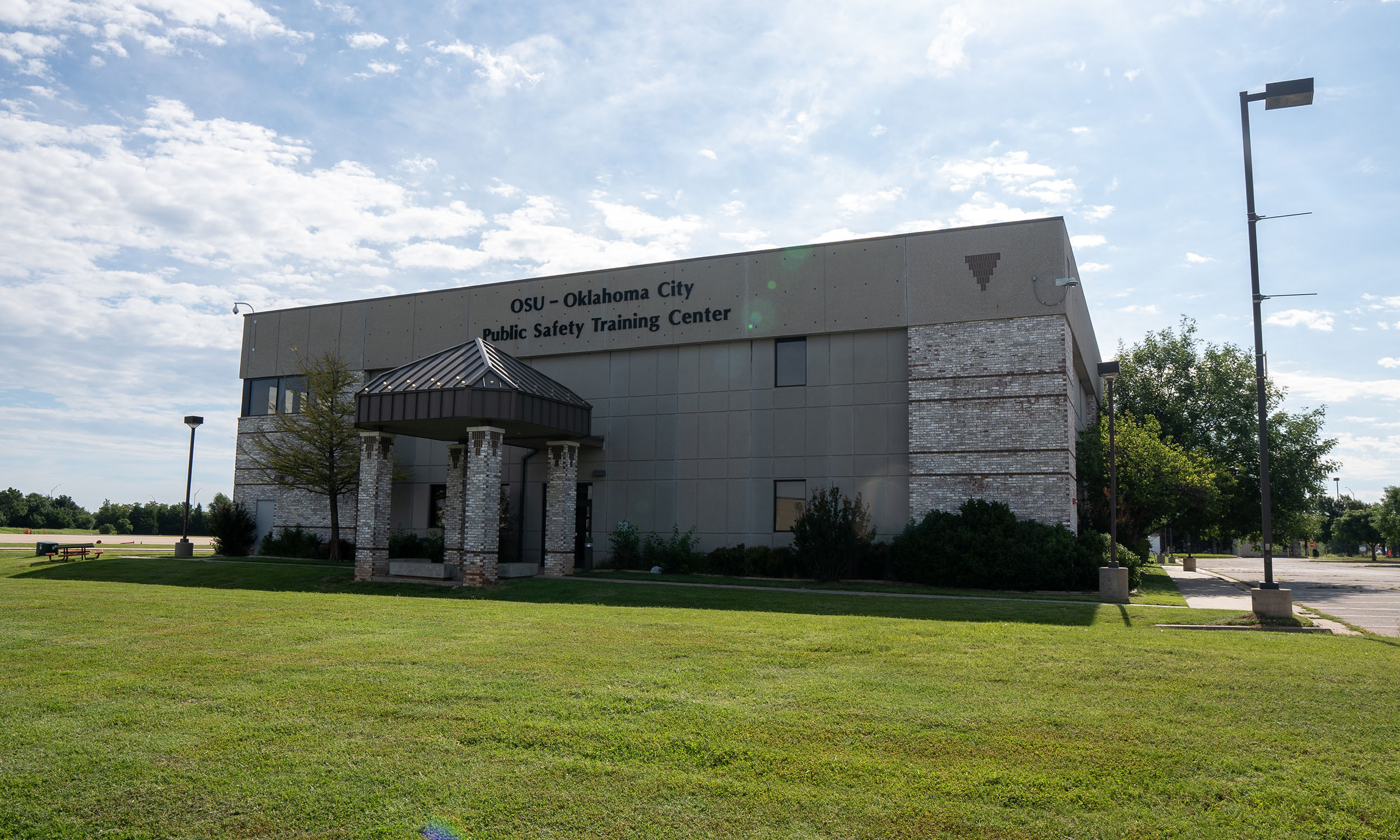
The Public Safety Training Building at Oklahoma State University-Oklahoma City is a dedicated facility that supports the university's commitment to training future first responders.
This building houses programs in police science, fire protection and public safety management, providing students with the essential skills and knowledge needed for careers in law enforcement and emergency services. Built in 2009, the facility has modern classrooms, simulation labs and practical training areas to ensure comprehensive, hands-on learning experiences.
The Public Safety Training Building reflects OSU-OKC's dedication to workforce development and serving the community's safety needs.
Ray and Linda Booker OSU Flight Center (OSU-Stillwater)
The Ray and Linda Booker OSU Flight Center is a state-of-the-art aviation education and training facility.
Officially opened in 2022, the 11,500-square-foot center is located southwest of Stillwater Regional Airport and features advanced simulator technology, debriefing rooms, a student lounge, an academic suite and flight simulation rooms. Named in recognition of a generous $1 million gift from Dr. Doyle Ray (Nov. 26, 1934-Aug. 5, 2019) and Linda Booker, both passionate aviation enthusiasts and longtime OSU supporters, the center aims to enhance the student experience and support the growth of OSU's aviation program within the College of Education and Human Sciences.
The facility also hosts programs like the Air Force's Aim High Flight Academy, providing an unparalleled learning environment for aspiring pilots.
FIRST REFERENCE: Use full name "Ray and Linda Booker OSU Flight Center."
SECOND REFERENCE: For all subsequent references, it is acceptable to use the term "Booker Flight Center."
Richmond Hill Research Complex (OSU-Stillwater)
The Richmond Hill Research Complex, located at 5202 N Richmond Hill Road in Stillwater, is a state-of-the-art facility that houses several research groups and engineering extension units.
This complex is part of Oklahoma State University's College of Engineering, Architecture and Technology and is dedicated to fostering innovation and discovery through advanced research and development.
The facility supports various research activities, providing the necessary infrastructure and resources for faculty and students to engage in cutting-edge projects, contributing to the university's mission of advancing knowledge and technology.
Robert M. Kerr Food and Agricultural Products Center (OSU-Stillwater)
The Robert M. Kerr Food and Agricultural Products Center at Oklahoma State University is dedicated to supporting and advancing Oklahoma's food and agricultural industries.
As part of the Division of Agricultural Sciences and Natural Resources, FAPC focuses on developing value-added food and agricultural enterprises to retain products, jobs and revenue within the state. Built in 1997, it is named after Robert Mark Kerr (May 20, 1932-Jan. 25, 2006), a prominent figure in Oklahoma's agricultural sector.
The center offers expertise in food processing, safety, quality management, packaging, labeling and regulatory compliance. It also provides training and services to enhance innovation and sustainability in the industry. FAPC aims to help Oklahoma's food and agricultural businesses thrive by providing resources and support for product development and market expansion.
FIRST REFERENCE: Use full name "Robert M. Kerr Food and Agricultural Products Center."
SECOND REFERENCE: For all subsequent references, it is acceptable to use the term "FAPC."
Remember the 4
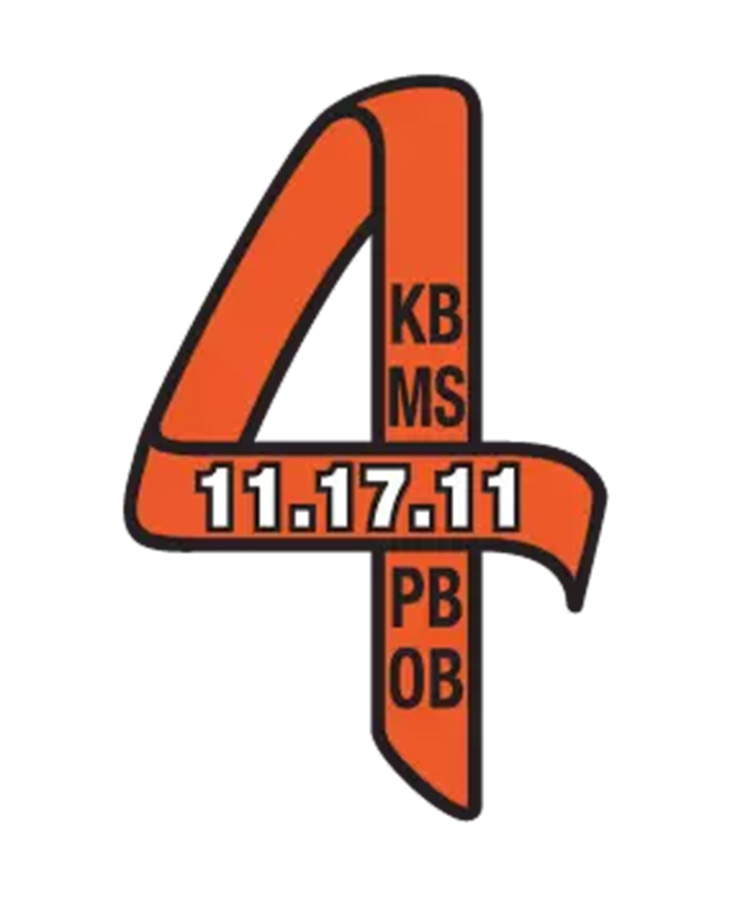 Remember the 4 is an annual event held at Oklahoma State University to honor the memory of 4 members
of the OSU women’s basketball family who tragically lost their lives in a plane crash
on Nov. 17, 2011.
Remember the 4 is an annual event held at Oklahoma State University to honor the memory of 4 members
of the OSU women’s basketball family who tragically lost their lives in a plane crash
on Nov. 17, 2011.
The crash involved a Piper PA-28-180 Cherokee aircraft in the Ouachita National Forest, about eight miles southwest of Perryville, Arkansas, killing all four people on board: Cowgirl basketball coach Kurt Budke, assistant coach Miranda Serna, and OSU supporters Olin and Paula Branstetter. Olin Branstetter, a former Oklahoma state senator and experienced pilot, was flying the aircraft.
The crash occurred during a recruiting trip from Stillwater, Oklahoma, to North Little Rock, Arkansas. The Remember the 4 memorial is northeast of Gallagher-Iba Arena.
Remember the 10

Remember the 10 is an annual event held at Oklahoma State University to honor the memory of 10 members of the OSU men’s basketball family who tragically lost their lives in a plane crash on Jan. 27, 2001.
The event includes a memorial run, which features a 10K, 5K, and one-mile fun run, bringing together the OSU community and supporters to celebrate the lives and legacies of those who perished. The Remember the 10 Run not only serves as a tribute but also raises funds for counseling services at OSU, helping to support students' mental health and well-being.
The plane crash involved a Beechcraft Super King Air 200 aircraft carrying members of the Cowboy basketball team. The plane crashed in a field 40 miles east of Denver, near Strasburg, Colorado. The victims were players Nate Fleming and Daniel Lawson, broadcasters and staff members Will Hancock, Kendall Durfey, Brian Luinstra, Pat Noyes, Bill Teegins and Jared Weiberg, and crew members Denver Mills (pilot) and Bjorn Fahlstrom (co-pilot).
The "Remember the Ten" memorial at OSU is located inside Gallagher-Iba Arena in Stillwater, featuring a bronze statue titled "We Will Remember," created by noted Western sculptor Harold Holden of Kremlin, Oklahoma. Additionally, there is a permanent memorial in the Colorado pasture where the crash occurred.
Remembrance Garden (OSU-Stillwater)
The Remembrance Garden at Oklahoma State University-Stillwater is a serene and reflective space dedicated to honoring the lives of students, faculty, and staff who have passed away.
Located on the southeast entrance to campus near the corner of Knoblock Street and University Avenue, the garden features a water fountain made from two pieces of reclaimed granite, estimated to be over 300 years old, with the phrase "Once A Cowboy, Always a Cowboy" engraved on the stone.
The garden was made possible through the generosity of the estate of Murray Case Sells and was officially opened on April 30, 2022. It serves as a designated area for the Cowboy family to gather, remember, and reflect and hosts an annual Remembrance Service each April.
The garden's design includes elements inspired by the original campus entrance, with a water feature, rock walls and a bench from the Class of 1912.
Schmidly, David James
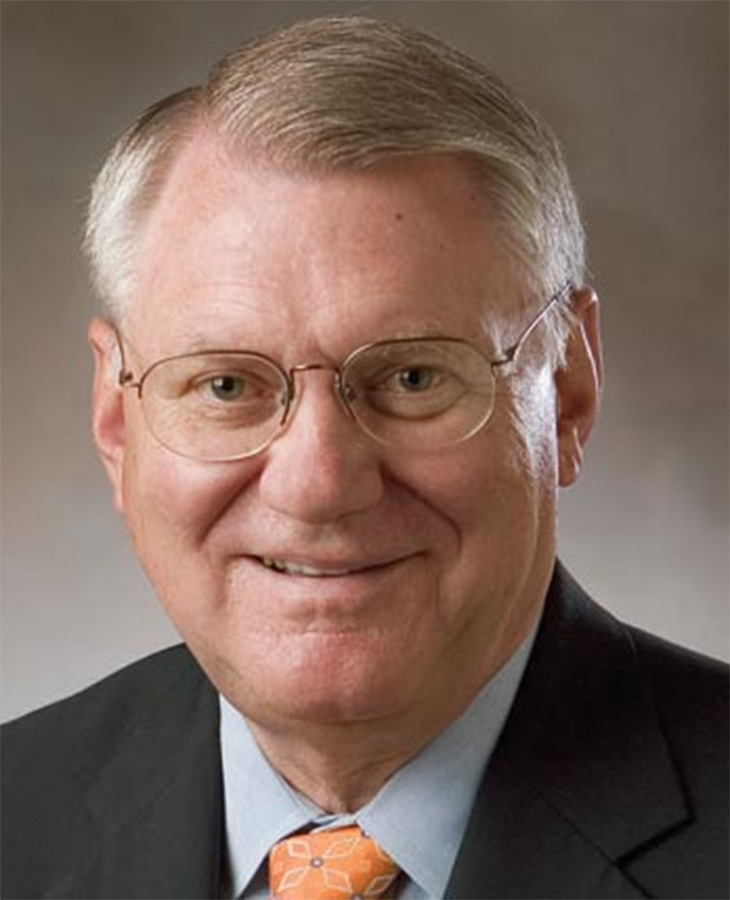 Dr. David James Schmidly (born Dec. 20, 1943) served as the 17th president of Oklahoma
State University and CEO of the OSU System from Jan. 16, 2003, to 2007.
Dr. David James Schmidly (born Dec. 20, 1943) served as the 17th president of Oklahoma
State University and CEO of the OSU System from Jan. 16, 2003, to 2007.
During his tenure, he initiated the first OSU strategic plan, encompassing the university's five campuses and all its units across Oklahoma. Schmidly was instrumental in increasing the visibility of the university and emphasizing its economic value to the state, the region and the nation.
He also oversaw significant achievements, including record enrollment and graduation numbers. Before joining OSU, Schmidly held various academic and administrative positions, including president of Texas Tech University and vice president for research at Texas A&M University.
His contributions to higher education and his dedication to the university left a lasting impact on the OSU community.
Science Building (OSU-OKC)
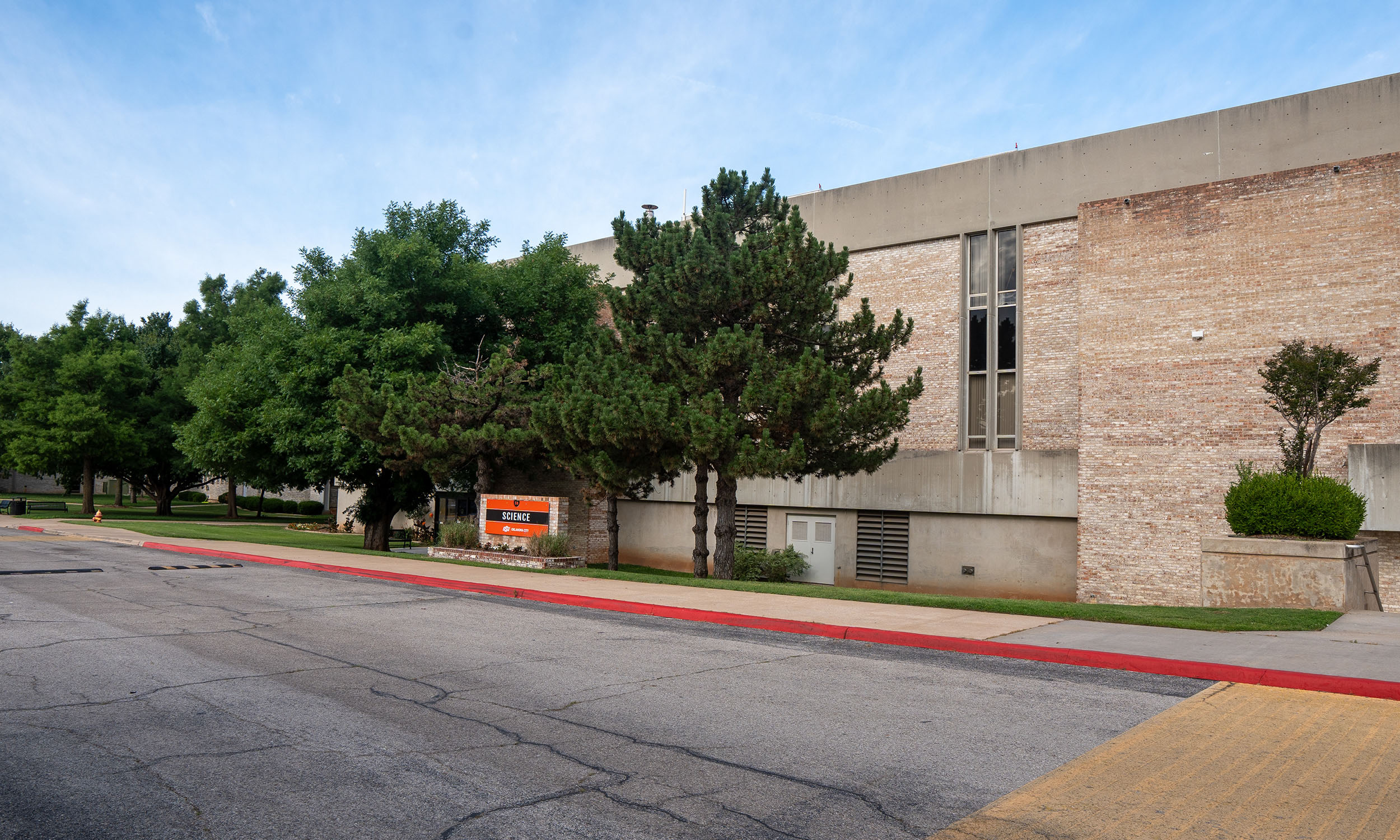
The Science Building at Oklahoma State University-Oklahoma City is a key facility that supports the university's commitment to providing high-quality education in the fields of science, technology, engineering and mathematics.
This building houses the Science Department, which offers a variety of courses and programs designed to prepare students for careers in scientific fields. Equipped with modern classrooms and laboratories, the Science Building provides students with hands-on learning experiences that are essential for their academic and professional development.
The facility reflects OSU-OKC's dedication to fostering a strong foundation in STEM education and supporting the growth and success of its students.
Scott, Angelo Cyrus
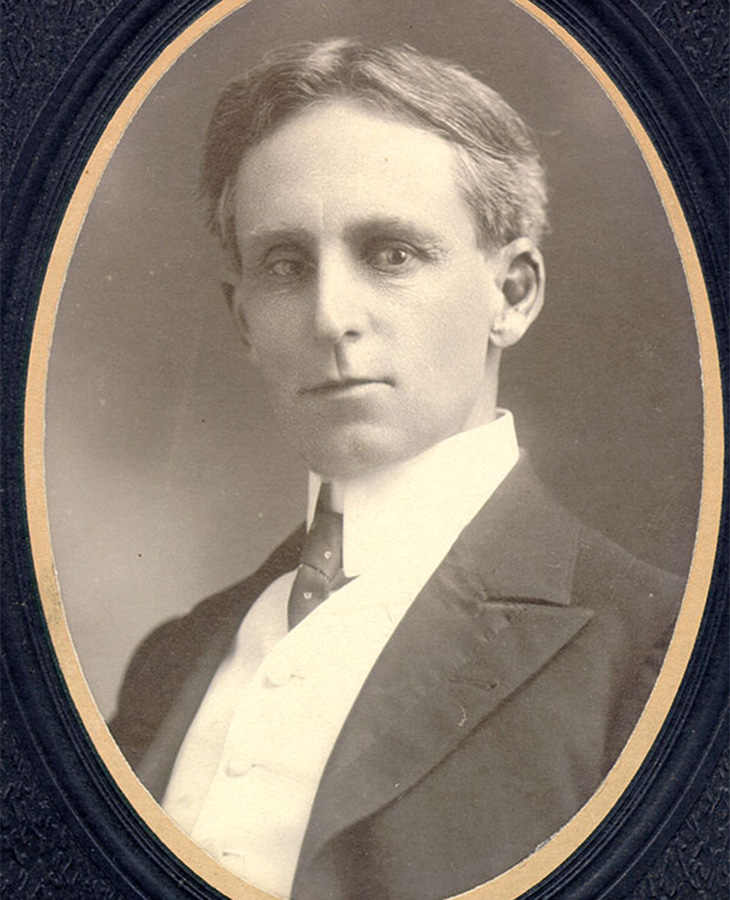 Angelo Cyrus Scott (Sept. 25, 1857-Feb. 6, 1949) served as the fifth president of
Oklahoma Agricultural and Mechanical College (now Oklahoma State University) from
1899 to 1908.
Angelo Cyrus Scott (Sept. 25, 1857-Feb. 6, 1949) served as the fifth president of
Oklahoma Agricultural and Mechanical College (now Oklahoma State University) from
1899 to 1908.
Born near Franklin, Indiana, he completed the bachelor's (1877) and master's (1880) degrees at the University of Kansas. He taught in Kansas public schools for three years and was elected court clerk of Allen County, Kansas. In 1885 he obtained two law degrees from George Washington University and returned to Iola, Kansas, to practice law.
During his tenure at OSU, he significantly contributed to the institution's growth by expanding the faculty, planning Morrill Hall, and writing the school's first fight song. Scott also utilized railroads to enhance extension work, extending the university's reach and impact. Before his presidency, he held various influential roles, including U.S. Commissioner for the Oklahoma Territory and member of the Oklahoma Territorial Legislature.
His leadership and vision helped lay the foundation for the university's future development.
After his presidency, he soon accepted the chairmanship of the University of Oklahoma English department but before starting the job, resigned to accept a professorship in English at Epworth University (now Oklahoma City University). From 1913 to 1923 he was director of OU extension lectures. In 1923 he returned to Epworth to chair the English department until his retirement in 1931.
He died on Feb. 6, 1949, in Oklahoma City. He was 91.
Scott Hall (OSU-Stillwater)
Scott Hall at Oklahoma State University was built in 1962 and is named after Angelo Cyrus Scott (Sept. 25, 1857-Feb. 6, 1949), OSU’s fifth president and a scholar well-versed in philosophy, literature and law. It was built as part of the Scott-Parker-Wentz triplex.
Today, Scott Hall serves as office space for OSU staff.
The five-story building is about one block east of the main campus area.
Seretean Center for the Performing Arts
The Seretean Center for the Performing Arts at Oklahoma State University is a key facility for dramatic and musical events on the Stillwater campus.
Constructed in 1912 as the Fine Arts Center and renamed in 1971 in honor of its principal benefactor, Martin Bud Seretean (May 13, 1924-Aug. 13, 2007), a 1947 OSU graduate and businessman, the center encompasses 75,000 square feet. It includes the 600-seat Vivia Nail Locke Theatre (named in honor of a longtime professor) and the 800-seat Concert Hall.
It also houses teaching studios for theatre and music, various classrooms, a theatre scene lab, computer and design labs, a choral room, a rehearsal hall for band and orchestra, and a well-equipped audio center.
Seretean Wellness Center
The Seretean Wellness Center at Oklahoma State University is a comprehensive facility that promotes health and wellness among students, faculty and staff.
Opened in January 1991 and later renamed in 2006 to honor benefactor Martin Bud Seretean (May 13, 1924-Aug. 13, 2007), the center offers various services and programs, including fitness assessments, group exercise classes, personal training and wellness workshops. The center also features state-of-the-art equipment, a demonstration kitchen and meeting areas to support various wellness initiatives.
As part of the Department of Wellness, the Seretean Wellness Center strives to make OSU America's healthiest campus through its extensive wellness awareness and education efforts.
Sherman E. Smith Training Center
The Sherman E. Smith Training Center at Oklahoma State University is a premier athletic training facility located in Stillwater.
Officially opened in June 2013, the center spans nearly 94,000 square feet and includes an indoor training field large enough to host a soccer field, surrounded by three outdoor practice fields — two grass and one artificial. Named in honor of Sherman Edward Smith (May 22, 1923-June 6, 2011), a 1948 Oklahoma A&M graduate and significant benefactor, the facility provides state-of-the-art amenities for OSU's athletic programs, including six fabric roll-up doors, indoor filming platforms and ample clearance for football practice.
The center's strategic location across from Boone Pickens Stadium underscores its importance to OSU Athletics and its role in supporting student-athletes from various sports.
Shrum, Kayse Marie
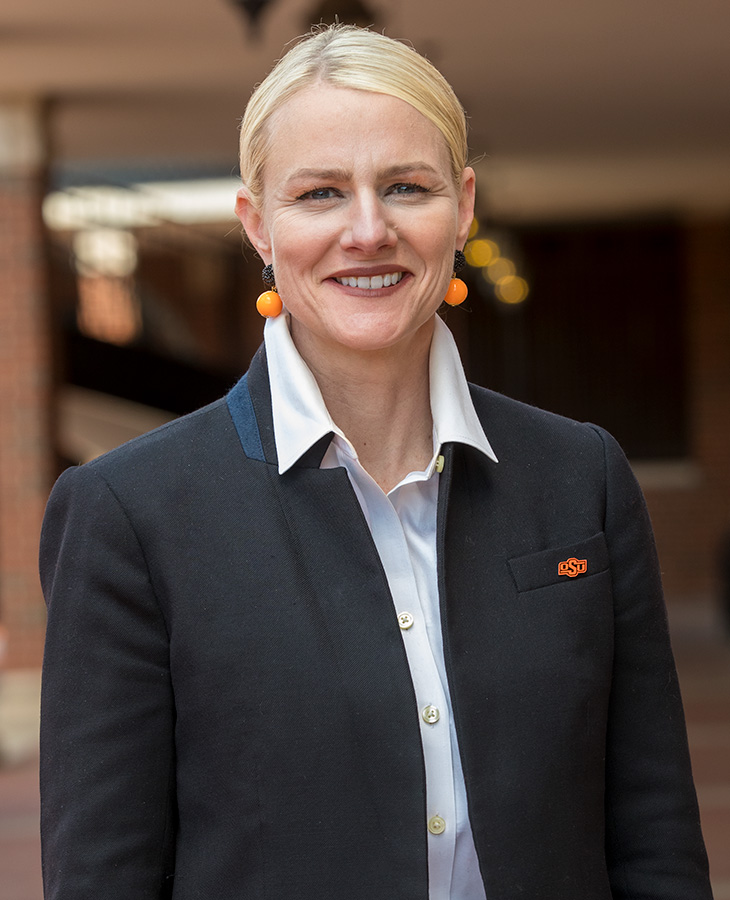 Dr. Kayse Marie Shrum (born Oct. 27, 1972) served as the 19th president of Oklahoma
State University from July 1, 2021, to Feb. 3, 2025.
Dr. Kayse Marie Shrum (born Oct. 27, 1972) served as the 19th president of Oklahoma
State University from July 1, 2021, to Feb. 3, 2025.
From Coweta, Oklahoma, Shrum played softball at Connors State College, where she earned her associate degree in 1992. She continued her education at Northeastern State University and the University of Arkansas before earning her Doctorate of Osteopathic Medicine from Oklahoma State University College of Osteopathic Medicine in 1998.
She was the first woman to lead a public research institution in Oklahoma. During her tenure, Shrum emphasized the university's land-grant mission and its commitment to improving health outcomes for Oklahomans. She was pivotal in enhancing the university's infrastructure and academic programs, including establishing the Human Performance and Nutrition Research Institute.
Shrum's leadership was marked by her dedication to fostering collaboration across various disciplines.
Sitlington Hall (OSU-Stillwater)
Sitlington Hall at Oklahoma State University is a three-story residential building located beside the Griffith Community Center.
Built in 2021, it offers apartment-style living with two private bedrooms, two private bathrooms, a living room, a full-size kitchen, and an in-unit washer and dryer. Named after Oklahoma dairy farmer and rancher Walter Rufus Sitlington (March 21, 1914-Aug. 1, 1995), who bequeathed his estate to OSU for research in agriculture and veterinary medicine, Sitlington Hall is part of the North Monroe Neighborhood and is close to Neal Patterson Stadium.
Social Sciences and Humanities Building (OSU-Stillwater)
The Social Sciences and Humanities Building at Oklahoma State University is a significant facility that houses various departments and offices, including the Department of Communication Sciences and Disorders.
Built in 1934, it is a hub for academic and research activities in the social sciences and humanities. It provides essential resources and spaces for faculty, staff and students to engage in scholarly pursuits and community services.
The building is also known for hosting events and activities that promote interdisciplinary collaboration and intellectual growth.
Spears School of Business
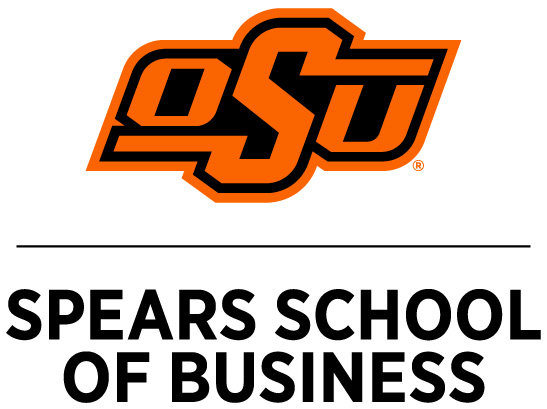
The Spears School of Business at Oklahoma State University is a prestigious institution that prepares students for business success.
Accredited by the Association to Advance Collegiate Schools of Business since 1958, Spears Business offers various undergraduate and graduate degree programs in areas such as accounting, finance, management, marketing, and entrepreneurship. The school is known for emphasizing personal connections and academic excellence, providing students with opportunities to engage in impactful research, community engagement initiatives, and hands-on learning experiences. With a strong focus on innovation and leadership, Spears Business equips students with the essential skills needed to significantly contribute to society.
It is named after Dr. William S. Spears. In November 2004, Spears made what was then the largest academic gift in OSU history, leading the university to rename the College of Business Administration to the William S. Spears School of Business. The name was later shortened to Spears School of Business in 2009. Spears, an OSU alumnus, graduated in 1962 with a bachelor's degree in marketing and has cited his OSU education as a driving force behind his business success. He founded Cenergistic, a Dallas-based energy conservation company, and has been a devoted benefactor and passionate advocate for higher education.
The official magazine of Spears Business is ENGAGE. The research magazine is DISCOVER.
The Spears School of Business dean's office is located at 370 Business Building.
The college houses the following eight departments:
- School of Accounting
- Department of Economics
- School of Entrepreneurship
- Department of Finance
- School of Hospitality and Tourism Management
- School of Marketing and International Business
- Department of Management
- Department of Management Science and Information Systems
For a complete list of majors and minors, please visit their website.
FIRST REFERENCE: Use full name "Spears School of Business."
SECOND REFERENCE: For all subsequent references, it is acceptable to use the term "Spears Business."
Note: The Spears School of Business is housed in the Business Building, so please do not use the college's name in reference to the building itself.
Stanley E. White Hall (OSU-Tulsa)
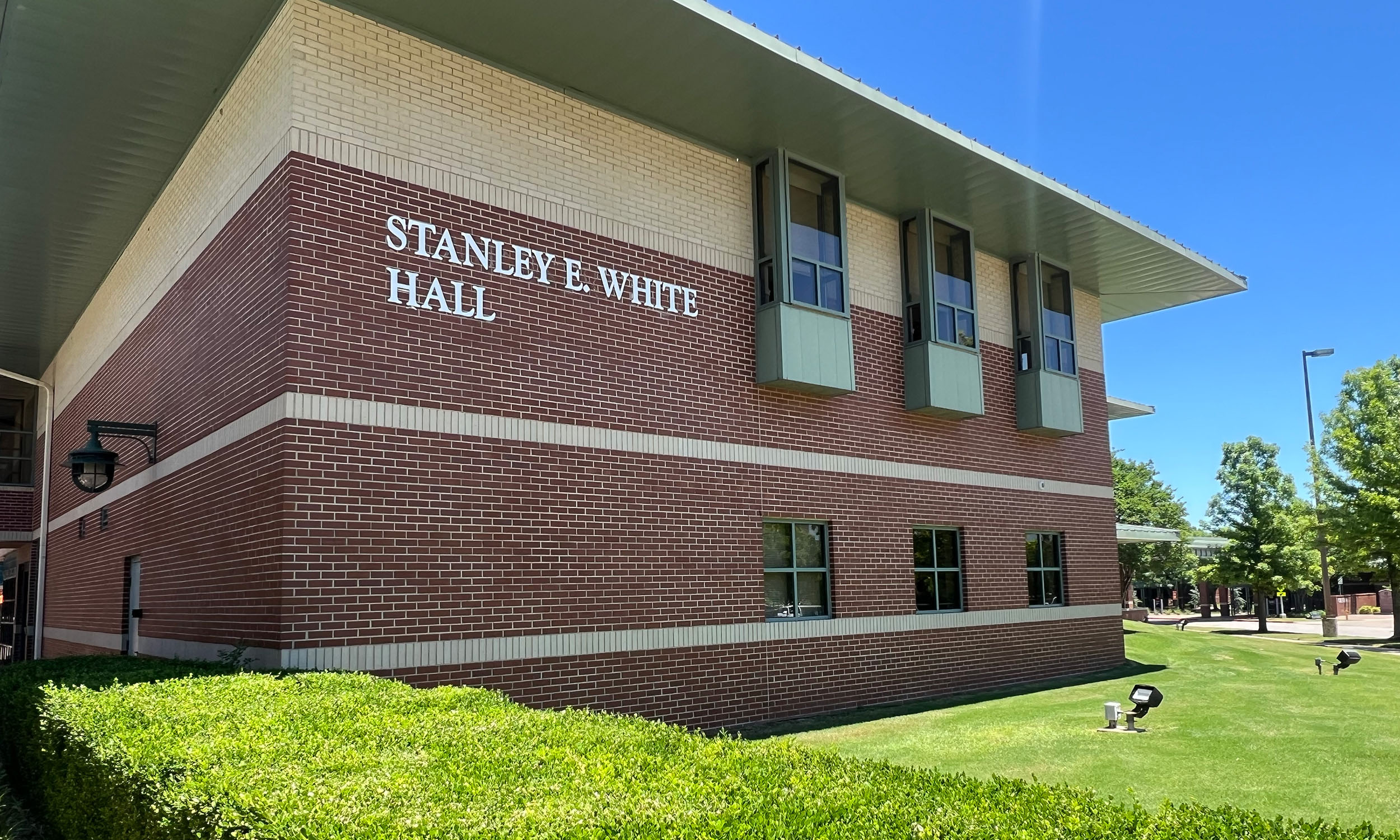
Stanley E. White Hall at Oklahoma State University-Tulsa is a prominent building on the OSU-Tulsa campus, located in the heart of downtown Tulsa's Greenwood District.
Formerly Administration Hall, it was officially renamed in September 2023 in recognition of a generous $1.2 million gift from the Stanley White Foundation. This contribution has significantly supported the Tulsa-based OSU College of Professional Studies, enabling the college to expand its academic offerings, bring on dedicated faculty and staff with industry expertise, and provide students with unparalleled opportunities for practical learning.
The building houses various administrative offices and is a central hub for the university's operations and community activities.
Stevens Apartments (OSU-Stillwater)
Stevens Apartments at Oklahoma State University, part of the Stevens Neighborhood, offers unfurnished, two-bedroom/one-bathroom units for students who qualify for year-round housing registration, including families and graduate students.
Built in 1964, these two-story buildings provide ample parking, playground equipment and open green spaces. The apartments are conveniently located on the north side of Hall of Fame Avenue, next to the intramural fields, and within walking distance of the Family Resource Center.
They are named after John Alton Stevens (Jan. 20, 1902-May 16, 1975), who played a key role in developing and managing Veteran's Village at OSU. A World War II Army veteran, Stevens became Village manager in August 1946, overseeing housing, business affairs, and supporting veterans and their families. He fostered a strong community spirit and later became the first director of Married Student Housing, a position he held until his retirement in 1967. Stevens contributed significantly to planning and developing permanent campus apartments, improving living conditions for veteran and non-veteran students.
The monthly rate includes utilities such as electric, gas, water, sewer, trash/recycling, internet, Wi-Fi, cable television and free laundry use. The Stevens Neighborhood is designed to provide a comfortable and convenient living environment for students, with easy access to key campus locations and amenities.
Stillwater
Stillwater, Oklahoma, is a vibrant city known for its strong community spirit and rich cultural heritage.
As the home of Oklahoma State University, Stillwater boasts a lively college atmosphere with numerous events and activities throughout the year. It is the seat of Payne County and was officially settled during the run into the Unassigned Lands of central Oklahoma on April 22, 1889. The name "Stillwater" became official when a post office was established on May 28, 1889. The name originated from a stream called the Still Water, where early settlers led by Capt. William Lewis Couch settled in dugouts and tents.
The city offers a range of services to its residents, including high-quality utilities, waste management and public safety programs. With its blend of educational opportunities, community engagement and dedication to public service, Stillwater is a dynamic and welcoming place to live and visit. As of 2024, the population of Stillwater, Oklahoma, is approximately 49,903.
Stillwater Regional Airport
Stillwater Regional Airport serves as a convenient travel hub for the Stillwater community.
On Aug. 23, 2016, the airport began offering commercial flights through American Airlines, connecting passengers to major destinations. Founded in May 1943, the airport is known for its ease of access, friendly service and commitment to providing a seamless travel experience.
Travelers can enjoy free parking, accessible facilities and WiFi throughout the terminal. Whether flying for business, academic purposes, or leisure, travelers can enjoy the benefits of a local airport with the amenities of a larger facility.
Note: Use airport code SWO when referring to Stillwater Regional Airport.
Stout Hall (OSU-Stillwater)
Stout Hall at Oklahoma State University is a traditional residential hall located on the southwest side of campus, near Murray Hall, Wentz Lane Garage and the OSU Greek Neighborhood.
Named after Julia Etta Stout (1863-Sept. 21, 1956), OSU's first dean of women, Stout Hall offers a legacy residential experience with various room types, including double occupancy and private rooms. The hall features amenities such as community bathrooms with private stalls and showers, a community kitchen, free laundry facilities, resident lounges and outdoor gathering areas with landscaped grounds.
Built in 1948, Stout Hall retains its original architecture and character, including a large porch, formal living room, piano parlors and ornate details. It accommodates approximately 320 residents and provides a vibrant and supportive living environment for students.
Student Center (OSU-OKC)
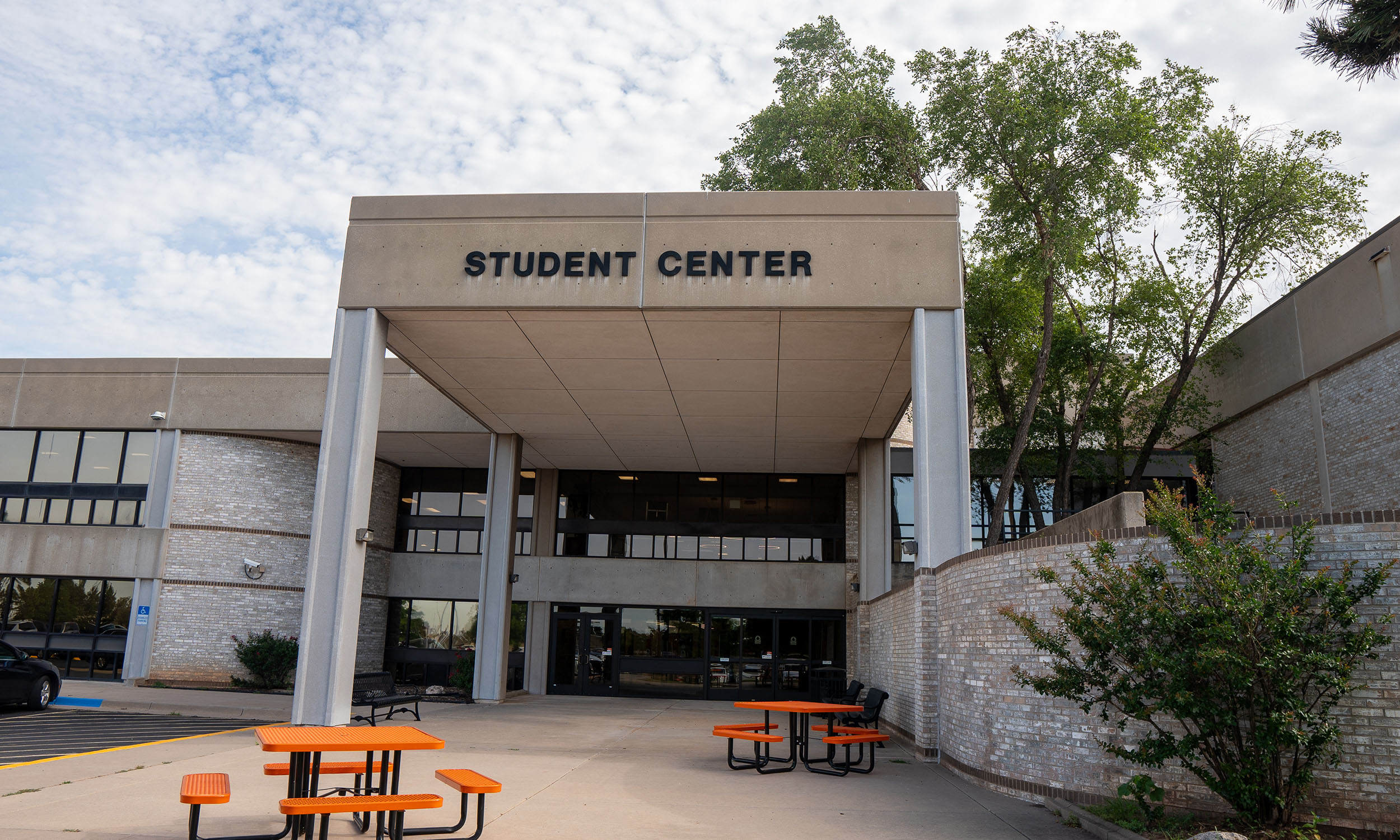
The Student Center at Oklahoma State University-Oklahoma City is a vibrant hub for student life and activities on campus.
This facility provides a welcoming space for students to gather, study and participate in various events and programs. It houses essential student services, including the campus bookstore, dining options and recreational areas, ensuring students have access to everything they need for a well-rounded college experience. The Student Center also hosts a variety of student organizations and clubs, fostering a sense of community and engagement among the student body.
This building reflects OSU-OKC's commitment to creating a supportive and dynamic environment for its students.
Student Farm (OSU-Stillwater)
The OSU Student Farm is an innovative project at Oklahoma State University that serves as an outdoor classroom with a mission to feed the community sustainably.
Located west of campus on Highway 51, the farm was established to provide students with hands-on experience in agricultural production while addressing local food insecurity. Originally built in 1920 as the swine barn, the farm grows various fruits and vegetables, including broccoli, spinach, lettuce, onions, and more, which are delivered to Our Daily Bread Food and Resource Center in Stillwater.
The Student Farm also utilizes buried irrigation to prevent water waste and plans to expand its operations to include additional fields and renovated facilities. This initiative aligns with OSU's focus on the One Health initiative, promoting a healthy lifestyle and contributing to the university's efforts to address the United Nations' Sustainable Development Goal of Zero Hunger.
Student Organizations
Oklahoma State University offers students a chance to join organizations, including academic, cultural, faith-based, Panhellenic, professional, athletic and more.
For a complete list of student organizations, visit the Student Involvement website.
Student Union (OSUIT)
The Student Union at the Oklahoma State University Institute of Technology serves as the central hub for student life and activities on campus.
Built in 1990, this vibrant facility offers a variety of services and amenities, including dining options, meeting rooms and recreational spaces, designed to enhance the student experience. Located off of 1st Street, the Student Union is a place where students can gather, socialize and participate in a wide range of events and programs, fostering a sense of community and engagement.
It plays a crucial role in supporting the academic and social needs of the OSUIT student body.
Student Union (OSU-Stillwater)
The Oklahoma State University Student Union, established in 1950, is a central hub for student life on the Stillwater campus.
Spanning over 600,000 square feet, it offers various services and amenities, including dining options, a bookstore, meeting and conference facilities, and spaces for relaxation and study. The union also houses the OSU Esports Arena and numerous student organizations, fostering a vibrant community atmosphere.
It is a place where students, staff and alumni come together to socialize, learn, and engage in campus activities.
Thatcher Hall (OSU-Stillwater)
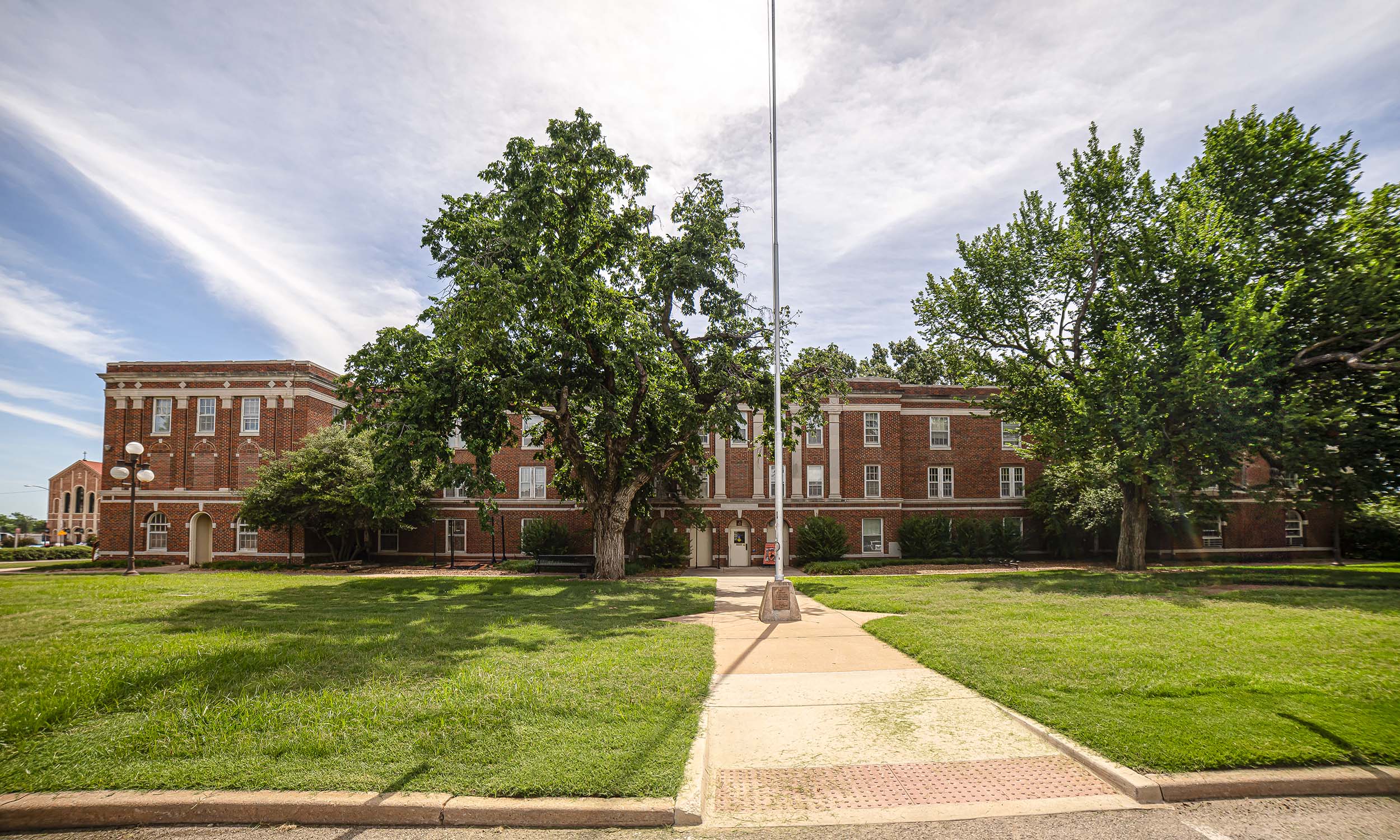
Thatcher Hall at Oklahoma State University was opened in 1925 as a women-only residence hall and is named after Jessie Olive Thatcher Bost (Dec. 16, 1875-Feb. 14, 1963), the first female graduate of OSU.
Today, Thatcher Hall is the ROTC program's home and houses various administration offices. The hall's front lawn features a Korean War-era RF-84F fighter-bomber replica, highlighting the Air Force's addition to ROTC in 1946.
The building has a rich history and continues to play a significant role in the university's military science and leadership training programs.
Theta Pond (OSU-Stillwater)
Theta Pond is one of Oklahoma State University's most iconic and beloved landmarks.
Initially built in 1895 and known as Horse Pond, it provided water for the horses and livestock housed nearby. The pond was later renamed Theta Pond after the Kappa Alpha Theta sorority, which was located across what was then College Avenue. Over the years, Theta Pond has undergone numerous renovations, including expansions, lighting and landscaping, making it a picturesque spot for relaxation, photography and university traditions.
The pond is surrounded by stunning bald cypress trees, which provide shade and create a habitat for various animals, including ducks and geese. Theta Pond continues to be a central part of campus life, offering a tranquil setting for students, faculty and visitors to enjoy.
Totusek Arena (OSU-Stillwater)
Totusek Arena at Oklahoma State University is a state-of-the-art facility within the Ferguson College of Agriculture. Spanning 46,318 square feet, the arena features a 92-by-192-foot arena floor with adjacent chairback seating for 779 people, excellent animal working areas, office and kitchen space, and a 1,675-square-foot classroom.
Renamed on April 11, 2015, to honor the late Dr. Robert “Bob” Totusek (Nov. 3, 1926-June 6, 2014), who fostered a culture of excellence in the department for over 60 years, the arena continues to support OSU's three-fold land grant mission.
Built in 1986, it is used for teaching, training judging teams and hosting various OSU events, making it an essential part of the university's agricultural education and community engagement.
Track and Field Complex (OSU-Stillwater)
The Oklahoma State University Track and Field Complex, opened on Aug. 17, 2013, is a state-of-the-art facility designed to meet the precise specifications set by the National Collegiate Athletic Association.
Located on the northeast corner of the OSU Athletic Village, the complex features berm seating and a modern locker room facility. This facility has provided the Cowboys and Cowgirls with an edge in their athletic pursuits, supporting training and competitive events.
The complex is a testament to OSU's commitment to excellence in athletics and provides a premier venue for track and field activities.
Tulsa
Tulsa, Oklahoma, is the second-most-populous city in the state, with a population of 413,066 as of the 2020 census.
Known for its rich history and vibrant cultural scene, Tulsa serves as the county seat of Tulsa County. It is a principal municipality in the Tulsa metropolitan area, with over 1 million residents. The city has various attractions, including world-class museums, parks, and entertainment venues. Tulsa's economy is driven by sectors such as energy, finance, aviation, and technology, making it a dynamic and thriving urban center.
North Tulsa is a vibrant and diverse area known for its rich cultural heritage and strong community spirit. It is home to a significant portion of Tulsa's African-American population. It features a variety of locally owned businesses, including Fulton Street Books & Coffee and The Outsiders House Museum. The area also boasts important landmarks such as the Gilcrease Museum, Tulsa International Airport and Mohawk Park, one of the nation's largest municipal parks.
Tulsa was first settled by the Lochapoka (Turtle Clan) Muscogee (Creek) between 1828 and 1836. The Lochapokas, led by their chief, Achee Yahola, established a new home near present-day Cheyenne Avenue and 18th Street. They named their new settlement "Tulasi," meaning "old town" in their native language.
Note: Although the AP style prefers to lowercase regions within cities, North Tulsa is an exception.
Unmanned Aircraft Flight Station (OSU-Stillwater)
The Unmanned Aircraft Flight Station at Oklahoma State University is a dedicated facility for testing and developing unmanned aerial systems.
Located on 4015 N Clay Road near Stillwater, the UAFS features a runway and hangar, providing a controlled environment for advanced research and flight testing. The station supports various research activities, including counter-UAS solutions, agricultural monitoring and emergency response applications.
It is part of the Oklahoma Aerospace Institute for Research and Education and is crucial in advancing UAS technology and fostering innovation in the aerospace industry.
University Assessment and Testing
University Assessment and Testing at Oklahoma State University is crucial in enhancing the academic experience by providing comprehensive assessment services and resources.
The building was constructed in 2005. This department assists in conducting surveys to gather valuable insights from students, faculty and alumni. Additionally, it supports various academic programs and initiatives by offering testing services, including placement exams and employee well-being surveys.
The feedback collected through these assessments is used to improve university services, programs, and overall student experience.
University Commons (OSU-Stillwater)
University Commons is a student residential complex on Oklahoma State University’s main campus, designed to meet the growing student housing needs.
Opened in 2015, this $65 million, three-building community is located along Hall of Fame Avenue, northeast of the Colvin Recreation Center. The complex houses 964 students in three residence halls with an adapted traditional layout, offering amenities such as community kitchens, free laundry facilities, resident lounges and outdoor gathering areas.
University Commons provides a modern and convenient living experience, fostering a sense of community among students.
University Dining Services
University Dining Services at Oklahoma State University is the official dining operation that provides diverse food options across the campus.
Its headquartered at the corner of Hall of Fame Avenue and Western Road in the Central Dining Services Building, which was built in 1969. With nearly 30 self-operated dining concepts and nationally recognizable franchises, students, faculty and staff have access to various dining choices.
University Dining Services is committed to enhancing the overall campus experience by meeting dietary needs, providing nutrition resources, and supporting campus events and catering services.
University Health Services (OSU-Stillwater)
University Health Services at Oklahoma State University provides comprehensive medical care to ensure the well-being of the university community.
Located at 1202 W Farm Road, UHS specializes in college health and offers a wide variety of general medicine services to students, faculty and staff. The building was constructed in 1974. The clinic operates Monday through Friday from 8 a.m. to 5 p.m., and is dedicated to providing exceptional care, promoting preventative education, and supporting students' academic success.
UHS also collaborates across the university community to enhance student experience and cultivate an inclusive environment.
University Laundry (OSU-Stillwater)
The University Laundry at Oklahoma State University is conveniently located at the corner of McElroy Road and Walnut Street.
This facility provides laundry services to students residing in various on-campus housing options, ensuring they have access to clean and well-maintained laundry amenities. Originally opened in 1967, the University Laundry is equipped with modern washers and dryers, and access is controlled via OSU identification card swipe, ensuring that only authorized users can utilize the facilities.
This service is part of OSU's commitment to providing a comfortable and convenient living environment for its students.
University Store
The University Store at Oklahoma State University is a comprehensive retail outlet in the Student Union, offering a wide range of products, including textbooks, school supplies, OSU-branded apparel, gifts and technology items.
Owned and operated by the university, the store ensures that 100% of the proceeds benefit OSU and its students, helping to fund various student programs and services while keeping student fees to a minimum.
The store also provides convenient services such as in-store pickup, free delivery to OSU-Tulsa, custom doctoral regalia fittings and exclusive discounts for faculty and staff during special sales events.
Veterans Memorial (OSUIT)
The Veterans Memorial at the Oklahoma State University Institute of Technology is a tribute to the rich military heritage of the campus, which once served as a military hospital for World War II veterans.
Dedicated on Veterans Day, Nov. 11, 2014, the memorial honors the service and sacrifice of veterans and active military members. The dedication ceremony included a parade, flag ceremony, and remarks from then OSUIT President Bill R. Path, followed by a reception.
The memorial stands as a symbol of OSUIT's ongoing commitment to supporting veterans and their families, providing a place of reflection and gratitude for the entire campus community.
Veterinary Medical Teaching Hospital, David L. Boren (OSU-Stillwater)
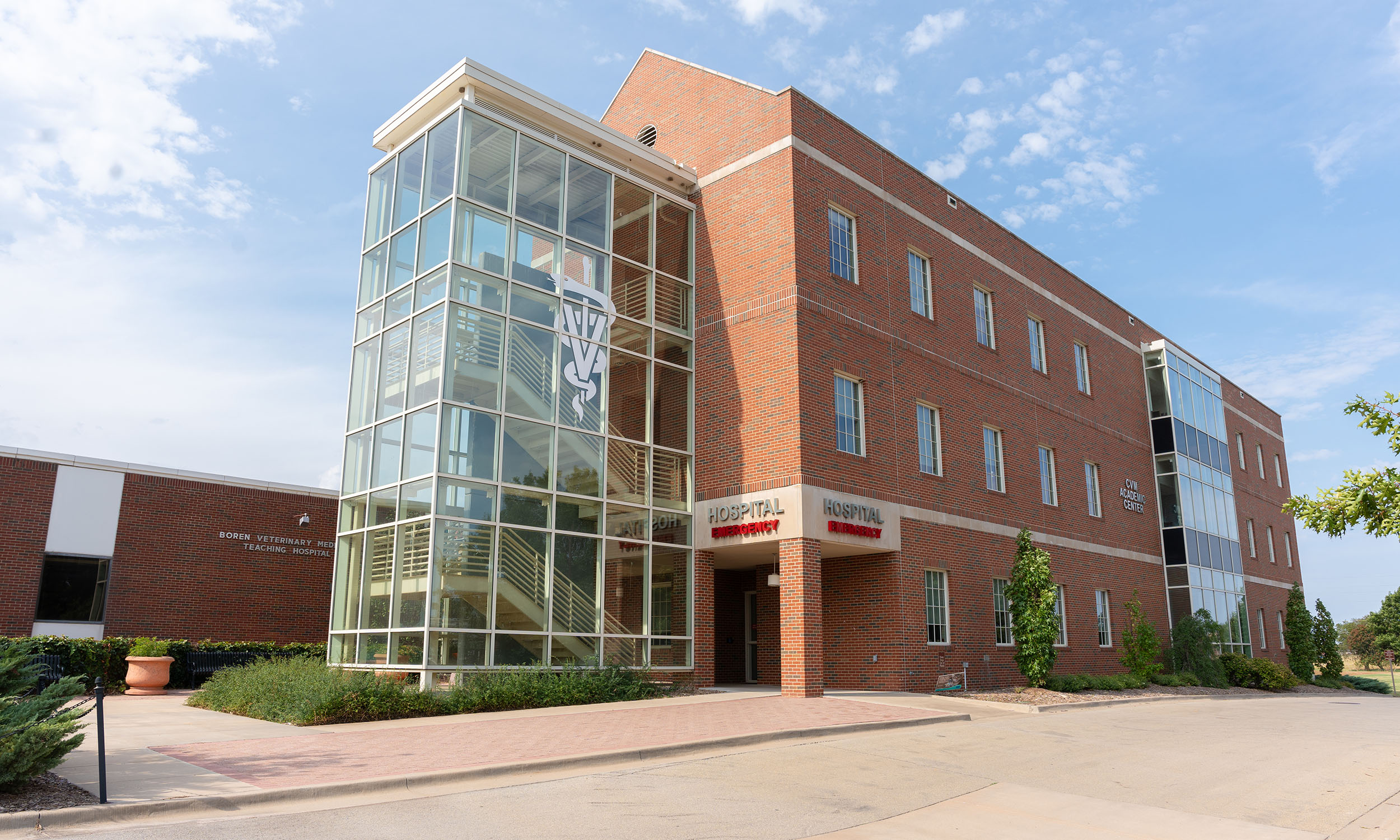
The David L. Boren Veterinary Medicine Teaching Hospital at Oklahoma State University is a premier facility that provides comprehensive veterinary care and education.
Located at 2065 W. Farm Road, the hospital offers a wide range of services for both small and large animals, including emergency and critical care, routine check-ups, and specialized treatments. Opened in March 1981, the hospital is part of the College of Veterinary Medicine. It works closely with the Oklahoma Animal Disease Diagnostic Laboratory and other affiliated programs to ensure the highest animal care and veterinary education standards.
The facility is named in honor of former Oklahoma Gov. David Lyle Boren (April 21, 1941-Feb. 20, 2025), reflecting his significant contributions to the university and the field of veterinary medicine. The hospital is open to the public and is a vital resource for the region's pet owners and livestock producers.
Veterinary Medicine (College of)
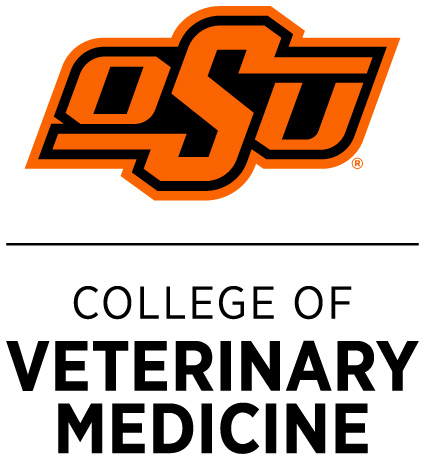
The College of Veterinary Medicine at Oklahoma State University is the only veterinary college in the state and one of just 33 nationwide.
It provides a comprehensive education in veterinary medicine, preparing students for a lifetime of investigation, innovation, care and protection of animal health. The college offers a Doctor of Veterinary Medicine program, as well as graduate programs in veterinary biomedical sciences.
Students gain hands-on experience through the Veterinary Medical Teaching Hospital and the Oklahoma Animal Disease Diagnostic Laboratory, ensuring they are career-ready upon graduation.
The official magazine of CVM is Vet Cetera.
The college houses the following three departments:
- Department of Physiological Sciences
- Department of Veterinary Clinical Sciences
- Department of Veterinary Pathobiology
Vice President for Research
The Vice President for Research at Oklahoma State University is the senior executive dedicated to advancing the university's research mission by fostering a collaborative and innovative research environment.
This role oversees various research initiatives, compliance and funding opportunities, ensuring that OSU remains at the forefront of scientific discovery and technological advancement. The VPR supports faculty, staff and students in their research endeavors, providing resources and guidance to enhance the impact of their work.
Additionally, their office is crucial in building partnerships with industry, government, and other academic institutions to drive research that addresses societal challenges and contributes to economic development.
The official magazine of OSU Research is Research Matters.
FIRST REFERENCE: Use full name "Vice President for Research."
SECOND REFERENCE: For all subsequent references, it is acceptable to use the term "VPR."
Vice President for Student Affairs
The Vice President for Student Affairs at Oklahoma State University is the senior executive responsible for overseeing all non-academic aspects of student life for both undergraduate and graduate students.
This role involves managing various services and programs designed to support student success, including housing, dining, health services, counseling and student activities. The Vice President for Student Affairs works closely with other university departments to create a supportive and inclusive campus environment that fosters personal development, leadership and community engagement.
These departments are part of the Vice President for Student Affairs’ purview:
- Accessibility Services
- Campus Life
- Career Services
- Counseling Services
- Dining Services
- Hargis Leadership Institute
- Health Services
- Housing and Residential Life
- Student Support
- Student Conduct
- Student Union
- Wellness
Villages
The Villages at Oklahoma State University are a collection of residential halls designed to provide students with a comfortable and engaging living environment.
Located on the east side of the Village Neighborhood, these halls offer a variety of room configurations, including one-bedroom and two-bedroom suites, each equipped with modern amenities such as central heating and air conditioning, built-in closets and private bathrooms.
Built in 2006, The Villages also feature community kitchens, laundry facilities, and common areas on every floor, fostering a sense of community and promoting student interaction.
With their convenient location near the Colvin Recreation Center and the University Health Center, The Villages provide an ideal living space for students seeking both convenience and a vibrant campus life.
Visual Arts Annex (OSU-Stillwater)
The Visual Arts Annex at Oklahoma State University is a versatile facility that supports a wide range of artistic disciplines.
It was opened in 2002. Located at 1985 West McElroy Road in Stillwater, the annex houses studios for ceramics, sculpture, printmaking and visual thinking courses. The ceramics studio is equipped for wheel throwing and hand-building techniques, featuring multiple gas and electric kilns. The sculpture facilities include an assembly/mold making and casting studio, a wood shop, a metal fabrication studio with a CNC plasma cutter, and a metal casting foundry for bronze and aluminum.
The printmaking shop facilitates the creation of lithographs, intaglio and relief prints. Additionally, the Visual Thinking classroom has 3D printers, a laser cutter and computers with supportive software. The courtyard and surrounding grounds are used for student experiments in public art and outdoor construction.
Wentz Hall (OSU-Stillwater)
Wentz Hall at Oklahoma State University is a traditional residence hall located centrally on the Stillwater campus.
Part of the Scott-Parker-Wentz Triplex, it offers convenient access to several dining options, such as the Colvin Recreation Center and University Health Services. Built in 1964, Wentz Hall features nine floors and accommodates approximately 550 residents in traditional-style rooms. Each room has essential amenities, including a bed frame and mattress, desk, dresser and built-in closet.
The hall is named after educational philanthropist Lewis “Lew” Haines Wentz (Nov. 10, 1877-June 9, 1949) and provides a comfortable living environment with community bathrooms, kitchens and common areas. Wentz Hall is known for its vibrant community and proximity to key campus locations.
Wentz Lane Parking Garage (OSU-Stillwater)
The Wentz Lane Parking Garage at Oklahoma State University is a multi-level parking facility designed to accommodate the parking needs of students, faculty and staff.
Constructed of precast concrete structural double-Ts and panels, the garage has parking for 645 cars on four levels, including the roof.
The garage is named after educational philanthropist Lewis “Lew” Haines Wentz (Nov. 10, 1877-June 9, 1949) and is conveniently located near key campus buildings and offers a secure and efficient parking solution for the OSU community.
Wes Watkins Center for International Trade Development (OSU-Stillwater)
The Wes Watkins Center for International Trade Development at Oklahoma State University is a state-of-the-art facility dedicated to enhancing Oklahoma's global competitiveness through teaching, research and public service.
Named after former U.S. Congressman Wesley Wade Watkins (Dec. 15, 1938-March 26, 2025), who significantly impacted the state's development, particularly in education and international trade. Watkins was known for his dedication to public service and his efforts to promote economic growth in Oklahoma. The center was founded in 1990 and serves as a hub for international activities on the OSU campus.
It houses OSU Global, the English Language and Intercultural Center and offers various programs and services, including export and trade advisory services, to promote economic development in the state. The center also provides opportunities for students to engage in global business and trade.
West Apartments (OSU-Stillwater)
The West Apartments at Oklahoma State University, located in the West Neighborhood, offer furnished, two-bedroom/one-bathroom units for students who qualify for year-round housing registration, including families and graduate students.
Built in 1964, these two-story buildings provide ample parking and open green spaces, and are conveniently situated near the Family Resource Center and University Laundry on McElroy Road.
They are named after Leonard Lee (March 27, 1880-1943) and Martha Ann “Mattie” West (Aug. 7, 1883-Feb. 16, 1950), the first residents of what was then called Veteran's Village, moving into trailer number 9 Osage on Jan. 28, 1946. Leonard, a native of Hydro, Oklahoma, was a student in the School of Commerce and later took on various civic roles within the Village.
The monthly rate includes utility bills such as electric, gas, water, sewer, trash/recycling, internet, Wi-Fi and cable television, along with free use of laundry facilities. The West Apartments are designed to provide a comfortable and convenient living environment for students, with easy access to key campus locations and amenities.
Whitehurst Hall (OSU-Stillwater)
Whitehurst Hall at Oklahoma State University is an administrative building on the Stillwater campus.
Built in 1926, it was named after John A. Whitehurst (1868-March 22, 1930), who served as the Oklahoma Board of Agriculture president from 1918-26. He brought stability to the campus in the 1920s and secured funds for many major OSU structures as board president. The building originally housed the office for OSU President Henry G. Bennett, his staff, the library, and various departments of the agricultural school.
Over the years, Whitehurst Hall has undergone several renovations, including adding a fourth floor in 1936. Today, it serves as a central hub for administrative functions and is home to the Office of the President and other key university offices.
Willham, Oliver Siralvo
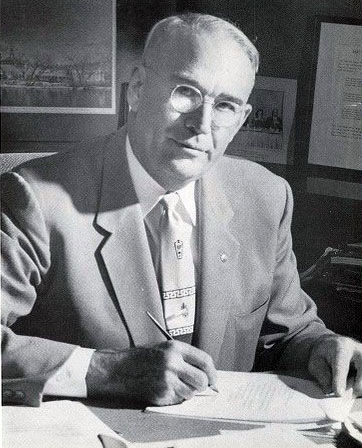 Dr. Oliver Siralvo Willham (June 26, 1901-Sept. 29, 1974) served as the 12th president
of Oklahoma State University from 1952-66.
Dr. Oliver Siralvo Willham (June 26, 1901-Sept. 29, 1974) served as the 12th president
of Oklahoma State University from 1952-66.
He was the first graduate of the university to become its president and had the second-longest tenure at that time. During his presidency, Willham oversaw significant growth and development, including the transition from Oklahoma A&M College to Oklahoma State University, the creation of the OSU Foundation, and the completion of 19 new buildings.
He was known for his personal connection with students and faculty, often calling them by name and taking a genuine interest in their lives. He presided over commencement in his 14 years and signed every diploma. At his last, he gave the commencement address and said, "True happiness can only be had when we use our talents and knowledge to serve others."
Willham's leadership left a lasting impact on the university, fostering a sense of community and progress.
He died on Sept. 29, 1974, after a long bout with cancer. He was 73.
Willard Hall (OSU-Stillwater)
Willard Hall at Oklahoma State University is a historic building that has undergone significant renovations to become a state-of-the-art educational center for the College of Education and Human Sciences.
Located on the Stillwater campus, Willard Hall provides various rooms and spaces for university classes, academic departments, staff, faculty and student organizations. The building has modern facilities and is primarily used for accommodating university classes, lectures, receptions, and special meetings.
Willard Hall holds a special place in the university's history, having been saved and transformed through a $9.8 million renovation funded by the 1992 higher education bond issue.
It is named after Frances E. Willard (Sept. 28, 1839-Feb. 17, 1898), a prominent feminist and temperance leader. The building was originally constructed in the 1930s through the government's Works Progress Administration and was first used as a women's dormitory.
Willard Sparks Beef Research Center (OSU-Stillwater)
The Willard Sparks Beef Research Center at Oklahoma State University is a premier facility dedicated to advancing the science and practice of beef cattle production.
Located in Stillwater, the center focuses on research in areas such as nutrition, genetics and management practices to improve the efficiency and sustainability of beef production. The center is named after Willard R. Sparks (Oct. 10, 1936-Jan. 3, 2005), a prominent figure in the agricultural industry, and serves as a hub for collaboration between researchers, students and industry professionals.
Built in 1999, the facility includes state-of-the-art laboratories, animal handling facilities and pastures for conducting comprehensive research and educational programs.
Williams Apartments (OSU-Stillwater)
Williams Apartments at Oklahoma State University are part of the Williams Neighborhood, offering unfurnished, two-bedroom/one-bathroom units for students who qualify for year-round housing registration, including families and graduate students.
Undergraduates with nine-month, academic leases may also be assigned here. The neighborhood consists of two building styles: Williams 12-15, built in 1957, are one-story buildings, while Williams 101-105, built in 1962, are two-story buildings. Located near the garden plots, the neighborhood provides ample off-street parking and open green spaces for residents to enjoy.
They are named after Richard Martell Williams (July 31, 1919-July 12, 2008), a 1941 graduate of Oklahoma A&M College and Air Force veteran, who became director of Married Student Housing and Student Services Maintenance in July 1967 after John A. Stevens’ retirement. Williams led the transition from temporary post-war housing to permanent brick apartments.
The monthly rate includes utility bills such as electric, gas, water, sewer, trash/recycling, internet, Wi-Fi and cable television, along with free use of laundry facilities. Williams Apartments offer students a comfortable and convenient living environment, with easy access to key campus locations and amenities.
Willis Fields (OSU-Stillwater)
Willis Fields at Oklahoma State University is located at the northwest corner of McElroy Road and Willis Street in Stillwater.
These fields are part of the university's intramural sports facilities and are used for various recreational activities, including soccer and other field sports. The fields are divided into east and west sections, providing ample space for multiple games and events simultaneously.
Willis Fields is essential to the campus's recreational infrastructure, offering students a place to engage in physical activities and promote a healthy lifestyle.
Wilson, George
 George Wilson (Sept. 14, 1870-Jan. 31, 1925) served as the ninth president of Oklahoma
Agricultural and Mechanical College (now Oklahoma State University) for a brief period
in 1923.
George Wilson (Sept. 14, 1870-Jan. 31, 1925) served as the ninth president of Oklahoma
Agricultural and Mechanical College (now Oklahoma State University) for a brief period
in 1923.
His tenure was marked by controversy, as he was installed by Gov. Jack C. Walton, who had the Oklahoma National Guard remove the previous president, James B. Eskridge. Despite the tumultuous circumstances of his appointment, Wilson's presidency was short-lived, lasting only from June to July 1923.
His time in office was characterized by significant student protests and opposition to his appointment. He died in 1925 at age 54.
Wilson Commons (OSUIT)
Wilson Commons at the Oklahoma State University Institute of Technology is a vibrant student hub that features recreational amenities such as pool and ping-pong tables, TV lounges and high-speed internet.
This area also includes an on-site convenience store offering made-to-order pizzas, sandwiches and more, making it a popular spot for students to relax and socialize.
Built in 2001, Wilson Commons enhanced the beauty and functionality of the area between the Miller-Kamm North and South residence halls.
Young Hall (OSU-Stillwater)
Young Hall at Oklahoma State University is a three-story residential building located next to the Griffith Community Center in the North Monroe Neighborhood.
It offers apartment-style living with two private bedrooms, two private bathrooms, a living room, a full-size kitchen, and an in-unit washer and dryer. The hall is conveniently near dining options such as Adams Market and North Dining. It is within walking distance of key campus locations like Boone Pickens Stadium and the Colvin Recreation Center. Each unit is furnished with essential amenities, including a bed frame and mattress, desk, dresser, and kitchen appliances. Built in 2001, Young Hall offers additional services like 24-hour maintenance and access to the Griffith Community Center's recreational facilities.
It is named after Dr. Raymond Alfred Young (March 10, 1904-March 23, 2002), a distinguished alumnus from the class of 1967 and a notable business leader who partnered with Rawdon E. Tomlinson and Enoch L. Gosselin to open TG&Y department stores.
Zink-Allen Halls (OSU-Stillwater)
Zink-Allen Halls at Oklahoma State University are connected buildings located near the University Commons and part of the North Monroe Neighborhood.
Built in 2001, these halls offer deluxe-suite style living with two different floor plans, accommodating approximately 160 residents. Each unit features two shared or four private bedrooms, a living room, kitchenette and two bathrooms. The halls are coed, but individual units are same-gender. Amenities include free laundry facilities, community kitchens, and study and recreational spaces.
Named after OSU alumni and business leaders John Smith Zink (Oct. 17, 1928-Feb. 5, 2005) and Walter Wayne Allen (Oct. 13, 1936-April 8, 2022), Zink-Allen Halls provide a comfortable and convenient living environment for students, with close proximity to dining options and OSU bus routes.
